






12 When Books Can Speak: A Glimpse into the World of Sefarim Collecting By Eli Genauer
16 A Passion for Rare Sefarim: Q & A with Rabbi Eliezer Katzman By Bayla Sheva Brenner
22 People of the Book: Five Hundred Years of the Hebrew Book From the Beginning of Printing Until the Twentieth Century By Akiva Aaronson Reviewed by Gil Student
24 When Leaders Fail Healing from Rabbinic Scandal By Yitzchak Breitowitz
44 Rabbis at Risk: What Can Be Done? By Barbara Bensoussan
50 Halachah and the Fallen Rabbi Q & A with Rabbi Hershel Schachter By Avrohom Gordimer
54 The Pioneers of Gush Katif— Ten Years After the Disengagement Section written and translated by Toby Klein Greenwald
58 Healing in the Aftermath of Trauma: Livnat Farjun
60 From “House of Faith” to Building the Negev: Yedidya Harush
64 A Child of Gush Katif: Yael (Cohen) Haramati
66 The Miracle Worker Behind JobKatif: Rabbi Yosef Zvi Rimon
68 On and Off the Beaten Track in the Gush Katif Museum By Peter Abelow
To Sleep, Perchance to Dream By Shira Isenberg
Meatless Meals During the Nine Days By Norene Gilletz
88 Torah MiEtzion: New Readings in Tanach–Bemidbar Edited by Rav Ezra Bick and Rav Yaakov Beasley Reviewed by Francis Nataf BOOKS
90 To Fill the Sky with Stars: Women Explore Their Midlife Challenges and Triumphs Edited by Miriam Liebermann Reviewed by Yael Zoldan
or Outreach: The Perennial Dilemma By Martin Nachimson
Cover design: Josh Weinberg
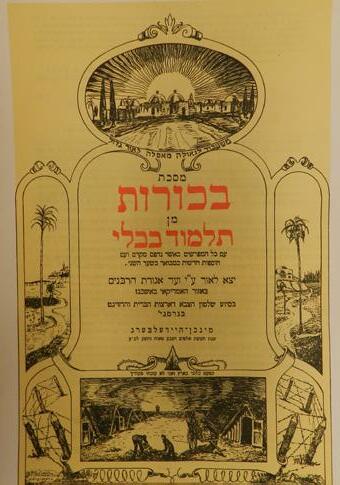

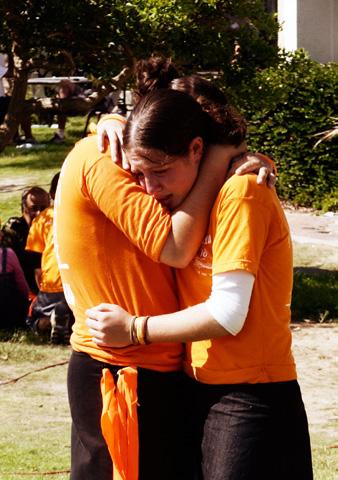
What’s the Truth About A Woman Bentching Gomel? By Ari Z. Zivotofsky
Making Tishah B’Av Personal By Steve Lipman

Jewish Action seeks to provide a forum for a diversity of legitimate opinions within the spectrum of Orthodox Judaism. Therefore, opinions expressed do not necessarily reflect the policy or opinion of the Orthodox Union.
g Alan Krinsky’s article on davening properly (“Pray or Play?,” winter 2014) is wonderful.
Too many of us are concerned with finding the “fastest minyan in town.” We are casual with our tefillot and, for many of us, davening is viewed as a tedious experience.
Rav Gedaliah Eisemann, the late mashgiach of Yeshivas Kol Torah in Yerushalayim, once said: “I’ve seen a lot of eccentric people, but I never saw any of them daydreaming while reading a newspaper. Why? Because they find it interesting. We have to make our davening and learning interesting by keeping it fresh and engaging!”
Extending Krinsky’s sports team metaphor, what about having a “coach’s” inspirational speech before each “game”? Shul rabbis should offer a brief and relevant message or insight before davening—twenty to thirty seconds long. This should be done before and even during davening.
BORUCH LEFF
Baltimore, Maryland
g While I enjoyed Bayla Sheva Brenner’s article about Jewish genealogy (“Jewish Genealogy: The Journey to Oneself,” winter 2014), I found it to be too focused on the Ashkenazic American experience. With the exception of one woman of Syrian descent, all of the vignettes Brenner shares are of descendants of European Jews seeking to bridge the gap from the old world to the new. The web site she recommends, JewishGen, does not even offer a search option for countries outside of Eastern Europe. The fascinating journey of the many diverse Sephardic communities, including anusim (those
forced to convert) and communities scattered after the Inquisition, merit attention as well.
REBECCA DREISINGER
New York, New York
g I appreciated Bayla Sheva Brenner’s article on Jewish genealogy, having experienced similar exhilaration when conducting my own family research. I’ve worked for several years teaching genealogy as a supplement to limudei kodesh classes, and students love the class and the journey of discovery. Our L’dor Vador class also helps my students contextualize everything else they learn, making it that much more meaningful. I encourage all Jewish day schools to incorporate genealogy into their curricula.
JEFFREY SCHRAGER
L'dor Vador Educational Services
Dallas, Texas
Holding the Arba Minim
g When I receive my Jewish Action, the first place I flip to is Rabbi Ari Z. Zivotofsky’s column. I enjoy the selection of topics and the accurate references. However, I think that the article, “What’s the Truth About . . . the Arba Minim?” (fall 2014) is misleading in its conclusion.
In the Mishnah Berurah 651:11, the Mechaber uses the word “l’chaber” when referring to holding the lulav to the etrog during the na’anuim. The Mishnah Berurah brings the story of Rabbi Menahem Recanati, which Rabbi Zivotofsky mentions. However, Rabbi Zivotofsky does not recount the story accurately. Rabbi Recanati points out that the day following his dream [which he interpreted as referring to the arba minim], he observed a Jew waving a lulav without the etrog, and he understood that all four species must
THE MAGAZINE OF THE ORTHODOX UNION www.ou.org/jewish_action
Editor in Chief Nechama Carmel carmeln@ou.org
Assistant Editor Rashel Zywica
Literary Editor Emeritus Matis Greenblatt
Book Editor
Rabbi Gil Student
Contributing Editors
Rabbi Yitzchok Adlerstein • Dr. Judith Bleich
Rabbi Emanuel Feldman • Rabbi Hillel Goldberg
Rabbi Sol Roth • Rabbi Jacob J. Schacter
Rabbi Berel Wein
Editorial Committee
Rabbi David Bashevkin • Rabbi Binyamin Ehrenkranz
Mayer Fertig • Rabbi Avrohom Gordimer • David Olivestone
• Gerald M. Schreck • Rabbi Gil Student •
Rabbi Dr. Tzvi Hersh Weinreb
Director, Design & Branding Carrie Beylus
Design Deena Katzenstein
Advertising Sales
Joseph Jacobs Advertising • 212.787.9400 arosenfeld@josephjacobs.org
Subscriptions 212.613.8146
ORTHODOX UNION
Executive Vice President/Chief Professional Officer Allen I. Fagin
Executive Vice President, Emeritus
Rabbi Dr. Tzvi Hersh Weinreb
Senior Managing Director
Rabbi Steven Weil
Chief Communications Officer Mayer Fertig
Chief Financial Officer/Chief Administrative Officer
Shlomo Schwartz
Chief Human Resources Officer Lenny Bessler
Chief Information Officer
Samuel Davidovics
President Martin Nachimson
Chairman of the Board
Howard Tzvi Friedman
Vice Chairman of the Board
Mordecai D. Katz
Chairman, Board of Governors
Henry Rothman
Vice Chairman, Board of Governors
Gerald M. Schreck
Jewish Action Committee
Gerald M. Schreck, Chairman
Joel M. Schreiber, Chairman Emeritus
©Copyright 2015 by the Orthodox Union. Eleven Broadway, New York, NY, 10004. Telephone 212.563.4000 • www.ou.org.
be held together; he does not note that there must be a slight space between the lulav and etrog.
Furthermore, Rabbi Shlomo Ganzfried, in the Kitzur Shulchan Aruch, says, “We turn the etrog over and holding it close to the lulav, with no separation between them, we wave them towards the four points.” Rabbi Ganzfried states, “shelo yehiyeh peirud beineihem.” He mentions this twice in this paragraph. Therefore, it seems to me, as I’ve observed since childhood, that one should have the etrog touch the spine of the lulav while holding them with both hands and waving the lulav.
Atlanta, Georgia
g I thank Rabbi Israel Robinson for his letter. In my article, I did cite a story regarding a dream of Rabbi Menahem Recanati. Rabbi Robinson is correct that my presentation of the story was imprecise, and in the story, as cited by the Taz, Be’er Hateiv and others, the guest, in fact, did not have an etrog at all.
In the article, I also quoted an idea attributed to the first Belzer Rebbe that when bringing the etrog in the left hand near the lulav in the right hand, a slight space should be left between them. Rabbi Robinson, while agreeing with the main premise of my article that the etrog and lulav should be in separate hands, suggests that the idea of leaving a space is specious and that the etrog should, in fact, touch the lulav
Permit me to elaborate on this specific point, which was addressed in a more limited manner in the original article. The Shulchan Aruch (OC 651:11) instructs one to “join the etrog to the lulav” (“lechaber”). He does not explicitly comment on whether they should touch or if there should be a space between them.
The Mishnah Berurah (651:48) simply reiterates the Shulchan Aruch’s instructions that the etrog should be “mechubar” to the lulav, without elaborating. The Kitzur Shulchan Aruch (137:1) twice says to bring the etrog near the lulav (“mekarvo”) so that there should not be a separation between them (“peirud beineihem”).
The Aruch Hashulchan (651:9) says that the two hands should be brought near each other for the purpose of joining the etrog with the other three species and, God forbid (“chalilah”), that they should be separated from each other. The Chayei Adam (148:7) writes similarly. It seems to me that the language used in all of these sources is ambiguous regarding whether the lulav and etrog have to actually touch. I think the import of the rulings is that in light of the fact that the etrog and lulav are in different hands, one can potentially hold them far apart, and thus these sources instruct that they should be held near one another. None of these sources explicitly state whether or not they should touch. On the other hand, the idea that I mentioned in my article, that they should be close but have a small space between them, is, as cited in my footnote, from the Kuntras Ha’Acharon (Ta’amei Haminhagim, sec. 792, p. 347). He states this explicitly, based on the Bel-


Meet Zvi Goldstein, a current MTA High School senior enrolling in Yeshiva University. Zvi is coming to Yeshiva University for the countless opportunities to engage with top Roshei Yeshiva and world-renowned faculty. With 150 student clubs, 16 NCAA sports teams and hundreds of activities, lectures and events throughout campus, YU has something for everyone.
Picture yourself at YU. #NowhereButHere


zer Rebbe. In contrast, the Kaf HaChaim (OC 651:106) quotes the Radvaz as saying that he was careful not to let his fingers separate between the lulav and etrog. Minhag Yisrael Torah (651:18) quotes opinions that the etrog should be touching the aravot, which are on the left side, or alternatively, that it should actually touch the lulav.
In summary, one fulfills his obligation whether the arba minim touch or are merely close to each other and both approaches have support in the sources.
g Professor Nathan Aviezer mentions three people in his article “Replying to Richard Dawkins” (spring 2015): Dawkins, Krauss and Hawking. All argue that science has eliminated a Creator. While the science involved is quite sophisticated, the arguments against a Creator are, in many respects, quite primitive, as we can see from the straightforward explanations provided by Professor Aviezer. (More detailed arguments are available in the literature.)
One might characterize Dawkins as a scientist, evolutionist, atheist and enemy of religion. He not only argues that religious belief is wrong, as would any atheist, but also that religious belief is an evil that needs to be eradicated.
[Religious] morality demands the presence of a great gulf between Homo sapiens and the rest of the animal kingdom. Such a gulf is fundamentally anti-evolutionary. The sudden injection of an immortal soul in the timeline is an anti-evolutionary intrusion into the domain of science . . . . You can kill adult animals for meat, but abortion and euthanasia are murder because human life is involved . . . . I think a case can be made that faith is one of the world’s great evils, comparable to the smallpox virus but harder to eradicate (Richard Dawkins, “When Religion Steps on Science’s Turf; The Improbability of God,” The Free Inquiry Magazine 18 [1998]).
And why is religion and faith so terrible? Because it values human life over other forms of life. The essential issue for Dawkins is the “sudden injection of an immortal soul,” without which humans are just another version of animals. Hence, euthanasia and infanticide and all sorts of other behaviors become perfectly rational and acceptable. We can poke fun at the almost childish “proofs” from science that there is no higher being. But belief in these proofs has no real impact on our lives. Rather, it is in the claim of a superior moral philosophy that would not only turn us into physical animals by definition, but would turn us into animals in behavior, where Dawkins and his like are to be strongly opposed.
MORRIS ENGELSON
Los Angeles, California
g Professor Aviezer asserts that “both Darwin and Rav Hirsch viewed evolution as the mechanism used by God to produce the animal kingdom.” He cites the fol-
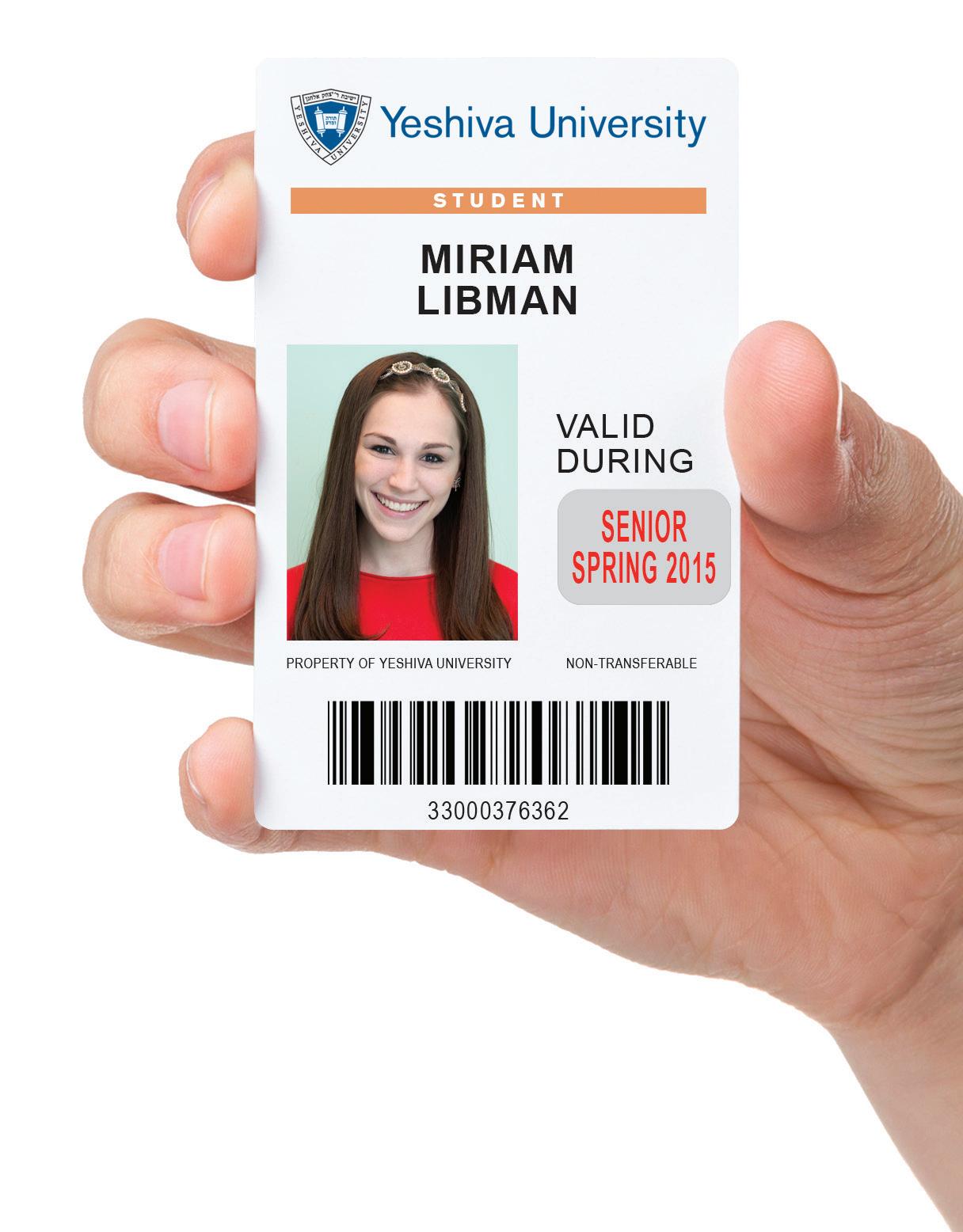

Meet Miriam Libman, a current Yeshiva University senior. Miriam will be graduating with a degree in accounting and will begin her career at Ernst & Young in the fall. She is among the 90% of YU students employed, in graduate school or both—within six months of graduation.* With nearly double the national average acceptance rates to medical school and 97% acceptance to law school and placements at Big Four accounting firms, banks and consulting firms, our numbers speak for themselves.
Picture yourself at YU. #NowhereButHere
lowing (Collected Writings of Rabbi Samson Raphael Hirsch, vol. 7, p. 264):
If the notion of evolution were to gain complete acceptance by the scientific world, Judaism would call upon its adherents to give even greater reverence to God, Who in His boundless creative wisdom, needed to bring into existence only one amorphous nucleus and one law of “adaptation and heredity” in order to bring forth the infinite variety of species that we know today.
However, this is not a verbatim quote from the Collected Writings. Rav Hirsch’s actual words are:
Even if this notion were ever to gain complete acceptance by the scientific world, Jewish thought, unlike the reasoning of the high priest of that notion, would nonetheless never summon us to revere a still extant representative of this primal form as the supposed ancestor of us all. Rather, Judaism in that case would call upon its adherents to give even greater reverence than ever before to the one, sole God Who, in His boundless creative wisdom and eternal omnipotence, needed to bring into existence no more than one single, amorphous nucleus and one single law of “adaptation and heredity” in order to bring forth, from what seemed chaos but was in fact a very definite order, the infinite variety of species we know today, each with its unique characteristics that set it apart from all other creatures.
Rav Hirsch adds that “this would be nothing else but the actualization of the law of ‘lemino,’ the law of species, with which God began His work of creation. This law of lemino, upon which Judaism places such great emphasis in order to impress upon
its adherents that all of organic life is subject to Divine laws, can accommodate even this ‘theory of the origin of species.’”
Nowhere in those words is an expression of agreement with the theory of evolution. The words only say that if the theory is accepted universally by the scientific community, one could look at it as describing a Divine wisdom utilized during the creation of animal species. This doesn’t mean that Rav Hirsch looked at the creation of the animal kingdom that way.
In the sentence just prior to those above, Rav Hirsch explicitly expresses his view on the veracity of the theory. After asserting that man’s attempts to explain natural laws “does not alter his moral calling,” Rav Hirsch tells us the following:
This will never change, not even if the latest scientific notion that the genesis of all the multiple of organic forms on earth can be traced back to one single most primitive, primeval form of life should ever appear to be anything more than what it is today, a vague hypothesis still unsupported by fact
With such unequivocal skepticism, Rav Hirsch cannot serve as a source of support for the theory of evolution. Rabbi Natan Slifkin agrees that Rav Hirsch “personally did not believe in evolution” (www.ZooTorah.com/ controversy/BetechAffair.pdf).
Rav Hirsch’s intent was to offer a way for those who

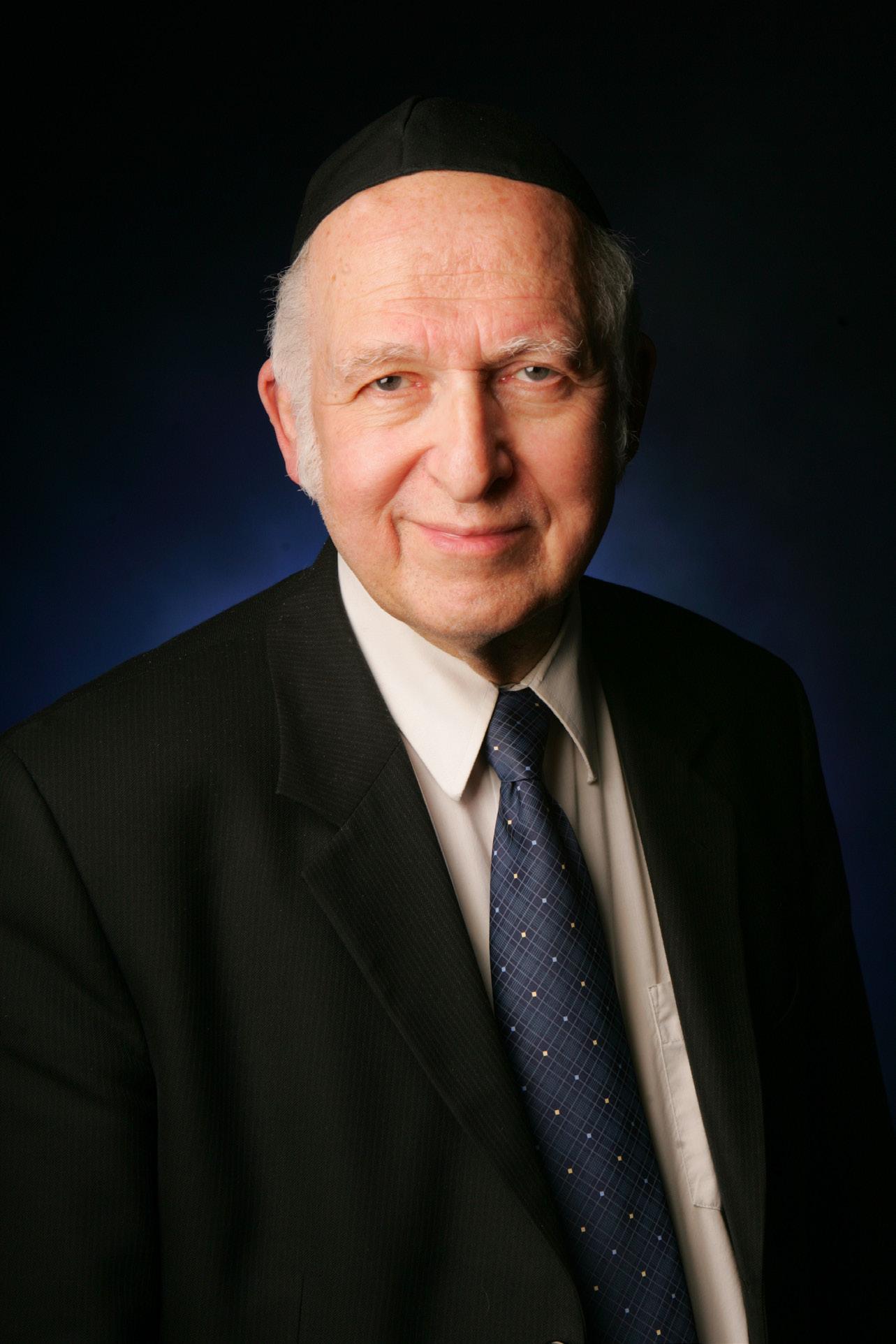



supported the theory to pursue a Torah-observant life. However, he personally did not support it.
YISRAEL KASHKIN
Passaic, New Jersey
g Nowhere in my article did I state that Rav Hirsch accepted the theory of evolution. In fact, Rav Hirsch’s view on this matter is of minor importance because Rav Hirsch was not known for his expertise in science. The greatness of Rav Hirsch lay in the realm of Torah. Therefore, the important question—the question that I did discuss—is whether Rav Hirsch thought that the theory of evolution is consistent with Torah hashkafah Rav Hirsch gave a clear, affirmative answer to this question, writing that if the theory of evolution “were ever to gain complete acceptance by the scientific world . . . in that case, Judaism would call upon its adherents to give even greater reverence than before to the one, sole God . . .”
Rav Hirsch indeed thought that the theory of evolution was “a vague hypothesis, unsupported by fact,” a view shared by many scientists before Gregor Mendel’s genetic theory became known. In Rav Hirsch’s time, no one could explain heredity or mutations, the backbone of the modern theory of evolution.
Rav Hirsch viewed evolution (“if accepted by the scientific world,” which is the case today) as the mechanism used by God to produce the animal kingdom, writing that God “needed to bring into existence only one single, amorphous nucleus and one single law of heredity to bring forth . . . the infinite variety of species that we know today . . . .”
This point of view, known as “theistic evolution,” is accepted by many Orthodox Jews, including me.
g Reading “From Homemade to Store-Bought” by Carol Ungar (spring 2015), I noticed that the author states, “Another important job was making rosl, a now-almost-unknown pungent crimson-colored beet broth that was considered the height of gourmet cuisine in Eastern Europe.”
I have been making horseradish this way for forty years now (though I did not know it was called rosl until I read the article). Making this “beet juice” on Purim each year starts my Pesach preparations. Far from being forgotten in my family, making this homemade horseradish is an annual event for me, and my family and friends look forward to my horseradish each Pesach.
DENNIS HALPIN
Houston, Texas


YU enables you to grow and deepen your understanding of, and commitment to, Jewish life at a top tier college while discovering your passions and beliefs and forming lasting friendships. With student programs across our campuses and worldwide, YU takes a global approach to learning, education and values, creating a full college experience.
A YU education is not out of reach. Over 80% of students received help with tuition last year, with over $45 million in scholarship and financial aid awarded.
Picture yourself at YU. #NowhereButHere
Martin Nachimson

There was much hand-wringing when the Pew Research Center’s “A Portrait of Jewish Americans” was first released in October 2013. We all bemoaned the devastating intermarriage rates among the non-Orthodox (at 71.5 percent), and the slow but steady erosion of American Jewish life.
On the positive side, the Pew report affirmed what many of us already knew: American Orthodoxy has experienced a remarkable resurgence. With our high birthrate and very low intermarriage rate, our community is vibrant, strong and growing.
And yet, the report also made it very clear that we have our own problems to contend with. While our retention rate is impressive at 83 percent, it means that nearly 20 percent are dropping out of religious life.
We invest an average of $300,000 to educate a child Jewishly (including camps, the gap year in Israel, et cetera). With such an extraordinarily high investment, a loss of close to 20 percent is nothing short of alarming. What are we doing wrong?
This, in fact, relates to a question we at the OU face all the time. Should we invest our limited dollars in keeping Orthodox youth committed or in reaching those who know little or nothing about their heritage? Do we focus on kids who resent the restric-
tions of Shabbat or do we focus on those who have never experienced a Shabbat at all? Whose needs are more pressing? Which is a better “investment” yielding better “returns”?
Obviously, we cannot evaluate the sacred work of saving neshamot on a spreadsheet. We cannot put a price tag on keeping our young people in the fold, on ensuring we produce committed Torah leaders, on working to build a strong and vibrant future for Torah Judaism.
And yet, we must make decisions. At NCSY, the world’s most successful Jewish youth organization, we have historically recognized the need for both in-reach and outreach. Indeed, as one NCSY leader recently told me: “There are very few kids on any religious level who don’t need NCSY.”
Why do yeshivah kids need NCSY? As Rabbi Micah Greenland, international director of NCSY, puts it, there is the “magic of NCSY.”
Every summer, we bring more than 1,000 kids to Israel on summer programs. More than 600 of them are, in fact, yeshivah kids who attend NCSY Kollel (where my grandson is planning to go this summer), Michlelet, GIVE and other such programs tailored to their specific needs. Recently, in fact, we have begun exploring more ways to transport the “magic” of our wildly successful summer programs for yeshivah kids into year-round programming. We are also expanding our single-gender programs. Just recently, 4G, an all-girls’ program in the Midwest, hosted NCSY’s first-ever allgirls’ Shabbaton.
But making inroads in reducing the drop-out rate means we must continue to follow NCSYers as they graduate high school and reach young adulthood. Each year, roughly 2,500 students graduate from Modern Orthodox high schools across North America. Between seventy and eighty percent of them end up
attending secular college campuses. In the uber-questioning, uber-liberal atmosphere of the college campus, religious students are exceptionally vulnerable to grappling with, and yes, even losing, their faith.
We help NCSYers transition into college life by connecting them to Jewish life on campus. Our regional offices around the country keep in close contact with twelfth graders, helping them with their choices and guiding them to Jewish resources on campus. One such resource is a program I am particularly proud of: the Heshe and Harriet Seif Jewish Learning Initiative on Campus (JLIC), currently found on twenty-two campuses throughout North America. JLIC places rabbinic couples on campus to help students navigate the various challenges of campus life. Due to the enormous need for such a program, JLIC is growing. Reaching a lot more than just NCSY alumni, JLIC programs and community leadership involve nearly 4,000 Jewish students each year. Through our JLIC programs, run with the invaluable assistance of our national partner, Hillel—the Foundation for Jewish Campus Life, Orthodox kids have Torah role models who not only organize Chanukah parties and Megillah readings on campus, but also serve as confidants at a particularly sensitive time in their lives.
Do our in-reach programs work? When I hear that a yeshivah kid who was about to give it all up is now a leader in an NCSY region, or when I hear that a beit midrash on a secular college campus is full with students studying Torah each night, I think, “Yes, it is working.”
But until the drop-out rate in our community is at zero percent, we cannot afford to sit back and relax. Until then, we have much work to do. g

By Gerald M. Schreck
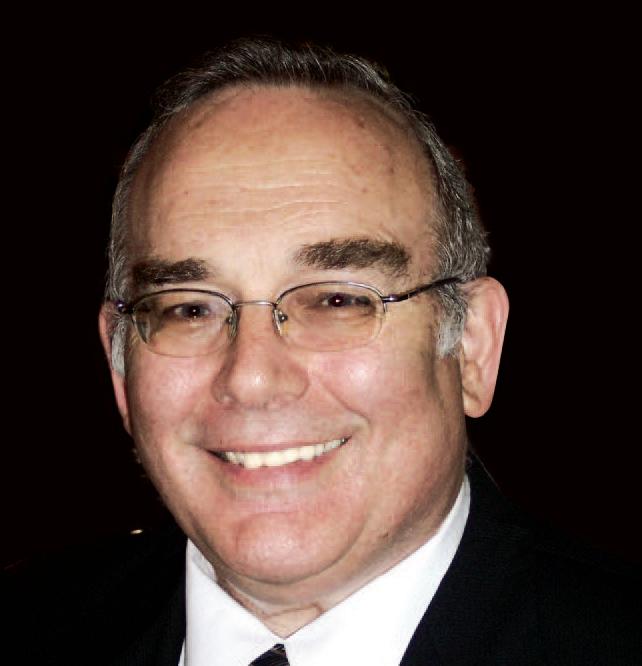
Our editorial board thought long and hard before going ahead with this issue’s somewhat controversial cover story, “When Leaders Fail: Healing from Rabbinic Scandal.” Members of the board were concerned: Could we handle this delicate subject matter with the right combination of erudition and empathy? Could we address the issue from all angles— psychological, emotional, spiritual and halachic? We knew, however, that when Rabbi Yitzchak Breitowitz, a maggid shiur at Yeshivat Ohr Somayach in Jerusalem and the former rabbi of the Woodside Synagogue in Silver Spring, Maryland, accepted our invitation to write about the topic, it would be handled intelligently, compassionately and sensitively.
Why did we decide to cover this disturbing, even demoralizing, topic despite the angry letters that will inevitably follow? Because it’s necessary. When a scandal occurs involving a rabbinic leader, the psychological and spiritual repercussions are profound. Oftentimes, congregants and community members even those who were
not closely connected to the rabbi in question are deeply traumatized. There is pain and a sense of betrayal. Some may begin to question their faith. Some may begin to reject the idea of rabbinic authority. Make no mistake: rabbinic scandals can and do result in a form of communal trauma.
In the days of the Beit Hamikdash, there were rituals to help the community cope with the trauma of sin. In his wonderful new book, Covenant & Conversation on Leviticus: the Book of Holiness, Rabbi Lord Jonathan Sacks describes the ritual of the two goats, the sair l’azazel and the sair laShem, that were part of the Yom Kippur service. One of the reasons for this “immensely powerful and dramatic ceremony” was so people would “feel and symbolically see the sins carried away to the desert, to no-man’s land.” The ritual was therapeutic. It gave people hope; it conveyed to them in a very concrete way that sin whether on a personal or on a communal level does not stain one forever.
Judaism, Rabbi Sacks writes, “is a religion of hope, and its great rituals of repentance and atonement are part of that hope. We are not condemned to live endlessly with the mistakes and errors of the past.”
These same core ideas of teshuvah, recovery, and spiritual rehabilitation come up again and again in Rabbi Breitowitz’s wide-ranging and deeply thoughtful essay. Sometimes leaders may fail, but that should not cause us to succumb to hopelessness or despair.
Nowadays, we have no Beit Hamikdash, and we can no longer experience the cathartic eradication of aveirot via the sair l’azazel; so how are we to cope with the consequences of sin both on
a communal and on a personal level?
The Torah, of course, provides an answer. In Parashat Naso, Rashi asks the following question: “Why is the topic of the nazir juxtaposed to the topic of sotah?” He famously responds:
“To teach you that anyone who sees a sotah in her destruction should refrain from wine.”
When one observes the disgrace of the sotah, he should commit to become a nazir. Why? Because witnessing the consequences of aveirah could, God forbid, help “normalize” sin in one’s mind and desensitize him to depravity.
“Become a nazir,” the Torah tells us. In other words, erect even greater, taller, more fortified fences so that you yourself don’t falter.
What should our personal and communal response be when we hear about a rabbinic or communal leader who stumbles? Perhaps we should respond by doing our best to strengthen ourselves spiritually, by recommitting ourselves to learn even more Torah and do even more mitzvot, and by deepening our own resolve to live a more authentic religious life.
We are truly honored to publish Rabbi Breitowitz’s nearly 6,000-word essay, which many of us on the editorial board feel, myself included, is one of the most important articles we have published in the pages of this magazine.
It is our hope that Rabbi Breitowitz’s stirring words will help bring some level of peace, hope and psychological and spiritual closure to those among us still suffering from scandals that have affected their synagogues and their communities. g
Eli
t all began with one book.
A Gemara actually—a 1735 edition of Tractate Moed Katan, a gift from my beloved father-in-law, Dr. Eric Offenbacher. Ultimately, this Gemara led to my developing a passion for collecting antique sefarim, a hobby I have been very involved in for the past decade.
What is it about old sefarim that fascinates me? The books themselves speak. They tell the story of Hebrew printing. They tell the stories of their long-deceased owners. Take, for example, the Gemara that got me started on my journey. It was printed in a city whose Jewish community dates back to the thirteenth century—Frankfurt am Oder (not to be confused with the more well-known city of Frankfurt am Main), sixty miles east of Berlin and situated on the Oder River. Three separate editions of the Talmud were printed there between 1697 and 1739. When the edition I own was printed,1 the printing house was owned by Professor Johann David Grillo, a non-Jew, as noted in the Gemara’s title page. (In those days, it was common for gemaras to be printed in printing houses owned by non-Jews.)
Eli Genauer is a businessman, community volunteer and book collector living in Seattle, Washington, where his family has lived for over 100 years. He has written extensively about his collection both online and in scholarly journals, and delivered a talk on his research at the 16th World Congress of Jewish Studies.
TheGemara had originally belonged to my wife’s

The 1735 edition of Moed Katan, printed in Frankfurt am Oder, that started the author on his journey of collecting antique sefarim.
great-great-grandfather, the well-known antiquarian dealer and Jewish philanthropist Selig Goldschmidt (1828-1896). A resident of Frankfurt am Main, Mr. Goldschmidt was a supporter of Rabbi Samson Raphael Hirsch.2 A lifelong philanthropist, he shied away from honor, and only asked that he
merit to be buried next to his rav. A visitor to the Jewish cemetery in Frankfurt today will notice four tombstones set apart from the rest—those of Rav Hirsch and his wife, and those of Selig Goldschmidt and his wife.
Another one of my treasures is a machzor for the Shalosh Regalim printed in Halberstadt, Germany, in 1860 and owned by Reuben (Robert) Goldstein. The machzor, one of only

A machzor for the Shalosh Regalim owned by Reuben (Robert) Goldstein, who, along with his wife, Anna, and their eight children were the first permanent Jewish settlers in Alaska. They arrived in Juneau in the early 1880s, a few scant years after the town was established.
fourteen Hebrew books ever printed in Halberstadt, 3 features the following inscription: “Reuben Goldstein, Juneau, Alaska, February 4, 1900.” Apparently, Reuben Goldstein, his wife, Anna, and their eight children were the first permanent Jewish settlers in Alaska. They arrived in Juneau in the early 1880s, a few scant years after the town was established. Prior to settling in Alaska, Goldstein had operated businesses in Montreal, Winnipeg, Seattle and other cities.
The books themselves speak. They tell the story of Hebrew printing. They tell the stories of their long-deceased owners.
He started out in Juneau in the fur trade business but then discovered that no mineral claim had ever been filed for the twenty-nine acres of land lying underneath the commercial business district of Juneau. The Alaska State Library records that:
In 1886, [Reuben Goldstein] filed a mineral claim on the town site of Juneau.4 The public discovered this fact in 1888 when the Secretary of the Interior awarded a little over 29 acres of Juneau to Anna. The citizens became so enraged over the prospect of losing their homes and property they called a public hearing and decided to either hang Goldstein or throw him in the bay
[newspaper clipping from San Francisco Call, Nov. 28, 1888]. The case was taken to the General Land Office (Goldstein vs. the Town Site of Juneau) where it was decided in favor of the town. From there it went to the Supreme Court and then referred to the Interior Department. The claim was determined valid. The land was thought to be worth between $900,000 and $1,000,000 and apparently Goldstein settled for a sum of money instead of the land.
Goldstein passed away in 1900.5 Since there was no Jewish cemetery in the area, his body was sent 1,000 miles by boat to Seattle, Washington, where he was buried in the cemetery of Chevra Bikur Cholim. The fact that the family, went to such lengths to bury him in a Jewish cemetery says much about their connection to the Jewish community, despite their living in the Jewishly isolated city of Juneau. Interestingly, despite the judgment against the town, the townspeople seem to have held no grudge against the family as one of the children, Issie Goldstein, served as mayor of Juneau for three terms. Can’t you picture Reuben Goldstein davening from this machzor in the Alaskan town of Juneau around the turn of the twentieth century?
Traveling to the other end of the Pacific Ocean, we meet the Lubliner Rebbe of Bnei Brak, Rabbi Avraham Eiger (19142002), whose signature appears in a Masechet Nedarim I own that was printed in Shanghai in 1943. Many tractates of the Talmud, along with other scholarly books, were printed in Shanghai for students of the Mir and Slobodka yeshivot who sought refuge there during the Holocaust.6
The edition I own bears the inscription “shayach l’habachur Avraham Eiger” (this book belongs to the young man Avraham Eiger). Rabbi Avraham Eiger, who was born in Warsaw in 1914, was a direct descendant of the famed Talmudist and legal authority Rabbi Akiva Eiger of Posen. Rabbi Avraham Eiger studied with his cousin, the Admor of Lublin, Rav Azriel Meir Eiger, who in 1939 encouraged him to leave Poland. He joined a group led by the Amshinover Rebbe that eventually made it to Lithuania. There he was one of the few thousand fortunate Jews who received transit visas issued by the heroic Japanese vice consul in Lithuania, Chiune Sugihara. Along with Yeshivas Mir, Rav Avraham spent much of the war in Shanghai, and most likely it was there that he acquired the Gemara under discussion. After the war, he married, and along with his wife, made aliyah. He settled in Bnei Brak in 1955.7 This edition of the Gemara, printed while the Holocaust was raging in Europe and learned by refugees whose lives were shattered by war and deprivation, attests to the spiritual resilience of the Jewish people. Even though their lives were in upheaval, the refugees knew that gemaras had to be printed, that Torah study had to persist.
Another cherished sefer in my collection is the Jerusalem Talmud, Tractate Nedarim, printed in Warsaw in 1837.
The stamp on the title page indicates that it belonged to Rabbi Raphael Shapira (1837-1921), rosh yeshivah of Yeshivas Volozhin from 1899-1915, “Ha’oveid avodas haTorah b’Volozhin” (who is engaged in the service of the Torah in Volozhin). Rabbi Shapira was the son-in-law of Rav Naftali Tzvi Yehuda Berlin (the Netziv). He married the Netziv’s daughter, Sara Rasha, when he was fifteen. Their daughter Lipsha eventually married Rabbi Chaim Soloveitchik, making Rabbi Shapira the son-in-law and father-in-law of two of the most preeminent scholars of Lithuanian Jewry.
I bought this particular sefer because of the special relationship my family had with Rabbi Shapira. My maternal grandfather, Rabbi Avraham Rosen, arrived in New York on March 18, 1922, leaving my grandmother and three small children behind in Poland. When he got to Ellis Island, he was detained for a few weeks because he had to appeal to the US government for permission to enter.8 The government allowed clergy into the country even without citizenship papers, but officials needed to verify that his rabbinic ordination was valid. The officials had never come across Rabbi Raphael Shapira, the name of the rabbi who conferred semichah to my grandfather. Finally, they consulted with

Masechet Nedarim printed in Shanghai in 1943. Many tractates of the Talmud along with other scholarly books were printed in Shanghai for students of the Mir and Slobodka yeshivot who sought refuge there during the Holocaust.
Listen to Eli Genauer speak about sefarim collecting at www.ou.org/life/history/savitsky_genauer/.
1. 2. 3. 4. 5. 6.
FOCUS, FOCUS, FOCUS. Try to narrow down the area you would like to pursue. For example, some people like old Haggadahs; others prefer first editions of Chassidic books or early printed gemaras , and still others antique siddurim.
USE A BIBLIOGRAPHY SITE such as hebrewbooks.org, which has thousands of books. You can actually see what the old sefarim look like, including ones that go back to the 1500s. Similar to other researchers, many collectors rely on Google—both in Hebrew and English—to get started in researching subjects. Bibliography listings of major Jewish libraries such as the Israel National Library can be especially helpful.
SHOP ONLINE! Believe it or not, eBay has a multitude of offerings of old sefarim. I check the listings there frequently. Nowadays, acquiring old books is much easier than before in that many books are available online.
MAKE IT PERSONAL Check the libraries of friends and family. You would be surprised at what you find.
GOING ONCE, TWICE… It is now much easier to access auctions of old sefarim. Collectors often participate in online auctions conducted by large Jewish auction houses in New York and in Israel. Some popular sites and auction houses are JudaicaUsed.com, virtualjudaica.com, Kestenbaum & Company, Asufa and Kedem auction houses.
SPREAD THE WORD When people know you collect old sefarim , they let you know when they come across something.

Jerusalem Talmud, Tractate Nedarim, printed in Warsaw in 1837. The stamp on the title page indicates that it had once belonged to Rabbi Raphael Shapira, rosh yeshivah of the Volozhin Yeshiva from 1899 to 1915.
one of the prestigious rabbis in New York at the time and asked about the legitimacy of rabbinic ordination from Rabbi Shapira. The rabbi answered, “That’s who I got my semichah from.” My grandfather and his family were spared from the Holocaust because of Rabbi Shapira. It’s not surprising that I feel a very special connection to this sefer. Investigating sefarim and their owners is a pastime that takes me around the world and through the centuries—in a virtual sense. I have “met” fascinating individuals whose sefarim now grace my library shelves—from simple Jewish laborers to prominent rabbis, from Jewish communities ranging from Warsaw to Shanghai. Each and every one of the sefarim I own has a story or stories behind it. Each and every one is a piece of Jewish history, a tangible link to our rich and illustrious past. g
Notes
1. Rabbi Raphael N. N. Rabinowitz in his classic book on the early printed editions of the Talmud, Maamar al Hadpasat HaTalmud (History of the Printing of the Talmud), ed. A.M. Habermann (Jerusalem, 2006), 117, decries this particular edition because it lifted many innovations from the 1720 Frankfurt am Main edition, ascribing these additions to their own scholarship.
2. Information from both family tradition and from a book about Selig Goldschmidt written by his son, Meier Selig Goldschmidt. It was translated into English and distributed to members of the family.
3. Yeshayahu Vinograd, Otzar Hasefer HaIvri, under “Halberstadt.”
4. See www.juneau.org/library/museum/index.php.
5. Reuben Goldstein also holds the distinction of having a valley in Juneau named for him: Goldstein Gulch.
6. Printing the Talmud: From Bomberg to Schottenstein, ed. Sharon Liberman Mintz et al. (New York, 2006), 292.
7. An obituary for him on the web site Dei’ah VeDibur in 2002 notes that in Shanghai “Rabbi Avraham Eiger was widely recognized as a ben aliyah. It was known that he would check all of his food for bugs by sunlight.”
8. I assume my grandfather was referring to some kind of visa allowing him to emigrate to the US.








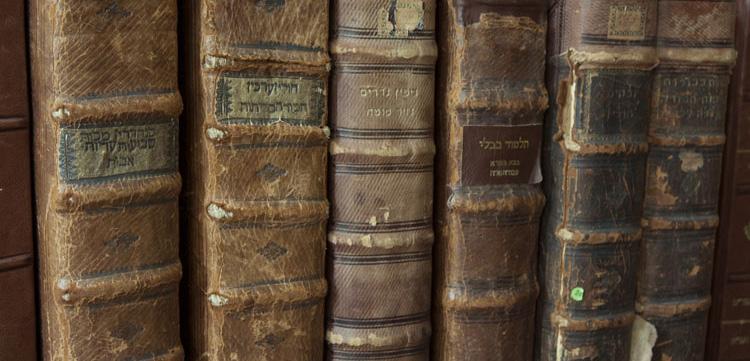
BY BAYLA SHEVA BRENNER
Expert collector Rabbi Eliezer Katzman, a consultant and appraiser of Judaica and Hebrew books for Kestenbaum & Company, has also worked for Sotheby’s, Christie’s and other auction houses. Rabbi Katzman, who lives in Brooklyn, New York, has appraised the collections in the Rare Book Room of the Mendel Gottesman Library of Hebraica/Judaica at Yeshiva University, the collection in the Jewish Public Library of Montreal and the rare books and manuscripts of the Annenberg Research Institute in Philadelphia. He has published many scholarly articles on Jewish history, Jewish law and bibliography and serves as associate editor of Yeshurun, one of the foremost scholarly biannual publications on Jewish law, history and bibliography.
Jewish Action: Tell us about your extensive library of rare sefarim and how you became involved in collecting.
Rabbi Eliezer Katzman: I own an eclectic collection of about 10,000 sefarim. Originally I bought sefarim for my own learning. If I had to prepare a shiur and needed a sefer, I couldn’t go hunting for it in shul late at night. [But] my interest in rare sefarim began with my father, Rabbi Asher Katzman,

who was a rosh yeshivah at Yeshiva Torah Vodaath. He had between 30,000 and 40,000 sefarim. I inherited the bug. A lot of the sefarim I have are from him; others I bought on my own.
JA: Where do you keep your vast collection?
RK: I have sefarim filling my garage, shed and basement. A young collector called me once, lamenting his shalom bayis problems; there was no room left
Bayla Sheva Brenner is senior writer in the OU’s Communications and Marketing Department.
in his house. He had run out of shelf space and began piling sefarim on all of their chairs. His wife complained that there was no place to sit. He solved the problem by purchasing the Otzar HaHochma digital library that has approximately 71,000 sefarim scanned in page after page. He told me it saved his marriage.
JA: What are the most important factors when assessing a sefer’s market value?
RK: The first factor is obviously age. The rarest books are known as incunabula—books printed before 1501, when printing was in its infancy. Jewish incunabula are especially rare. For example, a Jewish book printed in 1492 is worth considerably more than a non-Jewish book from the same period. The Jewish people studied their books throughout the exiles, so complete, intact Jewish books are extremely rare. Jewish books were often burned over the centuries—another reason they are rare. There were books printed right before the Holocaust, most of which were destroyed by the Nazis. Those that survived are very valuable.
Currently, I write the descriptions of the sefarim and manuscripts featured in the Kestenbaum & Company catalogs. The catalogs describe the importance of each sefer,
when it was printed, its condition and what it’s worth. If a famous person wrote marginal notes in a sefer, it increases the sefer’s worth. A sefer that once belonged to Rav Moshe Feinstein that contains his notes is worth much more [than a sefer without notes]. Rabbi Baruch Frankel-Teomim, known as the Baruch Taam [1760-1828], the father-in-law of Rav Chaim Sanzer, wrote notes in the margins of all his sefarim. Recently, Rabbi Baruch Shimon Schneerson, the son-in-law of Rabbi Dov Berish Weidenfeld, the Tchebiner Rav, published a collection of the Baruch Taam’s marginal notes on various sefarim.
There are two categories of rare Jewish books: printed sefarim and manuscripts. Many people view a letter or manuscript by a Chassidic rebbe or the Chofetz Chaim as intrinsically holy. [Nowadays,] a handwritten letter by the Chofetz Chaim . . . is worth approximately $20,000. Even a typed letter with only his signature may be worth a few thousand dollars.
[To command a high price,] a sefer has to be complete; a book missing a title page is worth substantially less. It should be in good condition (not wormy). Noncollectors often assume that older books are in worse condition than later ones. But that’s not necessarily the case. After 1860, chemicals were added to paper. That’s why books from later periods often have brittle pages. The paper used in earlier books rag paper remains fresh.
Another factor that determines the value of a sefer is the element of mystique. For example, a siddur was published in Amsterdam with the kabbalistic commentary of Rabbi Yeshaya Horowitz, known as the Shelah HaKadosh. There’s a haskamah (letter of approbation) in the siddur from the Bach, who writes that anyone who prays from this siddur will have his prayers answered. Collectors pay a lot of money for it. The Shelah probably meant that anyone who studies his commentary and adheres to the suggestions will be answered. But people will pay between $20,000 and $30,000 for the siddur.
First editions of Chassidic sefarim also command high prices. Chassidim like to have a connection to their rebbes and their dynasties. In the town of Slavuta, Ukraine, Rabbi Moshe Shapiro was the town’s rabbi and printer. He was a descendant of the famous Chassidic rabbi, Rabbi Pinchas of Koretz, a disciple of the Ba’al Shem Tov. Chassidim view any sefer printed by the descendants of his family as imbued with inherent kedushah. For example, a Tehillim printed in Slavuta could go for $5,000. They are in great demand, especially by Skverer Chassidim, who are willing to pay top dollar for them.
JA: How do collectors go about finding rare sefarim?
RK: When I was growing up, there were still sefarim stores on Manhattan’s Lower East Side that sold many out-of-print sefarim. There was a time you could get [these works] at a relatively low price. In Eretz Yisrael today there’s a rapidly growing industry of book dealers selling antique books and manuscripts. There are a lot of sheimos and old sefarim found in many of the old houses in Yerushalayim. I know a book dealer in Israel who finds out when a home is being demolished and makes a deal










The rarest books are known as incunabula—books printed before 1501, when printing was in its infancy. Jewish incunabula are especially rare, says Rabbi Eliezer Katzman, an expert in Hebraica and Judaica. Seen here is an example of Hebrew incunabula that is very valuable. Colophon of Arba’ah Turim: Orach Chayim, published in Mantua, Italy, by Abraham Conat, ca. 1476. Images courtesy of Yeshiva University, Mendel Gottesman Library.
with the builder to give him entry to the attic before the structure is torn down. He’s discovered many ancient sefarim and letters this way. [He recently discovered] precious items owned by Rabbi Zundel of Salant, who lived in Jerusalem in the mid-1800s. In 1948, when the Old City was destroyed, a number of his sefarim survived and were preserved by members of his family. A recent auction featured letters and articles that belonged to him.
JA: With the advent of the Internet and digitization, does actively building up one’s physical library really make sense?
RK: In the past, if someone needed certain sefarim, he had to go to four or five different libraries. Some were found only at Oxford University or the British Museum in England or at the National Library of Israel at Hebrew University in Jerusalem. In America, some of the researchers use the library at Yeshiva University and the Jewish divisions at The New York Public Library and at Harvard University. Harvard has one of the largest collections of Hebrew books—about 60,000 to 70,000 works. The Library of Congress also has a large collection. Nowadays, you can go to a site called Hebrewbooks.org, which has about 50,000 digitized sefarim. One can also purchase CDs containing thousands of sefarim. However, there is a tremendous advantage to having access to a physical sefer. Not everything is on the Internet, and some people enjoy holding a 300-yearold sefer in their hands; it enables them to feel a greater connection to the author and the time period.
JA: What do you think of those who collect sefarim primarily as a hobby, but not for personal study?
RK: They say of collectors in general that it’s the excitement of the hunt [that drives them].
One of the foremost collectors of rare Jewish books is Jack Lunzer, a retired industrial diamond merchant in London, who has one of the most valuable collections in the world—some 13,000 Hebrew works. In 2009, Sotheby’s exhibited a portion of his massive library, which included the most prized work of his collection, the first complete printed Shas, known at the Bomberg Shas. It previously belonged to King Henry VIII. As is well known, the king didn’t have any male heirs and wanted to annul his marriage so that he could remarry and attempt to have a son. [In order to legitimize his divorce,] an advisor informed him that he may find a solution in the Talmud. He ordered a copy of the first Shas, printed in the early 1500s. He received a deluxe edition, bound especially for the king. Eventually, he gave it to the Church of England. Mr. Lunzer wanted to own this Shas and was initially unsuccessful in convincing the church to sell it. He bought the original charter of Westminster Abbey and persuaded the church to sell him the Talmud in exchange for the charter.
JA: Do you have any favorite sefarim?
RK: One of my favorites is the mussar sefer Marpe Lashon (Healing of the Tongue) by Rabbi Raphael HaKohen, rabbi of Hamburg, Germany. In his youth, Rabbi Chaim Volozhin was one of his disciples. He is famous for his responsa and chiddushim on the Talmudic tractates of Kodshim. The sefer, printed in 1790 in Altona, Germany, covers topics such as teshuvah, humility, tzedakah, Yom HaDin and various other topics. Although I already owned subsequent editions, as the sefer had been republished in Vilna and after that, in America, I decided to buy the original for two hundred dollars. Later, when comparing the editions, I observed that the Vilna edition didn’t have the lengthy introduction found in the original, as well as divrei Torah from the author’s son and son-in-law. After further comparison, I noticed that the chapters on tzedakah and humility, which were around twenty pages in the original, were only two pages long in the reprinted versions.
This sefer was one of Rabbi Aharon Kotler’s favorite sefarim; he quoted from it many times in his lectures. He also had difficulty trying to make sense of what the author was saying due to these incomplete chapters. I approached Rabbi Binyamin Zeilberger, rosh yeshivah of Bais HaTalmud in Brooklyn at the time, who had reprinted the sefer from the Vilna edition. I showed him the original edition and told him about the missing fifty pages. In 1987, he printed the full version of the sefer from my copy, thanking me in the introduction for giving him the original text. This shows the importance of
obtaining original editions and comparing them to subsequent editions.
JA: Are there many collectors such as yourself out there?
RK: There used to be a chevrah of collectors that included both rabbis and ba’alei batim who possessed large private libraries. Rabbi Shlomo Freifeld, zt"l, owned a large library. I assessed it after he passed away. There’s a story told that he and Rabbi Berel Perlow, an avid collector of newly published sefarim, saw each other at Biegeleisen JS Books, a popular sefarim store in the Borough Park section of Brooklyn. Rabbi Freifeld put his arm around Rabbi Perlow and quipped, “Reb Berel, we’re like two drunks in a bar.”
They say the Gerrer Rebbe, known as the Imrei Emes, also had the bug; he had one of the world’s largest libraries. Much of his collection disappeared during the Holocaust. He was once in Krakow in an old sefarim shop and climbed up a ladder to the top shelf, hunting for rare sefarim. He came down covered in dust. The owner of the store asked him, “Rebbe! Iz dos nisht ah yetzer hara ozoi vi alla yetzer haras?” (Is this not a yetzer hara like all the other yetzer haras?) He responded, “You’re right, but it’s a kosher yetzer hara.”
JA: Were you ever subject to significant danger while acquiring sefarim?
RK: I personally wasn’t, but I know people who were. My father-in-law, Rabbi Chaim Uri Lipschitz, former editor of the Jewish Press, was friends with Rabbi Harry Bronstein, who founded the Al Tidom Association, established to help Russian Jewry struggling behind the Iron Curtain. As an experienced mohel, he traveled to Russia many times to perform brissim and to train mohels there. During these trips, various people came to him, asking him to smuggle their manuscripts out of Russia. One of these requests came from Rabbi Yitzchok Isaac ben Dov Ber Krasilschikov, also known as the Gaon of Poltava. He gave Rabbi Bronstein his manuscript on Rambam while he lay in the hospital on his deathbed. He also made him promise to publish his monumental twenty-volume commentary on the Yerushalmi he had worked on. [An extraordinary talmid chacham, Rabbi Krasilschikov authored a massive commentary on the Yerushalmi in Moscow between the years 1952 and 1965. This was, of course, illegal in Communist Russia.] Because of the illegal brissim, Rabbi Bronstein was arrested and tortured by the KGB. He subsequently suffered a heart attack. He miraculously survived and returned to America. He worked hard for many years to obtain the manuscript on the Yerushalmi. [In 1980, the first volume of Rabbi Krasilschikov’s commentary on Tractate Berachot was finally published. The printing of Rabbi Krasilschikov’s colossal commentary on the










Colophon of Arba’ah Turim: Yoreh De’ah, published in Mantua, Italy, by Abraham Conat and completed in Ferrara by Avraham ben Hayim, ca. 1477. The handwritten portion on the bottom of the page was written by a censor.
Yerushalmi is an ongoing effort, currently overseen by Rabbi Chaim Kanievsky.]
JA: What is the future of the sefarim industry?
RK: It continues to grow. There were more sefarim printed in the last few years than in any prior period. Moshe Biegeleisen of Biegeleisen JS Books stated recently that in just three weeks he got eighty new sefarim. It’s much easier to publish books with computers. One can do a lot by himself at home.
JA: How do current sefarim reflect contemporary Orthodox life?
RK: There are many more sefarim published in English today than in previous generations, obviously with the many [Anglo] consumers in mind. In Eretz Yisrael numerous scholarly sefarim are constantly being published, as well as the more popular sefarim containing stories and parashah-related insights that families could share at the Shabbos table. The most popular books of this genre are written by Rabbi Yitzchok Zilberstein, Rav Elyashiv’s son-in-law. They are best sellers both in Israel and in America. I’m sure that, despite all of the new technologies, frum Jews will continue to value and utilize the actual printed word, especially on Shabbos and yom tov. A sefer is a more personal, hands-on connection to previous, current and future generations of Torah scholars. g









Five Hundreds Years of the Hebrew Book From the Beginning of Printing Until the Twentieth Century
By Akiva Aaronson Feldheim Publishers New
York, 2013
231 pages

Reviewed by Gil Student
The Internet is only the latest, and probably not the last, of many information upheavals due to technology. An important change began over 500 years ago with the invention of the printing press. This new method for mass-producing books quickly altered the political and religious face of Europe. Jews, traditionally devoted to literacy and study, were early adopters of printing technology and suffered less upheaval than their Christian counterparts.
In a fascinating and richly illustrated new book, People of the Book: Five Hundreds Years of the Hebrew Book From the Beginning of Printing Until the Twentieth Century, Akiva Aaronson traces important Jewish developments
along the path, from Rashi’s Torah commentary, the first dated Hebrew book (Italy, 1475), through the Survivors’ Talmud published in 1948.
In the mid-1400s, Johannes Gutenberg invented the mass production of books through the printing press. Metal letters—movable type—were assembled onto a page. Ink made from vegetable oil rather than water, which does not stick to metal, was applied to the typeset page. Paper, which had been recently invented, was placed into a press in which the typeset page covered with ink was pushed onto the paper. With this combination of inventions, the new technology of the printing press could produce books in large volume. While some lamented the loss of the art of handwritten books, their apprehension could not stop the spread of inexpensive, mass-produced books. In explaining all this and more, Aaronson includes delightful and enlightening illustrations of early printing presses and books.
Printing was developed in Germany, but Jews were excluded from the industry by the local guilds. However, when the technology made its way to Italy, Spain and Portugal, Hebrew printing exploded. The first fifty years of printing, from 1450 to 1500, are called the period of incunabula. During that time period, there were twenty-nine active Hebrew printing shops, nearly one-fifth of all known printers at the time. With a literate and learned population, the Jewish community enjoyed a high demand for affordable books.
Each printer had to carve out his own letters what we call fonts today but regional characteristics can be easily seen. Ashkenazic printers used more square letters and Sephardic printers used rounder letters, each following the practice of scribes. Hebrew vowels proved a unique challenge; additional metal type had to be included for each vowel. Numbering of pages appeared in the early 1500s—the first Hebrew book with page numbers was the 1509 Constantinople edition of Rambam’s Mishneh Torah.
The house of Soncino was one of the earliest and most important Hebrew printers, and its name still resonates
today, over 500 years later. The first Hebrew book published by a member of the Soncino family was the Babylonian Talmud, Tractate Berachot, in 1483, likely the first printed volume of the Talmud. While the volume lacked page numbers, it contained Rashi’s commentary on the inner column of the page and Tosafot on the outer column. This format remains to this day.
In the short time between the invention of the printing press and the Jewish expulsion from Spain in 1492, Hebrew printers in Spain published many books, including the first printed Haggadah and both Rashi’s and Ramban’s Torah commentaries. In approximately 1491, Rabbi Yaakov Baruch ben Yehudah Landau’s Sefer HaAgur was published in Naples. This was the first Hebrew book published in its author’s lifetime.

Title page of Masechet Bechorot, published by the Agudath HaRabanim in the American Zone in Germany with the help of the US Army and the American Jewish Joint Distribution Committee, in 1948. Known as the “US Army Talmud” or the “Survivors’ Talmud.”
In the first half of the 1500s, printing ended its pioneer phase and became an established industry. Trade developed, texts became standardized and printing flourished. In 1516, Soncino’s greatest
competitor began publishing in Venice. Daniel Bomberg, a wealthy Christian, used the most accurate texts and the finest materials to print what quickly became the standard edition of basic Jewish texts. He published the first Tanach, the Hebrew Bible, with chapters and verses (and with the books of Shmuel and Divrei HaYamim each divided in two).
With the exception of prayerbooks, the Pesach Haggadah is the most published Jewish book, with about 5,000 editions having appeared since printing was invented.
His Mikra’ot Gedolot, the Rabbinic Bible, is still the basis for what is used today. And between 1520 and 1523, Bomberg published the first mass-produced, complete set of the Babylonian Talmud, which introduced pagination that
continues to this day.
Aaronson continues telling the stories of great books and printers throughout the centuries. Sulzbach, Roedelheim and Vilna are only some of the important places where publishers made Jewish history. In the early 1700s, stereotyping was developed, in which plates were made of complete pages. This not only reduced the cost of printing, but also allowed for easier reprinting of subsequent editions since the plates could be stored. The Industrial Revolution in the mid1800s brought with it mechanical iron presses that were faster and easier to use.
With the exception of prayerbooks, the Pesach Haggadah is the most published Jewish book, with about 5,000 editions having appeared since printing was invented. The earliest known printed Haggadah is from Spain, printed around 1482, with no vowels, commentary or
illustrations. The first printed Haggadah with commentary was Rabbi Yitzchak Abarbanel’s Zevach Pesach, published inConstantinople in 1505, not long after the author’s death. The Prague Haggadah of 1526 was the first Haggadah printed in Northern or Eastern Europe. It includes vowels and more than sixty illustrations.
Aaronson tells the story of the sefer with enthusiasm and color. He discusses censorship, halachic controversies and more. His story takes us into the twentieth century with Feldheim and Shulsinger Brothers in New York and the Soncino Press of London, concluding his historical survey with the publications immediately after the Holocaust. Technology has since grown in leaps and bounds. Digital printing has become fairly common and Internet storage of books, including publication directly online, is growing. The history of the sefer continues. g

By Yitzchak Breitowitz
In Bernard Malamud’s novel The Natural, an extremely talented ball player, Roy Hobbs, is discovered to have taken a bribe to throw a baseball game. He is barred from baseball for life and all his records are expunged. In a poignant final scene, a young boy turns to Roy with pleading eyes and says, “Say it ain’t so.” But Roy cannot. He simply weeps.
In many ways, this novel is a metaphor for the loss of innocence, for the sadness of discovering that those we thought were paragons of virtue and greatness are flawed, for the sense of betrayal as we are cast adrift by those in whom we put our trust and faith. In many ways, this metaphor aptly describes a crisis that is spreading within the Torah community.
We live in the era of the fallen hero—indeed the tragic hero who is destroyed by the fatal flaw that lies within. In all walks of life, people whom we admired have disappointed us with their failures and weaknesses. We have become disillusioned and cynical. Unfortunately, even within the Torah camp, leaders in whom we placed our trust have betrayed us. And while the overwhelming majority of rabbis, teachers and spiritual mentors perform their tasks with integrity and commitment— and we should never make the mistake of condemning the many because of the sins of the few—many of us have lost faith in the very people who are supposed to inspire us in our faith. We see them engulfed in sexual scandals, child abuse, political intrigue, bribery and fraud. Some are accused of direct wrongdoing, others of cover-up and dissembling. Many have lost faith not only in those who are supposed to transmit Torah but, to some degree, in the goodness and morality of the Torah itself. God’s name and His glory quite literally have been besmirched, the very definition of chillul Hashem.
In some ways, this cynicism and loss of faith may be a greater tragedy than even the very real pain suffered by innocent victims (a pain that I certainly do not want to minimize in any way). The tragedy of cynicism presupposes that everything is tainted. Nothing good is real. No one is sincere. Everything is a gimmick. Everyone is a charlatan and a faker. And what is the use of pretending otherwise? These attitudes suck up hope the way a fire sucks up oxygen. They destroy spiritual strivings. They destroy hope for the future. They engender passivity and bitterness and ultimately become a self-fulfilling prophecy of defeatism and hopelessness. It is precisely at this juncture that we have to take stock and articulate some basic simple principles.
The great Rabbi Moshe Chaim Luzzatto writes in the
introduction to the Mesillat Yesharim that he will be restating obvious principles that are known by all but are often forgotten in the pressures of the moment. And while his claim of a lack of innovation may be untrue, I humbly admit that this article will contain few chiddushim (novel thoughts). Sometimes, however, there is value in restating the obvious. Let me start with two basic points.
First, do not condemn the Torah. Rabbi Abraham Joshua Heschel once famously remarked that it is a big mistake to judge Judaism by the behavior of Jews. The Torah is greater than any one person or institution. The fact that we do not always live by its ideals cannot be an indictment of the ideals themselves.
Second, we live in an imperfect world. People are not all white and pure, nor are they all black and tainted; people come in an infinite variety of grays. The fact that we—all of us—are capable of great sin does not exclude the possibility, and the reality, that we are capable of great good. And indeed, the good that we accomplish is not forfeited by the evil that we perpetuate. As a result, we ourselves must avoid the arrogance of smugly sitting in judgment over the weaknesses and failures of others and, chas v’shalom, even gleefully rejoicing in the “downfall of the mighty” (an attitude that is quite evident on the Internet).1 Demonizing the other can sometimes be a convenient excuse to avoid our own cheshbon hanefesh (personal accounting), one that is necessary to make our communities safer, and ultimately, holier. Thus, whatever mussar I may offer, and it may occasionally sound harsh, does not come from a place of moral superiority or self-righteousness. It is not intended as a personal attack on others. I offer these thoughts as an introspective reflection directed to myself and to any others who may be interested—an enumeration of some things we can do as a community, a listing of pitfalls to be avoided and some assorted thoughts of comfort and chizuk as we face difficult and painful times.
First and foremost, the Jewish community has a solemn responsibility to make its sacred spaces—shuls, mikvaot, yeshivot, day schools and camps—safe. If people have been
Since April 2010, Rabbi Yitzchak Breitowitz has been a maggid shiur at Yeshivat Ohr Somayach in Jerusalem and rav of Kehillat Ohr Somayach. Prior to his family’s aliyah, he was the rabbi of the Woodside Synagogue in Silver Spring, Maryland, and associate professor of law at the University of Maryland.
harmed physically, emotionally or financially, their pain must be acknowledged and addressed. They should not be dismissed as troublemakers. Our children and our adults must be protected, and those who legitimately seek to protect those in need should not be disparaged or ignored. And if recourse must be had to the secular authorities and the legal process, then so be it. Any attempt to invoke the law of mesira to shield serious abuse is misguided, if not downright evil. This is axiomatic.2
This is not the problem of any one specific synagogue or institution. It is a problem that the entire community must face. There is an element of collective guilt in the fact that we as a community allowed these abuses to occur, did not respond to the problems that were brought to our attention, ignored them, swept them under the rug. If a corpse is found near a city, the elders of the city as representatives of the community are guilty for failing to take steps that would have ensured the safety of the victim. They too are designated “spillers of blood” and they too need atonement. (See Devarim 21:1-9 and Mishnah Sotah 9:6.) We are precisely in the position of those elders.
But fixing the problem, truly fixing it, will take more than simply ensuring that bad behaviors will not reoccur. There is a history that needs to be addressed. Communities and individuals have suffered profound psychological dislocations that cannot be ignored. People have a deep sense of being violated—physically and emotionally. There is pain, anger, rage and confusion. These feelings do not just disappear by making improvements and simply moving on as if nothing ever happened. A person who suffers a vicious amputation by someone he or she admired and even loved is not restored by a prosthesis. The victims—past and potential—have voices that must be heard and respected, concerns and feelings that deserve articulation. There are, of course, laws of lashon hara, and I am not necessarily envisioning full public exposure in the media (though this happens anyway), but at least within the limited community of responsible leadership, those who were harmed must be able to speak.3
Both rabbis and laity must be educated as to what behaviors are normal and acceptable so that they (we!) will be able to evaluate whether a given behavior is outside that norm. Otherwise, people literally do not even know whether they
have been wronged; they are the proverbial child who cannot even ask the question. To the degree consistent with halachah, the appropriate standards should not be pronouncements issued ex cathedra. The offended and vulnerable populations must have a significant role in formulating these standards. This is important because they have first-hand knowledge of the problems and abuses. But equally important, such participation partially restores their sense of respect and dignity that had been so ruthlessly stripped away. It is our responsibility to “have their backs,” so to speak, and we must convey to and convince the victims that we are there for them—a daunting task since we have dropped the ball so many times in the past.
At the same time, however, one must look at the total picture. What needs to be fixed must be fixed, but do not throw out the good with the bad. We must be careful not to exaggerate. First, the halachic requirements of judging people favorably and giving them the benefit of the doubt continue to exist. These halachot have not vanished (although a school or shul may take provisional temporary steps to prevent possible endangerment or abuse in the interim investigative period). Second, portraying the rabbinate or Torah educators, or both, in a uniformly negative light when the vast majority of rabbis and Torah teachers perform their tasks with excellence and
As one moves further and further away from the cultivation of a private intimate relationship with the Almighty, as one's persona becomes the dominant aspect of his inner reality, one's spiritual life becomes increasingly empty.
commitment is not only a scurrilous and libelous attack on dedicated people who try to serve Hashem and His people with great devotion, but is a tremendous disservice to Am Yisrael, causing many to lose respect for Torah leaders and for the Torah itself.
While even a single victimized child or adult is one victim too many, and while we as a community must try to vigorously uproot any vestige of these improprieties, the solution is not the tarnishing of a noble institution. In the superheated atmosphere of the Internet, everyone is guilty until proven innocent and indeed quite often, is guilty even after being proven innocent. In this world of hyperbole, gossip, unsubstantiated rumors and personal vendettas, a casual reader might conclude that the rabbinate, and indeed the entire Torah community, has run amuck, is utterly devoid of any semblance of morality and is nothing less than the modern incarnation of Sodom and Gomorrah. This does not reflect reality, and it is important that our children know this.
Moreover, we must avoid using the personal sins of individual rabbis as a basis for attempted overhaul of halachah. For example, many are now calling for significant changes in the time-honored halachic procedures of how female candidates for conversion should immerse in the mikvah. Without addressing the substance of these proposals, it is clear that they have nothing to do with the mikvah scandals that have erupted. As far as I know, there
have been no scandals involving these procedures and changing them would have no effect on the wrongdoing that actually took place. Calls for this type of reform are offering “solutions” to nonexistent problems and do little to fix the existing ones. They are subtle attempts to disparage halachic tradition and halachic authority. Proceed with caution.
Most of the recent scandals—not all—involve abusive or exploitive treatment of women. Many, not all, of these problematic encounters started quite innocently in the context of counseling, spiritual advice and the like. What is needed is a code of ethics, a “fence” of sorts that would prevent benign encounters from escalating. No better code of ethics exists than the Shulchan Aruch itself. Counterintuitively, a rabbi may fail to apply the Shulchan Aruch to himself (and after all, who is going to correct him?). Even with the most noble of intentions, this is an enormous mistake with devastating consequences.
There are very good reasons why halachah prohibits the seclusion of a man with a woman and, in response to the plethora of litigation based on sexual harassment, these reasons have been appreciated even by secular culture.4 The laws of yichud (seclusion) and negiah (affectionate physical contact) reflect the reality that sexual attraction is a very potent, powerful and somewhat uncontrollable force, and we have the responsibility to ensure that certain lines are not crossed.5 The Shulchan Aruch generally prohibits flirtatious or intimate talk between men and women, even if the technical strictures of yichud and negiah are not violated.6 Emotionally intimate talk can easily lead to improper physical contact, or at the very least, emotional manipulation. I do not mean to draw a pejorative comparison between Modern Orthodoxy and the Chareidi/Yeshivah/Chassidic world. I am painfully aware that scandals have emerged from all camps. Nor am I suggesting the desirability of total gender separation. For good or for bad, that is not the world we live in, and it is important for women to have a rav with whom they can consult and interact in a comfortable way. But overly familiar, flirtatious, suggestive behavior is playing with fire. It can easily get out of hand, and even when it does not, it can be easily misinterpreted. Such behavior is dangerous to a rabbi’s reputation, can lead to grossly inappropriate behavior and can irretrievably damage the relationship with his own spouse. Comments about a woman’s looks, weight, attractiveness or desirability are simply inappropriate under virtually all circumstances. Any personal reference that makes a woman
uncomfortable should not be said at all. The dedicated male seminary teacher who wants to have an intense tete-a-tete with a student to help her discover the infinite richness and beauty in her soul may or may not be starting off with the best of intentions, but he is heading down a path of destruction either way.
A rabbi might justifiably feel that his intentions are leshem Shamayim, that his sole desire is to help a person in need, that he is beyond the baser instincts that may drive “regular” people astray. This was precisely the mistake of Shlomo HaMelech, the wisest of all men. He too thought he was above temptation. He too thought that the Torah’s rules against accumulating wealth and excessive wives should not apply to him because he was in no danger of losing his bearings and straying. And he discovered that we are all vulnerable and weak, that we can all fail, and that is the very reason we all need to adhere to the bright lines of the halachic system.7
We live in the era of the fallen hero, indeed, the tragic hero who is destroyed by the fatal flaw that lies within. In all walks of life, people whom we admired have disappointed us with their failures and weaknesses.
Chazal tell us “Do not fully trust yourself until the day of your death” (Avot 2:4). Yochanan served as a righteous kohen gadol for eighty years, and yet at the end of his life became a Sadducee.8 Shlomo HaMelech was the wisest of all men and thought he was immune to temptation, yet he succumbed. On the holiest day of the year, Yom Kippur, the kriyat haTorah of Minchah is the parashah dealing with forbidden sexual relationships—adultery, incest, bestiality. Given the exalted state we reach on that day, such a reading seems an odd choice. Should we not focus on something more spiritually edifying and inspirational? The answer is, that is exactly the point. At the very height of our spirituality, at the apex of our accomplishments, we need to be acutely aware of our capacity to fail. We can never take our spirituality as a given. As righteous as we may think we are, indeed, as righteous as we may in fact be, we can easily slip and need to be vigilant. When we as rabbis are arrogant, smug and overconfident in our religiosity or Torah knowledge, and feel a sense of personal superiority over the people we have pledged to serve, it is precisely at that point that we will fail. “Pride comes before the fall” (Mishlei 16:18).
The story is told about an extremely pious individual who took every conceivable precaution to eradicate chametz from his home on Pesach.9 As he sat at his Seder joyous and confident that he had completely fulfilled the Torah’s commandments, he sees to his utter shock that
there is a kernel of split grain floating on top of his chicken soup. Overcome with grief, he faints. In his dream, he has a vision of the Almighty. He asks God two questions: How did this happen? And, why did it happen? And God answers, “Indeed your house was chametz-free, but your pot was in the fireplace under the chimney. A bird flying over your house dropped a kernel of grain into the pot, making everything chametzdik. As to why it happened, your preparations were perfect. You took every possible step to guarantee halachic perfection, except the most important one—to pray to Me for siyata d’Shmaya. You thought you were in charge; you believed you were in control. When you live with that delusion, you will fail. “Veram levavecha veshachachta et Hashem Elokecha Veamarta bilvavecha, ‘kochi v’otzem yadi asah li et hachayil hazeh,’” “And your heart will become haughty and you will forget Hashem, your God . . . . And you will say in your heart, ‘My strength and the might of my hands have made me all this wealth”’ (Devarim 8:14, 17). The arrogance of which the Torah speaks can be the result of spiritual attainment just as much as material wealth. Indeed, Chazal saw spiritual hubris as the very foundation of Dovid HaMelech’s sin. Confident of his righteousness, he challenged the Almighty to test him. God did so, and Dovid HaMelech failed. (See Sanhedrin 107a.) All people need the mercy of Hashem. Without God, all of us will fail. Infallibility is not a human trait.
A rabbi in particular may be prone to the sins of arrogance and hubris, especially if he is talented. While not necessarily the smartest person in the room, he is usually the most Jewishly knowledgeable. He determines how people are married, buried and converted. He literally makes life-and-death decisions and often has little need to justify, explain or defend those decisions. (“This is a technical halachic matter, too deep and complicated for you to understand,” et cetera.) As Lord Acton remarked, “Power tends to corrupt, and absolute power corrupts absolutely.” When there is a power relationship, when people approach you in their moments of vulnerability and weakness, and when people praise you for your scholarship, organizational abilities and debating finesse, there is the risk of arrogance, of kochi v’otzem yadi. One forgets that he is in the employ of God, and that whatever talents one was vouchsafed must be employed exclusively
for the glory of God. It becomes about you, and when you become the focus, anything goes. Dovid HaMelech takes Batsheva and sends her husband to his death. Yochanan Kohen Gadol becomes a Tzeduki after eighty years of faithful service. The messenger gets tarnished and the message corrupted when it is intertwined with power, influence and control.10
Both as communities and individuals, we need to avoid dependence on charismatic leadership and the personality cult. We are setting ourselves up for disappointment. The rabbi is setting himself up for the “pride that comes before the fall.” The Alter of Slobodka deliberately spoke in a dry monotone to minimize his personal charisma. He wanted people to be affected by the content of his words, not the style of his personality. Indeed, the Derashot HaRan11 teaches that Moshe Rabbeinu was kevad peh and kevad lashon (had a serious speech impediment) precisely for the reason that people should not elevate him to the status of a demigod and be moved and inspired by his hypnotic oratorical abilities. (For the same reason, the Torah conceals the place where Moshe is buried12 and, according to some commentaries, this is also why Moshe’s name is not mentioned in the Pesach Haggadah.)
Rabbi Berel Wein13 describes the dangers of charismatic leadership very well:
We love the flash of brilliant insight, the devastating quip, the broad permanent smile, the warm embrace and the hero

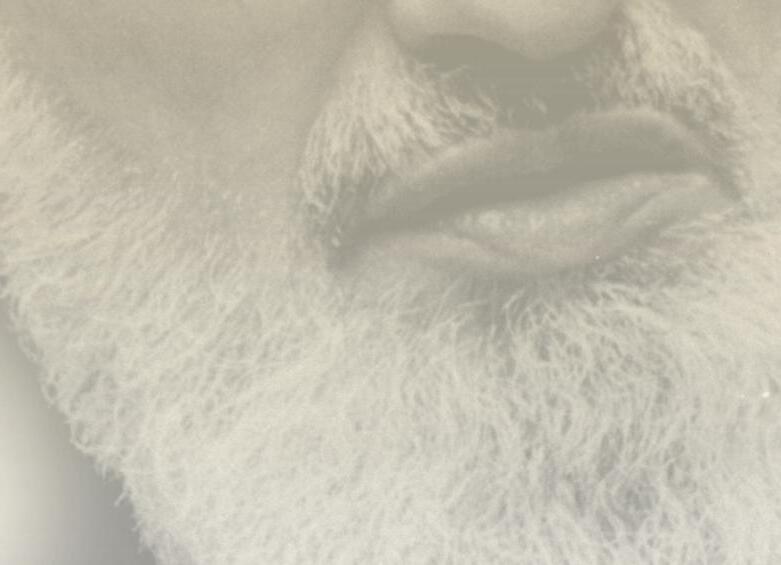




















Mesorat Harav Siddur Tefilla for the entire year Tefilla for 50th



Mesorat Harav Kinot Tefilla for Tisha B’Av

















worship that characterize the person who possesses that elusive quality of charisma . . . . Yet, like all other seeming blessings, charisma carries within it seeds of self-destruction.
The charismatic personality is likely to succumb to the temptation of believing all of the adulation showered upon him or her. In the triumphant parades of the Roman emperors, a servant rode along in the emperor’s chariot and whispered to him, amidst the din of the cheering throngs, a reminder of his past failings and future mortality. Believing in one’s own charismatic qualities builds one’s ego to ferocious heights. And an inflated ego always leads to downfall and personal defeat. It allows the guilty to eventually believe in their own perfect innocence and to expect others to do so as well. Prideful haughtiness goes before a fall, opined King Solomon long ago. Prideful haughtiness is very often a byproduct of the charismatic personality.
Similarly, Naomi Mark,14 a clinical psychologist, has written about the strong correlation between charisma and narcissism. She quotes psychoanalyst Heinz Kohut, who, describing the narcissistic personality, notes the “high energy levels, the apparent confidence and lack of self-doubt, and the strong sense of mission.” These qualities can be the very qualities that produce outstanding
leadership but become pathological when the “grandiosity, fantasies of success, lack of empathy, excessive need for attention and approval, and inability to tolerate [alternative viewpoints] interfere with the individual’s functioning in work and love.” The very character traits that make a candidate alluring and attractive may be the source of serious difficulties down the road.
There is yet another danger that charismatic leadership poses, a more subtle one that may be especially damaging to adolescent students, ba’alei teshuvah and candidates for conversion. Such leadership tends to be autocratic, controlling and disparaging of individual choice and personal autonomy (even within the bounds of halachah). These are warning signals that should not be ignored. Leadership that tries to micromanage not only institutions but individual lives is inherently suspect. At least within the non-Chassidic tradition, the role of rabbis, roshei yeshivah, teachers and spiritual mentors is to inform, educate and inspire, not to command and direct. The students/congregants are expected to think for themselves and to have the ability and maturity to make decisions and take control of their lives; the rabbi’s function is to enable and enhance the development of those capacities.
From my own personal experiences, I can say that this was very definitely the approach of my roshei yeshivah, Rabbi Yaakov Yitzchak Ruderman and Rabbi Yaakov Weinberg, as well as that of Rabbi Yaakov Kamenetsky, all of blessed memory; and this was deeply rooted in the teachings of the Alter of Slobodka. As mechanchim par excellence, they saw their role as helping the student formulate his own approach to life and not simply be an automaton blindly following either the leader or the crowd. From the disciples of the Rav, I gather that Rabbi Joseph Ber Soloveitchik was exactly the same. This indeed was historically characteristic of the Litvishe gadol. 15
Even within the Chassidic world which, to some degree, has a different mesorah, there is at least the occasional exhortation to “think for yourself.” My wife’s experience with the greatly lamented Rabbi Shlomo Twerski is instructive. He would often declare with great passion that neshamot are not cookie dough to be cut in uniform shapes and sizes but precious diamonds to be cleaned and polished, exposing the beauty and luster from within; the goal of the rebbe is to help the talmid discover the uniqueness and individuality within himself.16
Leadership predicated on personal charisma, however, does exactly the opposite; it discourages autonomy and confidence on the part of the congregant or student, fosters an unhealthy dependency and vulnerability, limits the capacity for self-expression and inner spiritual growth and, in the guise of a connection to a respected religious authority, may actually undermine the development of a personal relationship with God. Moreover, by linking one’s Judaism so closely to the charismatic personality of an individual rather than to the Torah and Hakadosh Baruch Hu, the relationship to God may be totally destroyed when the all-too-human intermediary fails or falters.
sensitivity, et cetera. In this way, he was the forerunner of the Mussar Movement founded by Rabbi Yisrael Salanter. (In fact, Rav Salanter was the disciple of Rabbi Yosef Zundel, a hidden tzaddik who studied under Rabbi Chaim Volozhin, the greatest talmid of the Gra). Indeed, the Gra, who could hardly be accused of devaluing the study of Torah, writes repeatedly that tikkun hamiddot (rectification of character) is the central purpose of our existence.18
It is equally true that in choosing a rav or spiritual mentor, one of the most important qualities to look for are middot tovot. “If the teacher is comparable to an angel of God, seek Torah from his mouth. Otherwise do not.”19 A rav is compared to the kohen,20 who in turn is described in Avot (1:12) as “ohev shalom v’rodef shalom,” “one who pursues peace and loves peace, loves all of God’s creations and endeavors to bring them close to Torah.” Indeed, Rambam codifies as a matter of halachah that one should not learn Torah from a teacher who does not follow the good path no matter how learned he may be.21 Torah is more than disembodied information. It emerges not only from the mind but from the totality of the soul. We must endeavor to find teachers who have the qualities of the soul within which Torah can reside.
Believing in one’s own charismatic qualities builds one’s ego to ferocious heights. And an inflated ego always leads to downfall and personal defeat.
Erudition, scholarship and personal magnetism are no guarantee of spirituality and inner goodness. Chazal tell us that Torah is compared to water. The Vilna Gaon (Gra) offers a fascinating explanation. Water has the capacity to cause growth of whatever seeds it happens to fall on. If the seeds are wheat, the water will cause the germination of wheat; if the seeds are poisonous weeds, the water will facilitate the growth of weeds. So too Torah learning will develop and accentuate the preexisting qualities of the soul. If one is imbued with compassion, kindness and humility, then Torah study will make him more so. If one is competitive, arrogant and self-aggrandizing, Torah scholarship will simply create another battlefield in which those qualities can be expressed.17 As such, the Gra emphasizes the need to combine analytical Torah study with conscious development of character, interpersonal
All of this suggests that communities must pay much closer attention to the moral qualities and personality traits of the leaders and role models that they choose. That certain flashy qualities might be overvalued in the selection process while other qualities—gentleness, modesty—are undervalued or even disparaged will only hurt the community in the long run.
Why does the Torah go into so much detail about the korbanot, and why is a kohen not permitted to contaminate himself by contact with a corpse? Rabbi Saul Berman22 once offered an intriguing thought. The kohen has great power; the power to effect atonement, reconciliation with the Creator. He has access to holy places that no one else may enter. He can perform rituals that no one else can perform. He is in charge of a cosmic apparatus that literally determines the survival of the world. This puts him in a position of control, and with that control comes the potential of abuse and manipulation. The antidote is transparency and accountability. Every Jew is entitled to know what the avodat hamikdash is and how the kohen performs it. The avodat hamikdash must be demystified and clearly explained so it does not become a force of control. For the same reason, the kohen effectively distances himself from people at the moment of their
greatest vulnerability and weakness, for it is precisely at those moments that the potential for manipulative control is at its maximum. Rabbi Berman suggests that these considerations have relevance to the rabbinate as well. Rabbinic rulings, procedures and standards should not be seen as arbitrary, mysterious pronouncements whose authority is grounded in personal charisma but should be explained in terms accessible to the kehillah. While it is incontestable that a rabbi must be the final halachic authority within his congregation, it is equally true that he must be able to explain his positions, his standards and his behaviors. As Justice Louis Brandeis remarked in a different context many years ago, “Sunlight is the best disinfectant.” Anything that cannot be explained was probably not justified in the first place. Rabbi Yossi aptly stated, “I never did anything for which I had to turn around and see who was watching me” (Shabbat 118b).
Numerous statements in Tanach and Chazal emphasize the importance of consulting others and learning from others, both in terms of Torah and in the practical dayto-day decisions of life.23 “Aseh lecha rav u’knay lecha chaver,” “Make for yourself a teacher and acquire for
yourself a friend/colleague” (Avot 1:6); “Eizehu chacham halomed mikol adam,” “Who is wise? He who learns from all people” (Avot 4:1) are just two of many examples. Indeed, even Hakadosh Baruch Hu “sought,” as it were, the counsel of the angels before creating man (“Let us make man”).
As great a figure as Rabbi Elazar Shach stated that it is essential that decision-making be a collaborative enterprise, that different viewpoints be shared and expressed, and he would refuse to give a haskamah to any mosad (institution), no matter how noble, where all the decisional authority was entrusted to a single individual.24 Autocratic leadership results in bad decisions, but even worse, it inculcates a sense of superiority, invulnerability and being above the law. “Do not judge alone for there is only One who is qualified to judge alone” (Avot 4:10).
But the need for a chaver and a rebbe goes well beyond the specifics of particular decisions and policies. Rabbis are professional purveyors of Judaism. “Spirituality” is their bread and butter. Paradoxically, a rabbi may be so busy marketing his religion that he has little time or energy to replenish his own spiritual batteries. And yet, one cannot truly give what one does not possess. (“That which is always giving out is unable to absorb.” 25) As one moves further and further away from the cultivation of a private intimate relationship with the Almighty, as one’s public persona
It is especially vital that we communicate to our children not to lose faith in humanity, in Judaism and in themselves . . . not to succumb to cynicism and despair.
becomes the dominant aspect of his inner reality—as indeed there may be no inner reality—one’s spiritual life becomes increasingly empty.26 When that happens, there is the real risk that the vacuum will be filled with the incessant (and ultimately self-defeating) drive for kavod, recognition, honor and ego gratification.27 And when these become our primary motivators in life, we become vulnerable. We face self-idolization at worst; at best, the empty shell of burnout. We become the “rabbis at risk” who eventually put our communities at risk.
Every soul needs to be nourished authentically, and Chazal’s admonition of “aseh lecha rav u'knay lecha chaver” is not simply practical, pragmatic advice for good decisionmaking, which it surely is, but a call for personal growth. A rabbi needs a space where he can shed the persona of the professional and be a simple person, a pashuter yid. He needs mentors and colleagues with whom he can learn and grow and, at least for a short time, escape the tensions of communal life. He needs to hear the still, small voice of God (kol demamah dakah)28 that is within him, to hear the sounds within the silence, away from the roar and the acclaim, or the derision and abuse, of the crowds, to rediscover himself and thereby find the Almighty.
Virtually every person who enters the rabbinate is a person of high idealism, devoted to God, Torah and the Jewish people—one who genuinely wants to make a difference for the good in the lives of fellow Jews and is willing to make great personal sacrifices to accomplish this mission. This is certainly true of the great majority of rabbis who perform their duties with integrity, with nary a whiff of scandal, but it is also true for the rabbis who fail. They too brought to their ministries qualities of goodness, devotion, commitment and self-sacrifice. They too have done much good, and they too have the potential to do much good in the future. To paraphrase an old commercial, “a life is a terrible thing to waste.” Although some might criticize any focus on the pain suffered by these “fallen rabbis” (i.e., who cares?), it is precisely that pain that I want to address, for there are lessons to be learned both for them and for us. It is especially vital that we communicate to our children (and that necessitates that we believe it ourselves) not to lose faith in humanity, in Judaism or in themselves; not to succumb to cynicism and despair; to hear and internalize the message that yes, even great and good people make mistakes, but in the aftermath of failure, there is the possibility, and therefore the obligation, of rebuilding.
This lesson is of such crucial importance that it may be the reason why the malchut of the Jewish nation was assigned to the Tribe of Yehuda rather than to the Tribe of Yosef. One thought that appears with some frequency in sifrei Chassidut and kabbalah29 focuses on the different ways these two personalities respond to temptation. Yosef successfully rises above sin, simply defeats it; “just says no.” We stand in awe of his moral perfection and spiritual strength. Yehuda, on

the other hand, succumbs to temptation in a moment of weakness as his descendant Dovid HaMelech does later. He fails, but through sincere and honest teshuvah and by taking responsibility for his misdeeds, he is forgiven. God wanted us to fully appreciate the awesome power of teshuvah to elevate and purify and thus chose the ba’al teshuvah over the tzaddik gamur. God’s message is one of hope, recovery and resilience.
Rabbi Yitzchak Hutner30 noted long ago that although we are very familiar with the great successes of our gedolim—their brilliance, their hasmadah (diligence), et cetera—we know much less about their struggles, their mistakes and their failures. But in many ways, knowing how they dealt with setbacks and disappointments might be far more useful and instructive than simply viewing them as superhuman and perfect. (He was thus a bit
critical of the hagiographic tendencies in the biographies of gedolim.) The true measure of greatness is growing and learning from our failures. “The tzaddik may fall seven times and rises” (Mishlei 24:16) does not mean he rises despite falling but rather it is the very confrontation with his inner demons that is the source of his greatness.
Thus, it is essential that those who fail—and those who sit in judgment on that failure—carefully ponder three points:
1. If you believe it is possible to destroy, believe it is possible to rebuild.
2. The good that a person does is not destroyed by the evil.31 A lifetime of good work, Torah scholarship and helping countless people in need is not destroyed by sin or mistake. Every person will have to give a din v’cheshbon for his aveirot, but the bad does not cancel out the good.
The good remains. The good within the person remains. It is still there. The fact that someone fails does not mean that his or her life was a failure.
A story is told that the Gra was once in prison together with a Jew who was a convicted murderer. When bread was brought to the cell, the murderer proceeded to eat without netilat yadayim. The Gra told the murderer that he is obligated to wash his hands. When his cellmate remarked that he was guilty of far greater sins than neglecting netilat yadayim and could not imagine that washing would make any difference to the Almighty, the Gra responded that one has nothing to do with the other. One may be guilty of the most heinous of sins, but God still desires that whatever good one can do, one must do. The good remains.32
3. Divine gifts come in many forms, and sometimes the gift of devastating personal failure is an opportunity to acquire humility. People can and do change as a result of confronting their inner demons. “God does not desire the strength of the horse nor the thighs of man. God favors those who fear Him, those who yearn and hope for His loving kindness” (Tehillim 147:10-11). Rabbi Tzadok of Lublin33 explains that the “strength of the horse” metaphorically refers to the energy and the effort we put forth in trying to do good in the world. The “thighs of man” refers to the self-control we exhibit in holding ourselves back from committing evil. Both are important and valuable. But both can be tainted with smugness, arrogance, ego and self-righteousness. What God treasures above all are the qualities of humility and modesty, as well as an awareness that all that we are and all that we accomplish are only by the grace and mercy of God, that left to our own devices failure is inevitable. (Thus, we need to yearn for God’s loving kindness.) It is precisely this awareness that enables us to treat others with respect, to admit when we are wrong, to be open to positive and constructive criticism and to change for the better. And it is precisely this awareness that ultimately empowers us to be a faithful conduit of Hashem’s Torah.
how they responded to the rebuke of the prophets. When the prophet Shmuel confronts Shaul, Shaul first denies the accusation (“I did the will of God”) and then blames others for his failure. By contrast, when Natan communicates to Dovid the enormity of his offense through the parable of the rich man and the lamb, all Dovid does is utter two words, “chatati laShem,” “I have sinned.” No excuses, no mitigating circumstances, no blaming of others. 36 Indeed, Dovid followed the noble example of his ancestor Yehuda who similarly stepped forward to declare publicly “tzadkah mimeni, ” “she [Tamar] is more righteous than I.”37 God does not expect our leaders to be perfect; God does expect them to take responsibility when they fail.
Divine gifts come in many forms, and sometimes the gift of devastating personal failure is an opportunity to acquire humility.
Second, teshuvah requires seeking the forgiveness of those who were wronged, primarily specific victims but including also the community as a whole that experienced significant betrayal.38 Rabbi Hutner39 eloquently explains that when a person hurts another, the damage he inflicts is not only the particular hurt the victim suffered but the fact that the victim feels psychologically violated, less secure in the world, bitter, angry, betrayed, less able to trust. The victim, in a sense, has become diminished as a person, and the perpetrator must do what he can to restore the person to his or her wholeness. Bakashat mechilah (asking forgiveness), then, is not simply an apology for the past but an attempt at restoration. And learning how to forgive is part of that restorative healing process as well. We are all weak and vulnerable, and we should look at all people with compassion and forgiveness. We must learn to forgive not only for the benefit of the sinner but for ourselves. A heart filled with anger and resentment can never move on. It is stuck. There is no room for God.
But teshuvah is neither easy nor cheap. First, teshuvah necessitates taking responsibility for one’s actions rather than denying, equivocating or blaming others. When Shaul HaMelech failed to fulfill his duty to eradicate Amalek, he was not given a second chance. He was told that the malchut would be taken from him and given to someone better and more suitable. When Dovid HaMelech, on the other hand, committed sins that were arguably more severe, i.e., adultery and murder,34 he remained king and indeed his dynasty will produce the Mashiach. Rabbi Yosef Albo35 suggests that the key distinction between Shaul and Dovid lay not in the nature of their sins but in
Third, teshuvah does not automatically mean restoration to a prior position.40 To take an extreme case, no sane person would argue that a repentant child molester should go back to teaching children. This is so for two reasons. First, it is impossible for anyone to gauge the true depth and sincerity of the teshuvah process. Second, even a sincere teshuvah may not be able to withstand a strong, overpowering temptation and the ba’al teshuvah may falter.41 We simply cannot take the chance that innocent people, especially children, may be harmed. Nevertheless, assuming we can minimize these risks, the person who takes responsibility, works to improve and sincerely seeks the forgiveness of those he harmed deserves the gift of a second chance to be of service to Klal Yisrael. All of us earnestly pray that God will give us these chances when we need them. God shows us the compassion that we are able to show to others.42 g
The sin of a spiritual leader, especially when that sin becomes known to the public, carries a much greater level of severity. In addition to the sin itself, there is a chillul Hashem, a desecration or profanation of God’s name, as the rabbi’s misconduct brings shame and disgrace on the Torah.43 This would even be the case if the misbehavior would not otherwise be a serious sin (e.g., rudeness in the checkout line or cutting someone off in traffic), and the chillul Hashem is obviously compounded by the gravity of the offense. According to Rambam,44 one who is guilty of chillul Hashem has no atonement (kaparah) until the day of death. Neither teshuvah nor Yom Kippur nor even suffering can erase the stigma of the sin. Standing alone, this ruling might suggest that although teshuvah is a necessary component for forgiveness, it is insufficient; there is literally no atonement possible within the confines of Olam Hazeh. However, this ruling does not, in fact, stand alone and other factors must be considered. There are at least five halachic arguments that suggest that even the sin of chillul Hashem is amenable to sincere teshuvah.
First, Rabbeinu Yonah of Gerona, 45 in his classic work Shaarei Teshuvah (a work that the Chofetz Chaim consistently treated as an authoritative halachic—not just mussar—source), posits that even the perpetrator of chillul Hashem can receive atonement by dedicating his life to kiddush Hashem, acts of loving kindness and intensive Torah study, that God in effect gives the penitent the chance to repair the desecration of God that he caused by bringing glory and honor to the Almighty’s name.
Second, even Rambam himself seems to concede that sincere teshuvah restores man’s relationship with God, irrespective of the magnitude of the sin, apparently including even chillul Hashem. In chapter 7 of Hilchot Teshuvah, Rambam writes: Teshuvah is great for it draws a man close to the Shechinah . . . . Teshuvah brings near those who were far removed. Previously, this person was hated by God, disgusting, far removed and abominable. Now, he is beloved and desirable, close and dear. How exalted is the level of Teshuvah! Previously, the [transgressor] was separate from God, the Lord of Israel, as (Isaiah 59:2) states: “Your
sins have separated between you and your God.” He would call out [to God] without being answered, as (Isaiah 1:15) states: “Even if you pray many times, I will not hear.” He would fulfill mitzvot, only to have them crushed before him, as (Isaiah 1:12) states: “Who asked this from you, to trample in My courtyards,” and (Malachi 1:10) states: “‘O were there one among you who would shut the doors that you might not kindle fire on My altar for no reason! I have no pleasure in you,’ says the God of Hosts, ‘nor will I accept an offering from your hand.’” Now, he is clinging to the Shechinah, as (Deuteronomy 4:4) states: “And you who cling to God, your Lord.” He calls out [to God] and is answered immediately, as (Isaiah 65:24) states: “Before you will call out, I will answer.” He fulfills mitzvot and they are accepted with pleasure and joy, as (Ecclesiastes 9:7) states: “God has already accepted your deeds,” and (Malachi 3:4) states: “Then shall the offering of Judah and Jerusalem be pleasing to God as in the days of old and as in the former years” (translation by Rabbi E. Touger).
In contradistinction to chapter 1 where teshuvah’s power of atonement is quite limited, chapter 7 describes teshuvah as completely transformative and purifying, fully restoring a relationship of love with the Almighty, allowing the ba’al teshuvah to find favor and grace in God’s eyes once again. Apparently, the need for atonement (kaparah) in chapter 1 is connected to a spiritual “debt,” a liability that is owed for the sin, a punishment that must be expiated—a burden that is not erased until death, and one that the ba’al teshuvah must always carry in his heart—but the existence of that debt/liability is not relevant to the purity of the penitent’s soul and his reacceptance into the community of God and Israel, provided he complies with the requirements of the teshuvah process, e.g., seeking forgiveness from victims, et cetera.46 It is only the kaparah aspect of teshuvah that is limited; its power of taharah (inner spiritual purity) is boundless, limited only by the sincerity of the sinner and the depths of his contrition and resolve. Three other arguments, less rooted in the language of Rambam and Rabbeinu Yonah, are presented in the footnote.47
Notes
1. See Rambam, Hilchot Teshuvah 4:4, where he discusses the very great sin of getting honor, i.e., smug satisfaction, out of the downfall or humiliation of others (mitchabeid b’klon chaveiro). This is often described by the German word “schadenfreude.”
2. Mesira is the prohibition of one Jew “informing” on another Jew by notifying non-Jewish authorities. See Rambam, Choveil U’Mazik 8:9-10. The moser (informer) was such a despicable person that he could be summarily executed. Some have applied the concept of mesira to prohibit the reporting of abuse to secular law enforcement, but this is an error. See the ruling of Rabbi Yosef Shalom Elyashiv in a 2004 letter to Rabbi Feivel Cohen, Kovetz Teshuvot III, no. 231. I am not addressing the very controversial question of whether a rav needs to be consulted first. Compare Rabbi Yosef Gavriel Bechhofer’s article in Jewish Action (“Discovering Rav Elyashiv,” summer 2013) and the subsequent letter to the editor by Ben Hirsch appearing in the fall 2013 issue.
3. As important as the laws of lashon hara are, they cannot stifle the need to redress evils and prevent harm. The Chofetz Chaim discusses at great length when and how a person who has suffered harm by the actions of another party may discuss that harm with others in order to prevent its reoccurrence in the future. See Chofetz Chaim, Laws of Lashon Hara, Klal 10, par. 11-14. He further suggests that there may be (“efshar”) a separate positive and legitimate benefit in enabling people to express their fears, anxieties and resentments if this could bring them to a certain degree of inner healing and closure, citing the verse in Mishlei 12:25 (as interpreted by Yoma 75a): “If there is worry in the heart of an individual, let him share that worry with another.”
4. As employers seek to minimize liability for sexual harassment claims, companies are adopting increasingly strict workplace codes concerning dress, workplace romance, seclusion with the opposite gender, over-familiarity, suggestive flirtatious speech, et cetera. As strange as it may sound, modern employee handbooks are beginning to resemble the “outdated” rules of the Shulchan Aruch
5. The story of Dovid and Batsheva is, of course, the classic example. See II Samuel 11-12. Much of the Book of Mishlei warns the wise son to avoid sexual temptation. See, for example, Mishlei 2:16-19; 6:24-35; 7:5-27 and 9:13-18. While these verses do have allegorical or symbolic meanings, “Ein mikra yotzei midei peshuto, ” “The straightforward interpretation is not displaced,” and these warnings are to be taken literally as well. Similarly, Ketubot 13b teaches,“Ein apotropus l’arayot, ” “There is no guardian in matters of sexuality,” i.e., no one can be trusted. We must all take precautions. In Kiddushin 81a, the Talmud recounts three separate stories of great rabbis—Rabbi Amram Chasida (the pious), Rabbi Akiva and Rabbi Meir—each having almost uncontrollable lust for a beautiful woman. All three of these righteous and holy men were on the verge of succumbing to temptation, pulling away only at the last minute.
6. See Shulchan Aruch, Even Haezer 21:1, 21:6 and 22 for the basic halachic guidelines governing the relationships between men and women.
7. Sanhedrin 21b (explaining why the Torah generally does not give the reasons for its commandments, so that people should not argue that the reasons do not apply to them when, in fact, those reasons would).
8. Berachot 29a. While not relevant here, there is considerable discussion whether this Yochanan might be the father of
Matityahu, the hero of the Chanukah story. If indeed he was, this might explain why Matityahu was so opposed to the Hellenism prevalent in Eretz Yisrael. He saw firsthand how it destroyed the righteousness of his father.
9. I believe I heard or read this story from Rabbi Moshe Wolfson but cannot presently locate the source.
10. A further example of the dangers that power poses to the integrity of spiritual leadership may be gathered from the words of Ramban. In pointing out why the Hasmonean dynasty was ignominiously eradicated although its founders were righteous, Ramban, Bereishit 49:10, offers two explanations. The first, and better known, is that it was sinful for any tribe other than Yehuda to assume the monarchy. After the Maccabee victory, a king should have been appointed from the Davidic, or at least from the Yehuda, line. But the second answer, based on the Jerusalem Talmud, is that there is a discrete, unique prohibition for a kohen to serve as a melech. While no explanation is offered, one might suggest that there is an inherent risk in giving spiritual leaders too much power in the political realm. The need to separate church from state is not to protect the state from the teachings of religion but to preserve the integrity of religious ideals from the corrosive effect of power and manipulation. Interestingly, in 1980, Pope John Paul II promulgated a similar policy prohibiting clergy from holding political office, resulting in the forced retirement of Congressman Robert Drinan, who was also a Jesuit priest. Ramban’s words also have interesting implications for Israeli politics.
11. See Derashah III, p. 38 (Feldman Hebrew Edition). The Ran’s









Kosher Food • Mikveh • Eruv Orthodox Synagogues Jewish Schools
The Hebrew High School of New England Sigel Hebrew Academy
Jewish Federation of Greater Hartford Mandell Jewish Community Center

actual explanation is a bit different than mine. He states that had Moshe been an eloquent, articulate speaker, future generations might not be convinced of the Divinity of the Torah. They might attribute the beliefs of their ancestors to Moshe’s charismatic abilities. By contrast, if Moshe lacked those abilities but the people were still convinced, that fact establishes the Torah’s veracity as the word of God. My point, building on the Ran, is that charisma also distorts the messenger and can subtly change the message so that, in fact, it may not be the Divine teaching in its purest form.
12. See commentary of Rabbi Samson Raphael Hirsch in The Hirsch Chumash, Devarim 34:6.
13. Rabbi Berel Wein, “Charisma,” www.rabbiwein.com.
14. Naomi Mark, Ph.D., “Charisma and Narcissism in the Jewish Community,” www.shma.com. Mark’s article was part of a symposium on the issue of charisma and leadership published by the online journal Sh’ma, A Journal of Jewish Ideas, in December 2006. The journal had a second symposium on the topic in March 2009. All of the articles are well-worth reading and may be accessed at the Sh’ma web site.
15. See commentary of the Vilna Gaon, Mishlei 16:4 (“Train a child according to his way”) and, more generally, anecdotes in Rabbis Berel Wein and Warren Goldstein’s The Legacy: Teaching for Life from the Great Lithuanian Rabbis (Jerusalem, 2013).
16. Special note should be taken of the inspiring words of Rabbi Tzadok HaKohen that just as one must have faith in the Almighty, so too must one have faith in oneself. See Tzidkat HaTzaddik, par. 154. See also the wonderful story reported at www.chabad.org where the Lubavitcher Rebbe tells Rabbi Dr. Tzvi Hersh Weinreb, “Sometimes you need to know how to talk to yourself.”
17. Commentary of the Vilna Gaon, Mishlei 19:9 and Even Shleimah (annotated anthology of teachings of the Gra compiled by Rabbi Shmuel Maltzan and supplemented by his son Rabbi Yitzchak Maltzan), 1:11.
18. Commentary of the Vilna Gaon, Mishlei 4:13 and Even Shleimah 1:2.
19. Chagigah 15b. The gemara then proceeds to discuss the difficult question of how Rabbi Meir continued to learn from Elisha Ben Abuya even after he became the heretic known as Acher, literally “the Other.” It concludes that Rabbi Meir treated Acher like a pomegranate, throwing away the rind and consuming only the seeds. Although Acher was guilty of heresy, Rambam seems to say that the prohibition of studying Torah from an unfit person is not limited to teachers who are heretics but applies equally to those of bad moral character. See Rambam, Hilchot Talmud Torah 4:1. See also commentary of Lechem Mishneh who asserts that we are not on the level of Rabbi Meir to be able to avoid the negative destructive influence of an improper teacher and role model.
20. Malachi 2:7 (“For the lips of the kohen shall preserve knowledge and people should seek Torah from his mouth for he is an agent [malach] of the Lord of Hosts”). Note the dual appellation: kohen and malach, which also means “angel.”
21. Rambam, Hilchot Talmud Torah 4:1.
22. I read this a number of years ago but have not been able to retrieve the source. The idea is cited in his name in an article by Rabbi Shmuly Yanklowitz, New York Jewish Week, May 15, 2012.
23. Exposure to different viewpoints and perspectives is critical in Torah study. See, for example, Berachot 63b: “Words of Torah are acquired only in a group”; also Baba Metzia 84a, depicting Rabbi
Yochanan’s grief upon the death of Rabbi Shimon Ben Lakish, who constantly challenged him. See also Maharsha, Sanhedrin 42b, who refused to record the chiddushim that were not discussed in the yeshivah. But Chazal saw great value in consultation in all areas of life. According to Tiferet Yisrael, the famous aphorism “The best of the doctors will go to Gehennom,” Kiddushin 82a, refers to a doctor who fancies himself such an expert that he disdains consultation with his inferiors. If, as a result of this arrogance, the patient suffers, the doctor is morally responsible. Similarly in marriage, it is precisely the fact that men and women see the world in different ways, with each bringing insights that the other does not possess, which enables the emergence of a greater and deeper truth. One should not seek a “yes-spouse” or clone. This is the meaning of ezer kenegdo—a helpmate that is opposite. See Shem MiShmuel, end of Parashat Lech Lecha.
24. Interview with Rabbi Ahron Lopiansky, Mishpacha, December 30, 2014.
25. This phrase is actually a technical principle in the laws of kashrut that states that a food that is in the process of conveying (“expelling”) its taste may, under certain conditions, be incapable of absorbing a taste from something else. See Mishnah Terumot 11:10 and Chullin 110b. It has been metaphorically borrowed to express the idea that the person constantly involved in “putting out” Judaism may have some difficulty taking it in.
26. It is recorded that Rabbi Simcha Zissel Ziv, the Alter of Kelm, famed disciple of Rabbi Yisrael Salanter, had certain special Torah insights that he kept to himself as part of his internal spiritual inventory. Even people totally devoted to the klal must have an avenue to foster and nurture their personal and unique relationship with God.
27. Arrogance can thus be both the cause of spiritual failure and a

consequence of it, i.e., an illusory attempt to compensate for an inner spiritual void.
28. This beautiful phrase is taken from I Kings 19:12. According to Rabbi Chaim Lifshitz, it should be translated as a “delicate sound of stillness” and refers to the “consciousness and awareness of the self” and its connection to the Divine. See www.sadnatenosh.org.
29. See, for example, Sefat Emet, Vayigash 5648 and Vayechi 5653 and 5657; Peri Tzaddik, vol. 5, first essay on Hoshanah Rabbah, p. 128b (standard Hebrew edition available on Hebrewbooks.org); Ohr Gedalyahu, Parashat Vayigash. These sefarim advance the point that a king in Israel is supposed to be a spiritual role model for the nation. Sometimes, the best role models are not those who are so perfect that they never fail but those who struggle with flaws, make mistakes, exhibit moral weakness but then come back through teshuvah. I can identify with those who fail for I too fail. I can be inspired by those who repent for I too can repent.
30. Pachad Yitzchak, Iggerot U’Michtavim, Letter 128.
31. Rambam in his commentary to Avot 4:22 writes that if a person does 1,000 mitzvot and 1,000 aveirot, the aveirot and mitzvot do not cancel each other out; rather, Hashem maintains a separate registry of good for which there shall be reward and a separate registry of sin for which there will be accountability. Rambam’s assertion that even if a person has 1,000 mitzvot, those mitzvot will not cancel a single aveirah, seems to contradict his position in Hilchot Teshuvah, chapter 3, where he writes that a person is judged by the majority of his deeds (as determined by a special Divine weighing. The calculation is not strictly a numerical one). If, after the application of this Divine weighing, an individual has more good deeds than sins, he immediately goes to Olam Haba, and the sins in the minority category are apparently ignored or erased. This is in direct contradiction to his teaching in Avot. The matter needs








OU TOrah is proud to announce that a daily class on mishnah Brurah, widely accepted as the definitive work on practical halacha, has joined the site’s daily online shiurim. the shiur is delivered by rabbi aaron e. glatt, mD.
oU torah now comprises dozens of programs in text, audio and video format. With sections on Parsha, mishna and gemara, kashrut, Jewish thought and so much more, there’s something for everyone at
further study.
32. See Rabbi Dovid Eliach, Ha’Gaon, vol. II, pp. 560-564, where a number of stories of this nature are recorded.
33. See Peri Tzaddik, vol. 5, Parashat Vayeilech [11], 99b.
34. I am, of course, aware of Chazal’s statement that anyone who says Dovid sinned is mistaken (see Shabbat 56a). But it is equally clear from the Biblical rebuke of the prophet that regardless of the technical justifications Dovid may have had for his actions (i.e., Batsheva had received a get; Uriah had disobeyed a direct royal order), he was spiritually guilty of both adultery and murder and, indeed, Dovid himself admitted that he sinned.
35. Sefer HaIkkarim, fourth essay, chap. 26. Commentators offer two other distinctions between the sin of Shaul and that of Dovid (indeed one of these answers is offered by Rabbi Albo himself), but these distinctions pertain more to the issue of reinstatement and restoration to office rather than the efficacy of the teshuvah itself. See notes 38 and 44.
36. Compare I Samuel 15:13-21 (Shaul’s equivocation) with II Samuel 12:1-13 (Dovid’s simple, heartfelt acknowledgement of guilt).
37. Genesis 38:26.
38. Rambam, Hilchot Teshuvah 2:9-10.
39. Pachad Yitzchak, Yom Kippur, Essays 2-3, 30.
40. The idea that teshuvah alone may be insufficient for reinstatement finds some support in Rambam, Hilchot Edut 1:5-8. Witnesses who have become disqualified due to wrongdoing are not reinstated merely by renouncing the wrongdoing but only by totally distancing themselves from the source of their temptation. Thus, if they were gamblers, they cannot use dice even if no money changes hands. If they bet on bird races, they must break their traps and not even keep the birds as pets. Even after a sincere teshuvah, the penitent and therefore the community cannot be confident that there will not be a relapse. The ba’al teshuvah must avoid the behaviors that precipitated failure in the past. It is notable, however, that this is not a halachic requirement in Hilchot Teshuvah but rather a condition for reinstatement in Hilchot Edut. The teshuvah is complete as long as there is regret of the past and resolution for the future that is properly expressed by vidui (confession to God) along with bakashat mechilah (asking forgiveness of those who were harmed).
41. There are two additional arguments that may support a nonreinstatement policy even in the face of an apparently sincere teshuvah. 1. In addressing the question of why Dovid’s teshuvah was accepted while Shaul’s was not, Rabbi Albo notes that Dovid’s sin was personal immorality. With teshuvah, the sin could be forgiven and his office could be restored. By contrast, Shaul’s sin of not eradicating Amalek was a failure to carry out the responsibilities of his position. A serious breach of his communal responsibility might disqualify him from the communal office, notwithstanding his teshuvah as an individual. (This is an additional answer to the one cited in the text at note 35.) 2. See also Meshech Chochmah, Parsahat Vayeilech (on the haftarah “Shuvah Yisrael”) where Rabbi Meir Simcha argues that Shaul’s aveirah was public, thus constituting a chillul Hashem in the eyes of the nation, while Dovid’s sin was discreet and private. The chillul Hashem of a sin may be many times more severe than the actual sin itself, and where there is massive chillul Hashem, as in the case of Shaul, the offender must be removed from his position. This is true notwithstanding the fact that in the very same piece, Rabbi Meir Simcha asserts that teshuvah at the moment of Neilah does atone for chillul Hashem. Apparently, kaparah/taharah in the face of chillul Hashem may be insufficient for reinstatement, at least in the case of a melech. See note 47.
42. Shabbat 151b.
43. Rambam, Hilchot Yesodei HaTorah 5:11 (definition of chillul Hashem and the higher standard for the rabbi/talmid chacham).
44. Hilchot Teshuvah 1:4, based on Yoma 86a.
45. Fourth Gate, par. 4-5, 16.
46. The distinction between kaparah (atonement), which is a mechanism for the expiation of liability and punishment, versus taharah (purity), which refers to the restoration of a loving relationship with God, is based on the Torah of the Rav. See Rabbi Joseph B. Soloveitchik, Al HaTeshuvah (adaptation by Rabbi Pinchas Peli), pp. 15-33 in the Hebrew edition, pp. 57-74 in the English. The Rav does not directly use this distinction to resolve the contradiction between chapters 1 and 7. I believe, however, that his distinction provides the basis of an answer.
47. The three additional answers are the following: 1. Some differentiate between teshuvah m’yirah (repentance out of fear of punishment) which cannot cleanse the sin of chillul Hashem and teshuvah m’ahavah (repentance out of love) which has a greater transformative power and can. 2. Others suggest that at the time of Neilah, teshuvah can be a kaparah even for chillul Hashem because that is the only time that God sits in judgment alone, without the aid of the Heavenly Court, and can therefore forgive the sins against His own majesty—something the Heavenly Court would be unable to do. See Meshech Chochmah, Parashat Vayeilech (on the haftarah “Shuvah Yisrael”) and notes 35 and 41. 3. Finally, it is recorded in sifrei Chassidut and kabbalah that when Yom Kippur and Shabbat come together, the power of atonement is magnified and will be effective even for chillul Hashem. Suffice it to say, however, that none of these three additional approaches has textual support in the language of either Rambam or Rabbeinu Yonah but are offered as interpretive possibilities.



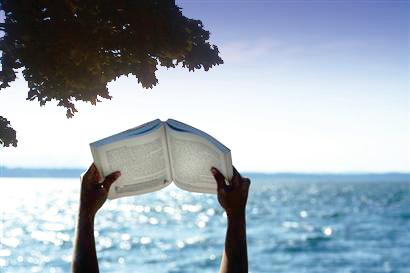
to relax.
This summer, switch to The Berkshire Bank and experience unparalleled service and banking you can rely on, all year round.
www.berkbank.com
BY BARBARA BENSOUSSAN
This is a tough time to be a rabbi,” lamented Rabbi Shaul Robinson of Manhattan’s Lincoln Square Synagogue in a recent derashah following the latest rabbinic scandal. “All rabbinic reputations have been diminished.”
Any unsavory incident that involves rabbis or community leaders is one too many. Rabbis are the people we look to as models of spirituality. When they fail, their victims include not only those who were directly violated, but entire communities whose trust in religion and humanity may be permanently shaken. Furthermore, they besmirch the reputations of their colleagues, the vast majority of whom are exemplary individuals who work tirelessly for the community, often at great personal sacrifice. “The impact is terrible; it creates such cynicism,” says Rabbi Elazar Muskin of the Young Israel of Century City in Los Angeles. “We
feel all eyes upon us even more than usual, and we have to work harder to gain faith.”
Moral outrage and hand-wringing are natural first reactions when we find scandals splayed across the morning’s headlines. But stewing in indignation isn’t productive. We must recognize that all people—even spiritual leaders—can falter, and as a community, we must rally together to identify the factors that contribute to failure, and put the best possible preventive measures and boundaries in place.
Some factors, obviously, are beyond our control. Today we live in a wider social climate that incites behaviors once kept firmly behind closed doors. Dr. David Pelcovitz, a psychologist and instructor in pastoral counseling at Yeshiva University’s Rabbi Isaac Elchanan Theological Seminary, notes that in earlier generations, a person who wanted access to racy literature had to drive to a seedier side of town and bring it home in a paper wrapper. Today, such material—
Barbara Bensoussan, M.A., is a contributing editor of Mishpacha magazine. She is the author of the young adult novel A New Song (New York, 2006) and the cooking memoir The Well-Spiced Life (Lakewood, New Jersey, 2014), has worked as a university instructor and social worker, and currently writes for Jewish newspapers and magazines.
infinitely more available, inventive and graphic—is accessible through the phone in one’s pocket. Those same phones and other Internet-connected devices allow for a secrecy of communication and range of contact unheard of even twenty years ago (such as texting, e-mail and social media). On the other hand, as Rabbi Dr. Tzvi Hersh Weinreb, OU executive vice president, emeritus, points out, “The technology that makes it easier for people to get into trouble also makes it easier for them to get caught.”
Our collective tolerance for bad behavior has also risen. CUNY sociologist Dr. William Helmreich, author of numerous books that include What Was I Thinking? The Dumb Things We Do and How to Avoid Them, points to examples like the infidelities of Tiger Woods and Bill Clinton, both of whom continue to command large fees for appearances, as well as steroid use among professional athletes, many of whom enjoy continued success and popularity. In the Orthodox world, we are often quick to condemn breaches of ritual observance, like eating in a McDonald’s, but are more forgiving of lapses in less public areas like business ethics or marital fidelity. “Perhaps that’s because most religions profess some version of mitzvot bein adam l’chaveiro, whereas our mitzvot bein adam l’Makom distinguish us as Jews [kashrut, Shabbat, et cetera],” Dr. Helmreich speculates. “So the guy who eats in a nonkosher restaurant isn’t going to get Maftir in shul, whereas the guy who cheated in business will.”
A couple of generations ago, Dr. Helmreich notes, Jews felt less comfortable in broader society. They were recent immigrants or children of immigrants; the anti-Semitism of their countries of origin created a fear of persecution that kept bad behavior in check. “Jews used to feel they had two strikes against them,” he says. Several generations later, we are both more comfortable with and more assimilated into non-Jewish culture.
But despite the challenges of modern times, says New York psychologist Dr. Michael J. Salamon, scandals are endemic to every society. “Abuse was always prevalent, and the research shows it. In my practice, I see people in their eighties who were abused as teens, and women who suffered abuse in seminaries in the 1960s,” says Dr. Salamon, who is the author of Abuse in the Jewish Community: Religious and Communal Factors. “In yeshivah dorms, there were always some situations. My father went to yeshivot in Europe, and he told me there were issues there too.” In earlier times, however, unpleasant incidents were covered up and confined to the private sphere. Rabbi Weinreb relates that when Rabbi Yaakov Yitzchok Ruderman, the founder and former rosh yeshivah of Ner Israel Rabbinical College in Baltimore, was asked how domestic abuse was handled in the Old Country, he replied, “I am ashamed to say it, but we dealt with domestic violence by closing our shutters so that we wouldn’t hear it.”
While no trouble is good trouble, Debbie Fox, LCSW,

“The technology that makes it easier for people to get into trouble also makes it easier for them to get caught,” points out Rabbi Dr. Tzvi Hersh Weinreb, OU executive vice president, emeritus.
the founder of Magen Yeladim Child Safety Institute in Los Angeles, which seeks to prevent abuse of children, draws a distinction between offenders who are morally reprehensible but not criminal, such as men who are unfaithful or suffer from a related addiction, and offenders like pedophiles or others who face criminal prosecution if caught. Being unfaithful, she says, “is morally wrong and against halachah, but not illegal.”
Whenever there is an imbalance of power—for example, a rabbi getting involved with a vulnerable congregant—the potential for abuse is created. “The congregant who wants to seduce the rabbi sees him as the star; she wants a piece of his power, of what he represents,” Dr Salamon says. But that star-struck congregant is easily taken advantage of.
Are there ways to identify rabbis who are likely to get in trouble, before the trouble starts?
Unfortunately, many psychologically vulnerable people are drawn to professions they shouldn’t be in, like a moth to a flame. Dr. Yisrael Levitz, founding director of the Family Institute of Neve Yerushalayim in Jerusalem, points out that many people with perversions are often particularly attracted to chinuch, youth work or outreach specifically because of the opportunity to work closely with children and young people. Dr. Helmreich gives another example: “The head of the New Jersey Suicide Prevention Bureau committed suicide. The very people who call for strict enforcement sometimes use that strictness as an attempt to deal with their own urges or cover them up.”
Perpetrators of abuse are often hard to pick out in a crowd. “We think of abusers as creeps,” says Dr. Shira Berkovits, a psychologist who has specialized in abuse and serves as a WINGS youth consultant for the Karasick Department of Synagogue Services at the OU, a program developed to help
guide synagogues. “But that’s misguided—they look and act like everyone else.”
“There’s no one defining character flaw for abusers,” Dr. Salamon says. “That would certainly make it easier! But there are some warning signals: difficulty making friends, a hot temper, difficult marriages. About twenty percent of people who are child abusers were abused themselves as children. Once a pedophile is active, there’s really no treatment; you might be able to help if you catch them before they begin the abuse. But the person has to be man enough to admit to his weakness.”
doing it,” he remarks, “and many rabbinical schools are beginning to as well. There are tests which raise red flags, and we’re better off not setting up people for failure—or congregations for abuse.”
"We Jews have no doctrine of papal infallibility. While we expect a lot, and should expect a lot, from our rabbis, even Moshe Rabbeinu made mistakes."
Although Dr. Levitz has been directing a rabbinic counseling program at YU’s Caroline and Joseph S. Gruss Institute in Jerusalem for many years, he’s not sure it’s possible to fully weed out problematic

“Many effective rabbis are charismatic people,” says Dr. Pelcovitz. “They may be idolized in their community . . . but too much of that may lead a rabbi to start believing too much in his own abilities and developing a distorted [view of] self-importance.” Courtesy of Yeshiva University
students before they receive semichah. “I’m not sure we know enough to be able to screen future abusers,” he says. “Unless a person has a flagrant character or personality disorder, it’s hard to identify a future abuser. Nor is Torah scholarship alone a guarantee against future abuse. There are learned rabbanim who were excellent yeshivah students, yet years after receiving semichah they became involved in the most shocking acts of abuse!”
“A rabbi has to be more than somebody who can learn,” Dr. Salamon emphasizes. “He has to have compassion and awareness for his position and his congregants.”
Rabbi Mark Dratch, executive vice president of the Rabbinical Council of America (RCA), believes that despite the difficulties of identifying every possible offender, rabbinical schools should attempt to conduct psychological screenings of candidates. “The Catholic Church is
Shuls may also wish to look carefully at the references of their rabbinical candidates, although it’s obviously harder to learn much if the person doesn’t have experience yet. Rabbi Ronald Schwarzberg, the director of rabbinic placement at RIETS, says his office is “a vehicle to help the search committee do a professional job in searching and vetting candidates. We provide them with many tools to do this with as much accuracy and professionalism as possible.” He adds that candidates need to research the congregation as well. “The rabbi and congregation is a shidduch and must be treated with the same sensitivity.”
Fox took a workshop with a human relations group about interviewing job candidates, where participants learned how to ask questions about boundary-related issues. She suggests applicants for rabbinic positions be shown the shul’s policies in the interview process, so that interviewers can observe the reaction. “There are also comprehensive evaluations available,” she says, although they may not be practical for every congregation: “They involve fifty hours of testing that includes interviews, a full history and physiological measures such as lie detector tests.”
Rabbi Muskin, however, reminds us that “rabbis are human! We Jews have no doctrine of papal infallibility. While we expect a lot, and should expect a lot, from our rabbis, even Moshe Rabbeinu made mistakes.” To understand why a rabbi might fail, it’s important to look at two aspects which often interconnect: the rabbi’s own personality and inclinations, and the rabbi’s job within the community.
By definition, the leader of a community occupies a privileged place. “Many effective rabbis are charismatic people,” says Dr. Pelcovitz. “They may be idolized in their community and receive a lot of positive feedback, but too much of that may lead a rabbi to start believing too much in his own abilities and developing a distorted [view of] self-importance. If he connects closely with a congregant who is vulnerable or insecure, and there’s nothing to keep him in line, it can be a lethal mix.” A rabbi or leader who has become too taken with his own charms may develop an arrogance or a sense of omnipotence that tells him he won’t get caught (or prosecuted), or which prevents him from seeing his own tragic flaws and seeking help.
Dr. Michelle Friedman, an associate professor of psychiatry at New York’s Mount Sinai Hospital and director of pastoral counseling at Yeshivat Chovevei Torah Rabbinical School in New York, says rabbinic slip-ups are not necessarily predatory; they can come about because of the inti-
mate nature of rabbi-congregant interactions. “The job requires rabbis to be up close and personal with people,” she says. “There’s an intimacy that can become established even without physical contact.” Counseling congregants in need, helping people through a loss, assisting with a conversion, working late to prepare food packages for Tomchei Shabbos—all these activities create close ties. Dr. Levitz notes the dangers when a rabbi begins to see himself as the “savior” of a vulnerable female congregant with a problem; he may become overly involved and flattered by her idealization of him, while she may be drawn to the knight in the shining kippah “Though it is important for a rabbi to be warm and empathetic, he needs also to be very cognizant of the requisite boundaries between himself and a vulnerable congregant who turns to him for help. In the event that he finds himself becoming too emotionally involved with one of his congregants, he should get supervision from either a competent mental health professional [outside of his congregation] or a seasoned colleague,” Dr. Levitz says.
The lure of a close relationship with a congregant may hold particular appeal because a rabbi’s job can be a lonely one. Given the loneliness and stress of rabbinic work, “rabbis often experience periods of fatigue and burnout. This affects their judgment and makes them more vulnerable to the lure of close relationships with congregants.” One might expect rabbis in small communities to be particularly vulnerable to loneliness, but Dr. Levitz says big-city rabbis are equally at risk.
To this end, Rabbi Schwarzberg says that standard rabbinical contracts should include provisions for rabbinic downtime, with one day off a week, occasional “off-Shabbatot” and four weeks of vacation. “I am a proponent of encouraging our rabbis to use their vacation time and to take breaks,” he says. “Rabbis are on twenty-four/seven, and this takes its toll on their mental health. It’s a very grueling profession, and is most rewarding when we are physically and mentally healthy.”
Dr. Pelcovitz teaches three classes in pastoral counseling at YU, helping rabbinical students understand the kinds of situations they may be confronted with. “The eye sees what the mind knows,” says Dr. Pelcovitz; a person can only recognize a phenomenon he’s been prepped in advance to see. “Hence,” he continues, “rabbis need training in self-awareness, in learning to recognize their own hooks and triggers. A rabbi can begin helping a congregant, and his motivation is pure, but then he finds it’s invading his mind—it has triggered something in his psychological makeup.” The result, he says, is that the rabbi may either begin avoiding the congregant, giving too little help, or become over-involved in helping.
Dr. Friedman believes it’s not enough to simply tell rabbinical students about psychological dynamics like transference and countertransference; they need
educational encounters that, as she puts it, “allow you to find out where your own kishkes are, to learn your own red flags.” Rabbinical students also need training in emotional learning. Hence, she promotes her students’ participation in process groups with a mental health professional from outside the faculty. “You can’t just read about these things; you have to feel them,” she says. “We want our rabbis to be special and holy—their wives as well—but semichah training in general doesn’t prepare them for the moments of darkness that they will inevitably experience.
“Rabbis have a demanding job that can be stressful, and we want them to get emotionally close to congregants and their kids. But when that happens, there can be crushes, even just moments of tenderness, and rabbis need to be prepared for that wobbliness. They have to be prepared to remain the grown-up in the room, and hold on to the appropriate boundaries.”
Similarly, Dr. Levitz teaches a rabbinic counseling course to semichah students at YU’s Gruss Kollel in Jerusalem.

At YU's rabbinical training program, students role-play while learning about physical, psychological and sexual abuse. Courtesy of Yeshiva University
The course not only deals with counseling skills, but also with the importance of maintaining professional boundaries and the potential consequences of not doing so. An important component of the course focuses on physical, psychological and sexual abuse. Students are exposed to material which allows them to strongly empathize with the pain of the victims. “These are gut-wrenching sessions,” he admits. “But I don’t want the topic to be abstract. I want these future rabbis to understand the tragic consequences of abuse and empathize with the pain of the victims.” Then he challenges them with such dilemmas as, “What do you do if the accused abuser is an honored member of your shul?”
While dealing with the challenges of their work, rabbis need support and supervision just like other professionals who work in mental health. “A rabbi needs peers and mentors to speak with,” Dr. Levitz says. “It can help to

“Rabbis need better peer-to-peer networks and mentoring for dealing with personal, professional and communal challenges,” says
prevent him from making tragic judgment errors, getting overly involved or crossing a red line. It’s helpful to have someone who is in the know about the rabbi’s struggles, because secrecy allows for easier boundary crossing.”
“Rabbis need better peer-to-peer networks and mentoring for dealing with personal, professional and communal challenges,” says Rabbi Dratch. “There are support groups for rebbetzins today as well, to help them deal with the frustrations and challenges.” He advises that rabbis learn to create balance and share in their leadership role; while different rabbis will have different styles of leadership, the congregation should have ways to challenge the rabbi without undermining his authority.
In addition to the psychological training and support our rabbis need, halachic and actual physical boundaries do much to avoid slippage.
“Basic hilchot yichud [the prohibition against being alone with members of the opposite sex] create important boundaries,” Dr. Pelcovitz notes. Respecting halachic guidelines in avoiding familiarity between men and women who are not related helps avoid a slippery slope—for example, a rabbi should avoid inappropriate remarks to a woman, such as, “You look great in that dress.”
Dr. Pelcovitz knows rabbis whose office doors include a window; one rabbi installed a video camera with no audio. “There’s a rabbi I’ve met with professionally several times, and he always checks [to make sure there are others] in the building when we meet,” Fox says. “Another told me he will make appointments through texting, but that’s all—no jokes, no ‘how-are-you’s’ to women. Issues like whether it’s appropriate for a man to text a woman at 11:00 at night are still under discussion in many circles.” (Rabbi Weinreb notes that NCSY and Yachad staff receive explicit training by social workers about these sorts of boundaries.)
Bnot Torah Institute—better known as Sharfman’s—in
Jerusalem has led the way in ensuring the safety of its students by creating explicit policy guidelines on its web site. Similarly, more and more shuls are putting protocols and committees in place to prevent and deal with situations that might arise. “Shuls must have a process in place for how to handle allegations, and a committee to follow through,” Fox says. “That committee must include an outside professional, because our rabbis and community members are not trained to determine if someone accused of sexual misconduct is innocent or guilty. Someone from outside the community should assist in following protocol and the law. A shul can be destroyed when allegations tear apart the kehillah.”
To this end, Dr. Berkovits, a lawyer and psychologist, has taken the initiative to work on a manual for synagogue professionals and lay leaders, a guide for preventing abuse in shuls and how to respond if it does occur. So far, thirteen organizations have committed to endorsing and distributing it when it’s completed. “Less than twenty-five percent of Orthodox shuls have a policy on this, and of those that do, in many cases they’re collecting dust on the shelf,” Dr. Berkovits says. “There is the need for a manual to deal with everything from hiring and reference checks to security and policies about youth events, security, the mikvah and so on. People need guidelines on reporting if they see someone engaged in risky behaviors, and for how to get help for the abuser and the abused.” She says organizations such as GRACE, a Christian organization, are developing similar protocols, and shuls need to stop trying to deal with abuse cases internally. “No matter how well-intentioned, congregants and rabbis are not experts in abuse,” she says.
Some of the recent scandals in our community have so concerned our communal leadership that the OU, RCA and YU have joined together to create a committee to better define the standards and roles for rabbis, with guidelines for contracts, controls, reporting misbehavior and interventions to nip potential problems in the bud. “We had a meeting with about eight people, but we would like to include other organizations as well,” says Rabbi Weinreb, who has participated in the preliminary discussions of the group and has been one address to which suggestions have been directed. The committee will focus not only on the rabbi’s responsibilities to the congregation, but on the congregation’s obligations toward the rabbi.
“One avenue is to create ombudsmen to receive and investigate complaints and act as an early warning system. Since we started, we’ve received lengthy e-mails with all sorts of suggestions from balabatim, rabbis and—to our surprise—many rebbetzins.” While still in its formative stages, the committee hopes to formulate proposals that will translate into constructive action.
“We’re much more aware today,” Rabbi Dratch says. “We are learning from our mistakes, and trying to implement the best practices for the good of all.” g
BY AVROHOM GORDIMER

Rabbi Hershel Schachter is a rosh kollel in the Rabbi Isaac Elchanan Theological Seminary of Yeshiva University's Marcos and Adina Katz Kollel, holds the institution's Nathan and Vivian Fink Distinguished Professorial Chair in Talmud, and is a senior halachic consultant of OU Kosher.
Jewish Action: Can one still follow the piskei halachah of a fallen rabbi?
Rabbi Schachter: No. The pasuk in Navi (Malachi 2:7), as expounded by the gemara (Moed Katan 17a), says that a Torah teacher must be sinless and righteous like a malach (angel). According to the Torah, we only follow a rabbi’s ruling if he properly models Torah behavior. If he is a ba’al aveirah, if he knowingly violates Biblical or rabbinic laws, he is not qualified to teach and render halachic rulings. When members of the public become aware of his improper behavior, they may no longer rely on his judgment for any rulings, unless it can be verified that such rulings were rendered before the rabbi’s sinful conduct began. Since it is often not possible to ascertain when these rulings were rendered, one should ask another rabbi for a new pesak.
Although people use [Marcus] Jastrow’s [Aramaic] dictionary [for Talmudic and Midrashic terminology], and I was told that Jastrow was not Orthodox, that is different because that is an issue of translation, not pesak (halachic adjudication). For a pesak, a rabbi needs to consider all issues before him, and weigh and evaluate them. It is very different than mere translation. To issue halachic rulings, one must be part of the chachmei haMesorah (Torah scholars who follow the Torah’s traditions). A rabbi who sins, especially if he commits a crime, is certainly not in this category.
JA: What does one do with the sefarim written by such a rabbi?
RS: They should not be used. Since his sefarim include his ideas and rulings, they fit into the prohibition against studying Torah from someone who is unfit due to his improper behavior. Any time someone writes a sefer, he fleshes out and resolves apparently contradictory passages. This is called being machria—providing one’s own resolutions in Torah study. The type of person we are discussing is not qualified to be machria and, therefore, his sefarim cannot be used. If it can be verified that the sefarim and the halachic rulings were issued before this person’s sinful behavior began, only then can they be relied upon and quoted.
JA: Can we/should we continue to cite divrei Torah in his name?
RS: We are not allowed to do so. The gemara (Avodah Zarah 35b) says that if a rabbi violates halachah, one cannot say divrei Torah in his name. The statements found in the Talmud in the name of Elisha Ben Abuya were made when he was still committed to Torah observance and belief (see Tosafot, Sotah 12b). If it would appear that the books and articles of the fallen rabbi were written before he began his sinful behavior, they may be used. g
Rabbi Avrohom Gordimer is a rabbinic coordinator at OU Kosher, where he specializes in the dairy industry, and is a member of the Jewish Action editorial board. He is a frequent contributor to various OU Kosher publications, as well as to Cross Currents , Arutz Sheva and Times of Israel. Rabbi Gordimer is a member of the Executive Committee of the Rabbinical Council of America and is a member of the New York Bar. He lives with his wife and children in Upper Manhattan.
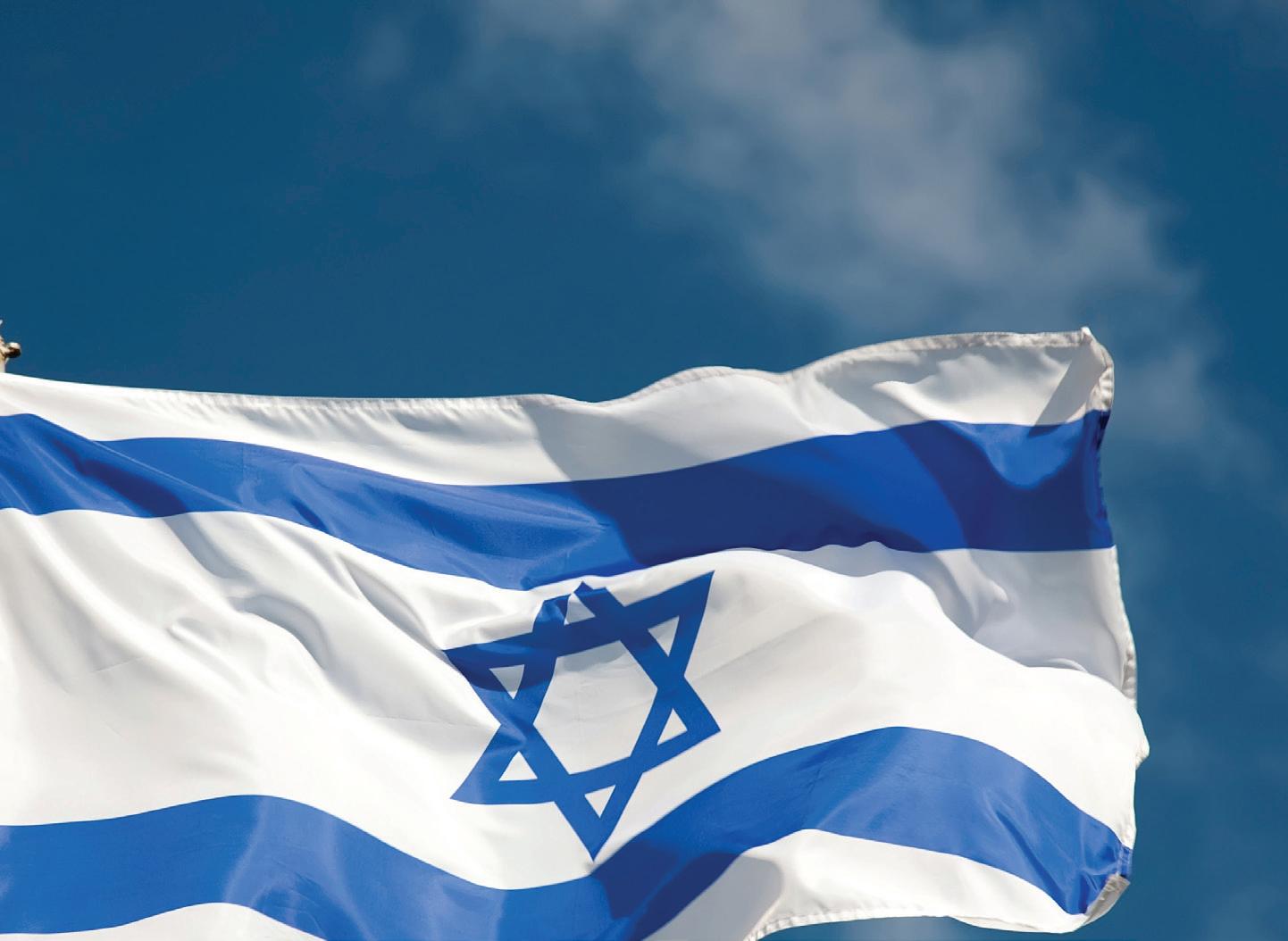
YOUR SON OR DAUGHTER HAS HAD A FANTASTIC YEAR LEARNING IN ISRAEL AND WANTS TO CONTINUE FOR A SECOND YEAR. THAT’S GREAT, BUT WHAT ABOUT COLLEGE?

Jerusalem-based Touro College in Israel works alongside Seminaries and Yeshivot to provide conveniently scheduled American college courses necessary to jumpstart their college careers. Whether your child plans to attend Touro College in the USA or transfer credits to another university, TCI provides the American courses they need and want.


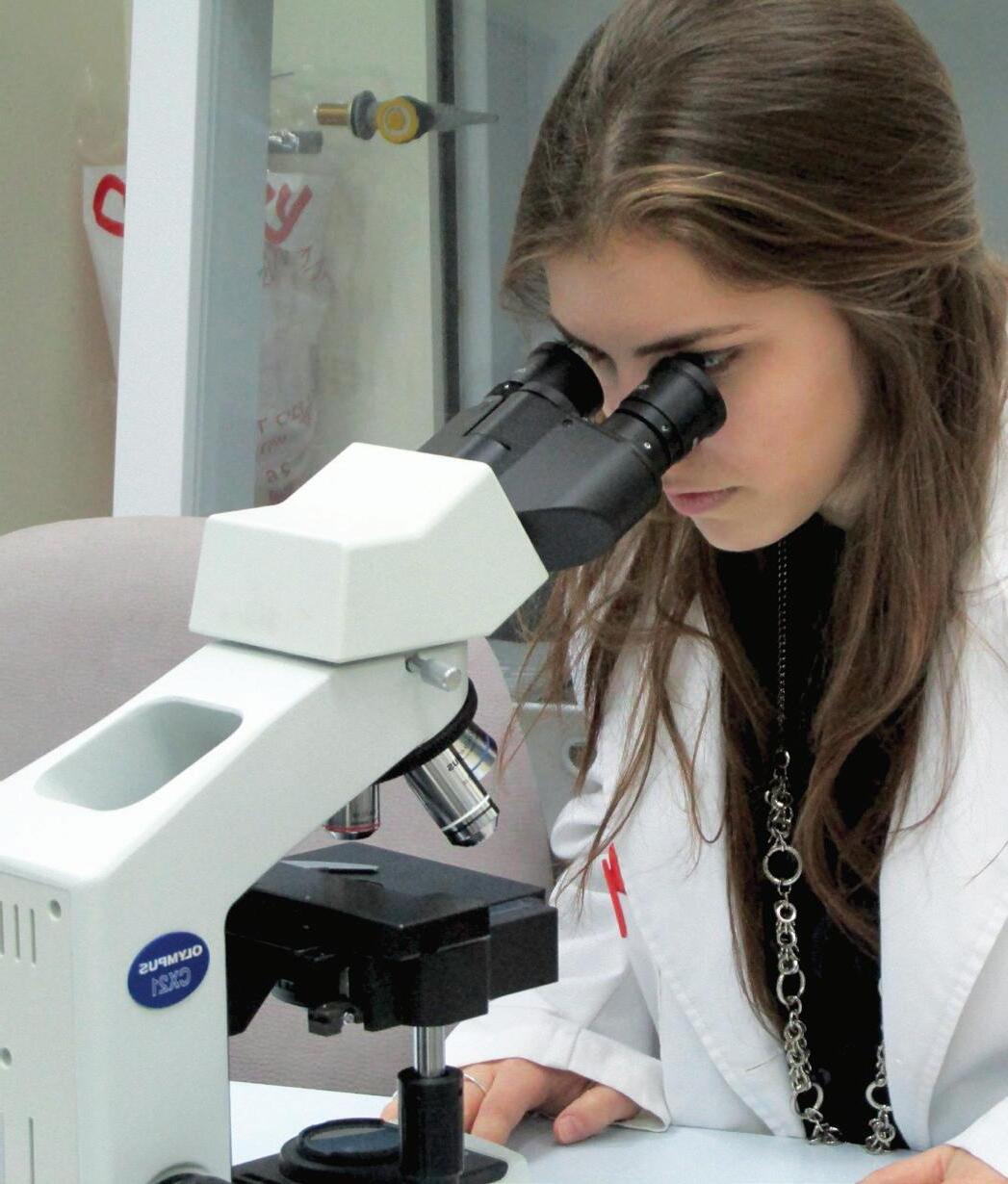



SThere is much controversy surrounding the definition of this period of time, and much ink has been spilled explaining the various debates, nuances and opinions. One of the works surrounding this topic, the Mnach Yoma, was authored by Rabbi Emmanuel Gettinger, my predecessor as rabbi of the Young Israel of the West Side in Manhattan. Rabbi Gettinger wrote this manuscript about thirty-five years ago, when he took a Sabbatical from the shul. He merited publishing it only much more recently.
I still vividly recall the first time I casually mentioned the term “shkiah” in his presence. He looked at me quizzically and said, “Shkiah! What is shkiah?” I can still hear his voice ringing in my ear. It was a trick question and an opening to discuss his favorite topic. This exchange happened numerous times over our years together.
I met the revered (and famed) Rabbi Gettinger toward the shkiah of his life. He had already reached the stage of “gevuros” (eighty years), as he liked to refer to it. He had completed Shas at the tender age of seventeen—one can only imagine how much I missed in only meeting him when he was in his early eighties. In truth, I walked away from our first meeting thinking he was going on fifty. He was razor-sharp, spry and incredibly perceptive. I wished him well, but honestly was discouraged, as I never thought I would have the chance at Young Israel to lead my own shul.
Rabbi Joseph B. Soloveitchik, zt”l, commented that “bein hashmashot,” the twilight period between sunset and nightfall, is a combination period comprised of aspects of both day and night. Conceptually, he argued, it was defined as a new entity, distinct from both periods, not really day or night. It embodies a new, unfamiliar reality that raises various intricacies in Jewish law.
Sadly, at the Young Israel of the West Side, the last few years have been “bein hashmashot.” Rabbi Gettinger has been very much still with us, but in reality, not with us at all. It wasn’t the daytime, when he led Young Israel for sixty years, but thankfully not the absolute darkness of nighttime either, as he slowly recovered in Chicago from a serious stroke. It amazes me how the essence of a person can be so imbedded within the walls of an institution. He is nowhere, and at the same time, everywhere. To this day, when certain people refer to the “rabbi,” I need to double-check and clarify if they mean him or me.
My initial years at Young Israel as his associate rabbi were another “bein hashmashot” of sorts. We overlapped and shared rabbinical duties. At first, Rabbi Gettinger spoke on Yom Kippur, gave the big Shabbat Shuvah and Shabbat HaGadol derashot, was makri on Rosh Hashanah and performed mechirat chametz for the kehillah. He also remained the posek for the shul, and I often had to explain his unique halachic views to a young kehillah that didn’t always understand his approach. It was a tricky period for me. I was in my mid-thirties and felt mature
enough to handle my own kehillah, and yet I was still second-in-command to someone who was very much in command.
Rabbi Gettinger, a prime and early disciple of Rabbi Yitzchak Hutner, zt”l, of Yeshiva Rabbi Chaim Berlin, very much demanded kavod haTorah. He was strict in its applications and demanded it of everybody, from great scholars to the simplest balabus. He wasn’t interested in hearing about new ways of doing things or what the younger generation wanted or expected of the shul. He knew what was right and he didn’t feel the need to explain himself. He also demanded that I, as a (young) rav, demand kavod haTorah as well. When I would call his home and introduce myself as “Dovid Cohen” to either him or his indomitable, illustrious Rebbetzin Rochel Gettinger—who also mastered Shas, by the way—they would immediately respond with “hello Rabbi Cohen.”
It took only my second week at work to receive my first (of many!) firm rebukes from him. We used to learn b’chavruta in my initial year, and the sessions were fascinating. The stylistic clash between my yeshivah training and his more scholarly approach was something to behold. The sessions went on for hours, until frankly, the demands on my time precluded continuing. Early on in my tenure, Rabbi Gettinger used a verse we were learning together to scold me and remind me about which topics are better left unaddressed in a public forum. I was a little scared of his ire, and it didn’t help that the young congregants enjoyed seeing me figuratively squirm next to a small figure of towering stature and see if I was up to the challenge.
The first three years were difficult. At one point, I even tried to leave. I began every public address with “b’rishut harav,” and although respectful and appropriate, it made it difficult to escape Rabbi Gettinger’s lofty shadow.
Eventually, however, something shifted in a positive way. I don’t know exactly when it happened, but I began to really gain Rabbi Gettinger’s trust. He slowly began to relinquish his hold on shul matters, and there was a marked shift in his attitude toward me.
As time went on, I really enjoyed spending time with Rabbi Gettinger—schmoozing, hearing about how things used to be at Young Israel. He would always ask about my family and my parents. He loved my kids, and my kids adored him. He would show my Meir his telescope and would listen to my Anaelle repeat the entire Purim story. When I would ask Anaelle who is her favorite rabbi, she’d always respond “Rabbi Gettinger.” Thankfully, her Abba was always a close second.
I began to change as well. Rather than view Rabbi Gettinger as an obstacle to my success, I began to appreciate the privilege I had to learn from a giant of a man. I had a very unique perspective indeed. I had the zechut to be so close to a man who had touched the greatness of Rabbi Yosef Eliyahu Henkin, zt”l, Rabbi Hutner, zt”l, and Rabbi Gettinger’s own father-in-law, Rabbi Naftali Riff, zt”l. Rabbi Gettinger was from a different generation, and yet was so much a part of ours. I had a very unique view and role that nobody else was privy
to nor could totally understand.
Rabbi Gettinger wasn’t a schmoozer. In my mind—and maybe to others—he was a rosh yeshivah trapped as a pulpit rabbi. He always enjoyed telling me the story of how Rabbi Moshe Feinstein, zt”l, the posek hador, was called “Rosh Yeshivah” and how Rabbi Joseph B. Soloveitchik, who was a classic rosh yeshivah, was called “The Rav.” Rosh yeshivah and shul rav are different roles and require different skill sets—and sometimes the role or title fails to adequately describe the individual. Being a shul rav wasn’t always the grandest fit for Rabbi Gettinger, who sometimes had to deal with people way beneath his lofty level in both halachic observance and in Torah scholarship. My recent recollections of him are of warm embraces and even (once!) a kiss on the cheek, but I know he wasn’t always this tender, at least not in the shul. He was warm and welcoming if you pursued him, but he wasn’t today’s glad-handing rabbi at the kiddush.
Rabbi Gettinger really was “bein hashmashot” incarnate. He fit comfortably into two worlds—Yeshivish and Modern Orthodox—and yet he didn’t really fit into either. He attended Columbia University and had advanced degrees in mathematics and engineering, and did kiruv way before most modern-day college campus outreach organizations were around. His devotion to and reverence for his rebbetzin were exemplary. In fact, the earliest and sternest piece of advice he gave me was to invest money to ensure my rebbetzin had adequate household help in her new role.
Rabbi Gettinger was computer savvy and used technology very effectively for a man of his age, yet he was also the quintessential “ish hatefillah ” He could be quiet and still, and he could be engaged and vociferous. To watch him daven so slowly and carefully, reciting each and every word, was something to behold. He also loved to recite Sefer Tehillim. Rabbi Gettinger was an amalgamation of different time periods in history and different currents of Orthodoxy.
It fascinates me how different institutions end Shabbat at different times on the Upper West Side of Manhattan. People are always in a hurry to get somewhere and often choose the “early times” for Maariv. As Rabbi Gettinger’s magnum opus was elucidating the opinion of Rabbeinu Tam, he was never in a rush to end Shabbat. This devotion to Rabbeinu Tam’s view, or at least his novel interpretation of it, beautifully describes how we at Young Israel have felt recently: a yearning to hold on to Rabbi Gettinger for just a little bit longer, and to hold on to the sanctity, reflected in the Shabbat that he so embodied.
Our spiritual guide, the mentor of so many for so long, represents to us kedushah, being apart, but also being together with us, providing illumination and light. We miss Rabbi Gettinger’s indomitable presence and prayed that he wouldn’t take leave of us. Sadly, this Purim he did take leave of us. The sun has set and he has transitioned to the world that is all light and no darkness, a world that is totally Shabbat. May his memory be a blessing to us and all of Klal Yisrael. g
Israel By Toby Klein Greenwald



Neve Dekalim
Peʼat
Sadeh
Slav
Bdolach Gan Or Gdid
Bnei Atzmona
Rafah
AYam Merom Atzmona
t the edge of the Mediterranean Sea, the nearly 10,000 residents of Gush Katif had succeeded in building a paradise on Earth.1 The farmers of the Gush— responsible for 15 percent of Israel’s agricultural exports—literally made the sand dunes bloom. Most of the residents of the twenty-one communities in Gush Katif and the northern Gaza Strip (several more were waiting to receive official recognition) were farmers, some of whom did innovative work growing bug-free vegetables and organic vegetables and strawberries. Glorious flowers and spices from the greenhouses of Gush Katif filled markets and shops in Israel and abroad. One of the largest geranium exporters in Israel lived in Gush Katif. Other residents of the area worked in Jewish and general education, security, social work, ecology, academia, tourism and the arts, among other professions.
Morag





broke out and brought an end to the peaceful relations, though Gazan Arabs continued to work on Jewish farms.
In 2000, acts of terror that had started in the nineties escalated, and the Jewish residents suffered immeasurably from bombings of school buses, rockets, mortars and terrorist shootings. Despite the incessant terror, the communities of Gush Katif stayed strong, reassured by the knowledge that they were a strategic necessity, helping to keep Eretz Yisrael safe and secure.
In December 2003, Prime Minister Ariel Sharon, who had been voted into office on a platform that maintained that “the status of Netzarim is like the status of Tel Aviv,” declared there would be a “disengagement.” In August 2005, more than 1,800 families were forcibly removed from their homes and the IDF razed and bulldozed the Jewish communities of Gush Katif. Before the expulsion, the IDF Rabbinate uprooted forty-eight graves from the cemetery in Gush Katif. Among the buried were victims of terror and soldiers who fell in
the line of duty. The bodies were reinterred in cemeteries throughout Israel.
Post-disengagement, the Gazan Arabs looted and burned anything left behind. Synagogues were destroyed or turned into training grounds for terrorists.2 Agricultural facilities, which had been left to the Arabs for development (through a deal made with some foreign partners), were reduced to rubble by the hoards of looters who plundered the spoils.
Prior to the disengagement, hundreds of thousands participated in nonviolent demonstrations. Katifers wore t-shirts that proclaimed “love will be victorious,” and they believed it. At one point, they created a human chain to demonstrate that Am Yisrael is standing with them; the human chain of close to 200,000 people stretched fifty-six miles from Gaza to the Kotel.
of God have there not been more casualties. Israel had to go to war in Gaza twice since the disengagement, in 2008 and in 2014.
This is not a Pollyanna story with happy endings for all. What followed after the disengagement was bitter disillusionment with Israel’s government, financial hardship and in some cases, financial ruin. The government, contrary to its slick campaigns, did not have “a solution for every [Katif] resident” and placed onerous bureaucracy in their paths. (Some people were asked for decades’-old phone bills—at a time when they didn’t even have phones—to prove they had lived in Gush Katif.) Families were torn apart between those who thought it wise to cooperate with the government and those who refused to pack up their belongings. (In most cases, those who cooperated fared no better.) Not surprisingly, cases of untimely deaths, divorce, poverty, post-traumatic stress disorder and depression rose among former Gush Katif residents.
Toby Klein Greenwald covered Gush Katif extensively before, during and after the disengagement and was commissioned by the Center For Near East Policy Research to write a series of reports post-disengagement that were used by journalists, ministers and Israel's state ombudsman. She is the translator of In the Land of Prayer: Personal Tefillot from Israel in Turbulent Times (Jerusalem, 2006) and contributed two chapters to The Expulsion from Gush Katif (2008). She taught creative writing to women and children in Gush Katif and is an award-winning theater director who directed a therapeutic drama project with the students of Ulpana Neve Dekalim from 2006 to 2008.

Yet, against all odds, many of the pioneers of Gush Katif, with remarkable courage and resilience, went forward with their lives. They rebuilt greenhouses, started new businesses, created Torah-learning communities, trained in new professions and shifted their hopes and dreams from the shores of the Mediterranean to the mountains of the Golan Heights and the Galil, to the rolling hills of Judea and Samaria, to the Tuscany-like middle lands of the Lachish area and to the sand dunes of the Negev. Many of their children joined the most elite units in the IDF.
Today, there are approximately twenty-three transplanted Gush Katif/Gazan communities (depending on whether one includes new neighborhoods within towns and cities). Some communities integrated into cities such as Ariel and Ashkelon. Some communities have changed their names (Kfar Darom became “Shavei Darom,” “Those who returned to Darom”); others have retained their original names (like Ganei Tal and Netzer Hazani).
The expulsion from Gush Katif echoes the fall of Gush Etzion in 1948, when the communities of Masu’ot Yitzhak, Revadim and Ein Tzurim—retaining their original names—rebuilt themselves elsewhere in Israel. Indeed, Kfar Etzion that exists today was rebuilt by the children of Gush Etzion who returned in 1967. The glaring difference is that Gush Etzion was destroyed by the Jordanian army and irregular Arab forces. Gush Katif was destroyed by the government of Israel.
A few weeks before the disengagement, I attended the last brit milah that took place in Gush Katif. The parents named the child “Amihai” (“my nation lives”). The grandfather of the baby said, “I invite you all to join us here for Amihai’s Shabbat Chatan [prewedding Shabbat celebration]!” I said to the guests at our table, “The children of Gush Etzion returned to their homes
Gaza is located within the boundaries of Shevet Yehuda. Avraham and Yitzchak lived in Gerar, located near Gaza. In the fourth century, Gaza was the primary Jewish port of Eretz Yisrael for international trade and commerce. Yonatan the Hasmonean (the brother of Yehuda HaMaccabi) conquered Gaza and settled there in 145 bce. At various times throughout the centuries, Gaza was a center of Jewish learning (a yeshivah in Gaza is mentioned in the Talmud), life and commerce. King David is featured with his harp in an elaborate mosaic in an ancient synagogue in Gaza (see the article on the Gush Katif Museum in this issue).
Rabbi Yisrael Najara, author of “Kah Ribon Olam,” served as Gaza’s chief rabbi in the middle of the seventeenth century. Rabbi Avraham Azoulay of Fez wrote his mystical work Chesed l’Avraham in Gaza. Other well-known scholars and mystics lived there in the sixteenth and seventeenth centuries.
The Jewish presence in Gaza was cut short in 1929, when Jews were forced to leave the area due to Arab riots, after which the British prohibited them from living in Gaza. Some Jews returned, however, and, in 1946, established the religious kibbutz Kfar Darom. A Jewish village by the same name existed there in the times of the Mishnah.
During Israel’s War of Independence, after a long siege, the settlers of Kfar Darom were evacuated and the kibbutz fell to the Egyptians. There was a brief attempt to reestablish the kibbutz following the Sinai Campaign in 1956, but in 1957 it was again evacuated when Israel exited the Gaza Strip.
Following the Six-Day War, in the early 1970s, the first settlements in Gaza were established by the Labor government, the first being Kfar Darom.
In subsequent years, Israel’s governments encouraged Jews to move to Gaza, viewing it as a strategic asset to the State of Israel. Ultimately, more than twenty communities were built there. The settlements in the main cluster, known as Gush Katif, were mostly populated by National Religious families, and four communities in the northern part of the Gaza Strip were populated primarily by secular farmers and fishermen. There was also the more isolated community of Netzarim, which had begun as a secular army outpost in 1972 and became a religious kibbutz in 1984 and later, a religious community settlement.
Following the Six-Day War, Israel established the Yamit bloc of settlements in the northeast Sinai Peninsula with the encouragement of Moshe Dayan; the settlements were meant to be a buffer zone between the Gaza Strip and Egypt. In 1982, Yamit was destroyed as part of the peace agreement signed with Egypt. Some of its residents left the area forever; others transplanted themselves to Gush Katif, and rebuilt new homes and new dreams.
They were assured that they would never be uprooted again.
Among a number of sources used for the historical information were: www.gushkatif.co.il, www.mkatif.org and two excellent chapters on the history of Jewish life in Gaza by Sara Bedein, published in the book The Expulsion from Gush Katif, ed. Naomi Grossman (2008).
after the Six-Day War in 1967, nineteen years after they were driven out when Gush Etzion fell to the Jordanians in 1948. These children too will return one day.”At that moment, Hanan Porat entered the hall to wish the family mazal tov. Hanan was the leader of the Gush Etzion children who returned in 1967. It felt like an omen that indeed, one day, the children of Gush Katif will return to
this cherished strip of land. g
Notes
1. This section concentrates on Gush Katif and northern Gaza. There were also four settlements in northern Shomron that were destroyed at the same time. The author wishes to thank Anita Tucker of Netzer Hazani for her assistance in preparing this article.
2. www.ynetnews.com/ articles/0,7340,L-3568336,00.html.
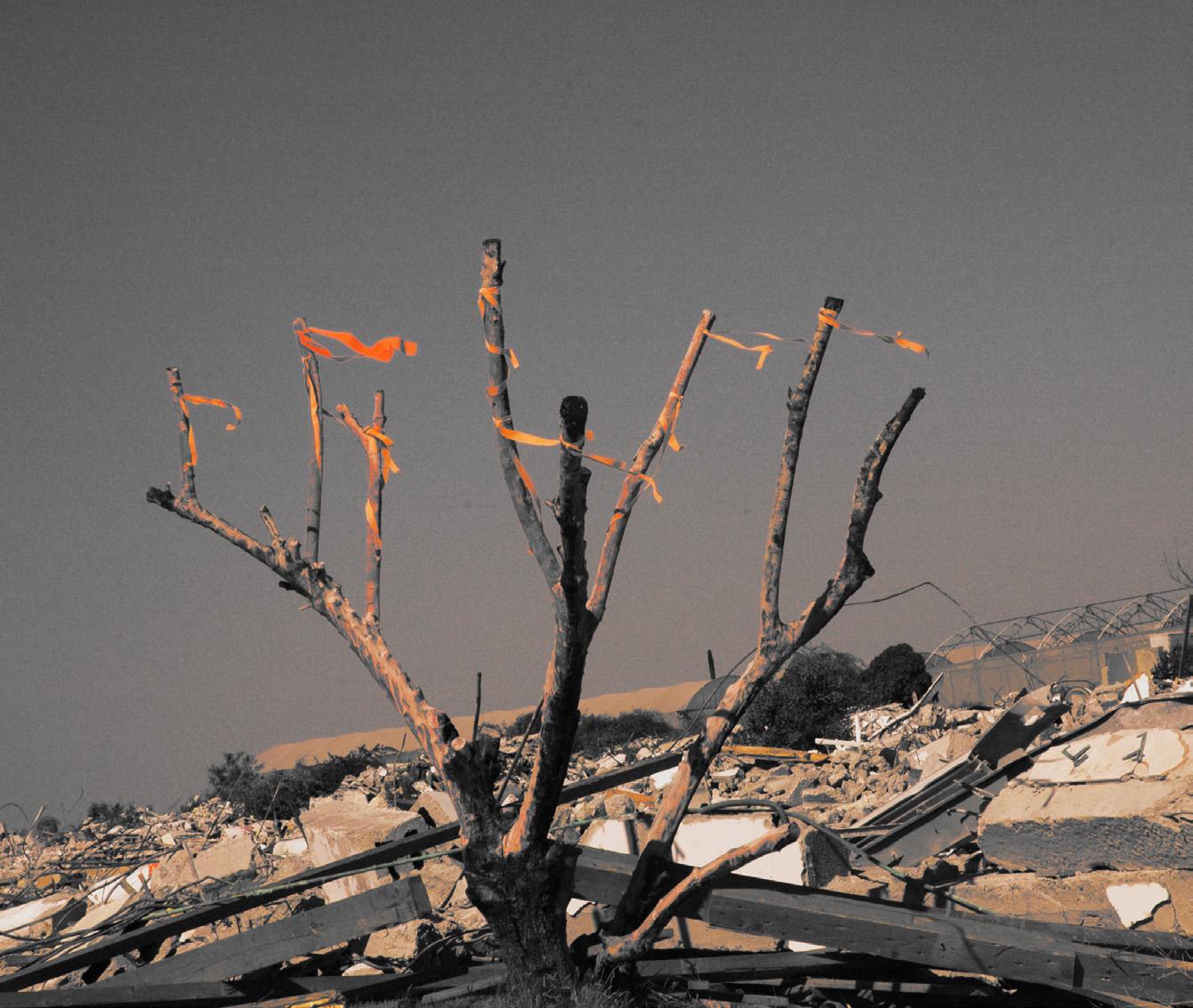
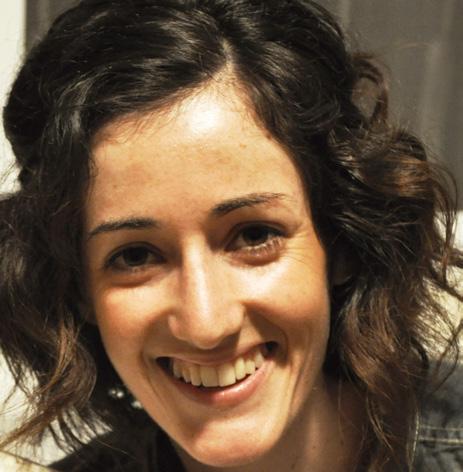
BdolachChoosing three people to relate their personal experiences of the uprooting of their families from Gush Katif was an impossible task. Each story, each person and each community is different. We decided to go with three young people, who ranged from age sixteen to twentyfive during the disengagement, to see how it affected them at the time, and how they moved on.
Livnat Farjun was twenty years old at the time of the evacuation. She had completed her National Service and was studying in a midrashah (institute of higher Jewish learning for women) in Gush Katif. She lived with her family in Moshav Bdolach.
was a small settlement with only thirty-four families. Most of the men were farmers and the women were educators. My father owned greenhouses, in which he grew chives for export. My mother was an arts and crafts teacher in the elementary school.
We were in close contact with the surrounding moshavim in the Gush. We studied in the same schools and had joint events. We lived near the sea and spent a lot of time there.
When I heard the announcement regarding the evacuation, I thought, “How could our government demand the destruction of such a beautiful region—one that we had built with tremendous effort?” I set out, together with others, to try and prevent the evacuation from happening—through demonstrations, various campaigns and a great deal of prayer.
I knew there was a strong possibility that it might happen, but I believed that maybe something would prevent it. My parents also hoped it wouldn’t happen, but logically they knew it might come to pass. Therefore, they felt, we needed to prepare ourselves for that day and pack our belongings.
There was a lot of uncertainty: What will be? And how will it be? How will we get through it? Will we really lose our home? Will we really lose our way of life?
I feel that the pain we suffered went way beyond [losing our] home. We were pioneers; we had helped build Israel. Yet [there were many in Israeli society who] were not touched at all by our pain, who thought, “Big deal, so you lost your house. So what?” There was an attempt to delegitimize our feelings of loss, and that was the most painful of all.
There was also a great deal of peer pressure within some of the Gush Katif communities and their supporters to believe “haya lo tihiyeh,” “it won’t be” and that “people who really believe in God don’t pack up and leave.” This led some to denounce those who chose to take the practical route and prepare for the evacuation.
I was always taught that one does not depend on miracles. One believes in God and knows that all He does is for the good. But I heard some people say, “Perhaps there will be a miracle,” including some rabbis. Maybe these rabbis [did so] in order to encourage people to [be more forceful about the] struggle, but it had a negative effect afterward.
I do not believe that we can shut our eyes to reality. The rabbis should have said, “Friends, it might happen, but we won’t stop believing [if it does happen].” For years afterward, this
made it difficult for me to choose a rabbi in whom I could place my trust.
The people of Gush Katif had moved there out of a sense of mission, a shelichut. It was a settlement built on love of and connection to the land. Suddenly, we were [being portrayed as] evil. Soldiers [were trained] to remove us from our homes with coldness and indifference. We were not viewed by them as heroic pioneers but as criminals. What was our crime? That we had built these yishuvim, these communities? The army prepared its soldiers [to treat us] as if we were violent people. Even those who shouted did not get violent, and their screams and refusal to leave came from a place of great pain, the shattering of a great dream they had built with their own hands.
I was born in the Gush, Among the sand and the sea The palm trees, the flowers And since that time, I am here
Here I grew up Here I matured Here I learned everything Here I plunged my feet Into the dunes
Anyone who is thinking Of speaking of surrender I want him to know— I have no other home.
Poems from the book Orange Child by Yael (Cohen) Haramati. Translation by Toby Klein Greenwald.
At the time, I felt that the government of Israel had abandoned us, as if we were no longer a part [of the Israeli nation]. And throughout the years that followed, the overwhelming bureaucratic difficulties that I heard some had to endure added to the overall feeling of invisibility, of [the sense that] “nobody really sees us.”
On the other hand, there were those who were sensitive to our anguish. There was a woman in our neighborhood whose son had been murdered by a terrorist in their greenhouse. The soldiers, who knew she lived in our neighborhood, did not enter our area, but waited until we left on our own. There was a social worker who [despite the fact that she] was in favor of the expulsion, she did everything she could to help us overcome the trauma. And there were many such individuals.
On the day of the evacuation, I cut myself off from what was happening around me; it was as if I was watching a
movie, looking at the events from the outside—at the soldiers, the people. During the weeks that followed, the shock began to dissipate and what remained was a great deal of confusion, loss and pain.
I made a decision to not allow myself to plunge into despair and fury. It took me a long time until I allowed myself to truly cry [over this trauma], and to give expression to the pain. I also know that when I became a physical psychotherapist, I was better prepared to help people cope with various crises because of the crisis that I personally endured.
Having lived in Jerusalem for five years, I recently returned to live with my family in our new home in Be’er Ganim (“Well of Gardens”), near Ashkelon. Be’er Ganim is [an acronym] composed of the first letters of some of the communities in Gush Katif: Bdolach, Elei Sinai, Rafiach Yam, Gdid, Gan Or, Netzer Hazani, Nissanit, Neve Dekalim and Morag. Many refugees from these communities are building their new homes here.
On one level or another, many residents of Be’er Ganim are still stuck in the Gush. The evacuation and the ensuing struggles still direct their lives. In fact, for many of them, the building of new homes causes all kinds of [emotional] issues to rise to the surface. Some of the refugees thought their lives would return to normal after they moved into their new homes. But they did not take care of their psychological needs after the evacuation, partly because they just needed to survive and put their lives back together. They also wanted to protect their children and were afraid that their families would fall apart. Many of them failed to mourn the evacuation properly.
When we were expelled I tried to write a few lines but my whole notebook filled with tears.
by Yael (Cohen) Haramati
A few of the young women doing their National Service in Be’er Ganim have told me that they feel that some of the families to whom they’re invited for Shabbat meals talk about the evacuation as if it happened last year. They are still traumatized.
I felt that the government of Israel had abandoned us, as if we were no longer a part [of the Israeli nation].
[In response to this,] I began a program offering teva therapy, nature therapy, to community members. Nature therapy is an innovative treatment method that takes place in nature. Groups of people meet (in Be’er Ganim we often do it around a bonfire) to speak about difficulties they are experiencing. They speak about memories of life in Gush Katif, differences between then and now, feelings toward the establishment and finding ways to cope and develop resilience. The method is based on the idea that nature has resources for healing and encountering them can promote parallel processes in humans.
The program is [geared] for members of my parents’ generation—for those individuals who had built the Gush and had spent their lives there. Many of them, including my father, have still not successfully adjusted to their new lives. My father is a driving teacher after being a farmer for so
many years, but he views it as a job, not as the fulfillment of a personal dream [which farming was to him].
On a personal level, in spite of the fact that I moved forward and acquired a profession, and I have hobbies and interests that fill my world, I am still seeking my home—a desire to belong, a yearning for the feeling of community that existed in the Gush and was lost.
I am trying hard to build my internal home, and to feel safe ground beneath my feet again. g
Listen to Anita Tucker, the well-known spokesperson on behalf of the Gush Katif evacuees, discuss the tenth anniversary of the Gaza disengagement at www.ou.org/life/community/savitsky_tucker/.
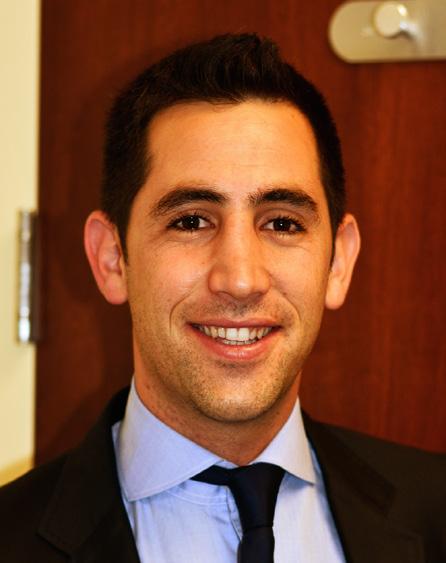
AS TOLD TO AND TRANSLATED BY TOBY KLEIN GREENWALD
Yedidya Harush’s seventeenth birthday was not a happy one. It was the day the people of the Gush Katif settlement of Atzmona were forced to leave their homes. Today Yedidya is twenty-six years old, married to Shiran, who teaches Hebrew to new immigrants, and has a two-year-old girl named Avigayil. Yedidya is the JNF (Jewish National Fund) Halutza liaison for Negev community development, and in that capacity travels and lectures widely in the US.
born and grew up in Atzmona, the third of seven children. My father was a lieutenant colonel in the military rabbinate and was the rabbi of the Eilat region. My mother taught in the local elementary school in Gush Katif.
Life was great in Atzmona, and in Gush Katif in general. We felt like it was the best place to live. It wasn’t easy at times, having to deal with rocket and terror attacks and having to go to funerals of friends and relatives [the victims of terror attacks]. But we knew we were there for a reason and we were so happy to live there. I went to school in Gush Katif. We spent a lot of time going to the beach and playing outdoors.
The disengagement was very, very difficult. It was hard to say goodbye to my memories, my childhood. I remember standing in front of my home, holding the key, watching the bulldozer knock the house down. Three hours later it was flat. Everything was gone.
On the day of the disengagement,
I hid in the greenhouses, and I stayed [even after everyone had left]. Nobody carried me out; I left myself. I didn’t want anybody to carry me out; that’s not who I am. [The rest of the community had gathered for final prayers in the synagogue and then got on buses to evacuate.]
I felt empty and lonely. When I walked around, after everyone had left, I felt like a stranger, like it wasn’t my home anymore.
Eventually someone gave me a ride and I joined my family at Nof Ayalon [a community that took in Atzmona residents after the expulsion], where we stayed for a few months. Then we moved to Kibbutz Sa’ad, where we stayed for three months, and then to Yad Binyamin.
When we exited the gates of Gush Katif, we had a choice to make: either we choose to remain angry and say, “We are no longer part of this country,” or we choose to still believe in the Land of Israel and be part of it.
[After the disengagement, some of the residents of Atzmona erected a
tent city known as “City of Faith” on the outskirts of the southern town of Netivot. Some of the young people there gathered together at a zula, a hangout.] The boys in the zula were very angry. They had a lot of hostility toward the leadership of Atzmona because they felt that they were not radical enough [in their response to the situation].
On our way out I sat backwards Gazing at the sea And the flowing sand I tried to wave goodbye I tried to wake up And see It was just a dream. by Yael (Cohen) Haramati
Following the disengagement, many boys and girls from Gush Katif were on the streets. Several of them relocated to different schools; a few got into drugs and suffered from serious psychological difficulties. Eventually many of them pulled their lives together, but not all of them did. Some of them are still living on
excellence and Torah values

At Touro’s Lander Colleges in Flatbush, Queens and Manhattan, students choose our accounting program because they want to succeed. We prepare our students to excel — and they do. Our undergraduates outscored students at five of our New York/New Jersey area competitors with the highest percentages of students passing the CPA exam for the first time*. Touro is committed to providing an education that leads to career success.
*According to the most recent report by the National Association of State Boards of Accountancy (NASBA), in three of the four categories on the exam: financial accounting and reporting, auditing, and regulation.
LANDER COLLEGE OF ARTS & SCIENCES @ Touro in Flatbush
Separate Men’s & Women’s Schools
Steven Toplan
Phone: 718.252.7800 ext. 299/320
Email: admissions.lander@touro.edu

O R S facebook.com/WeAreTouro @WeAreTouro
LANDER COLLEGE FOR MEN
Kew Gardens Hills
Rabbi Barry Nathan
Phone: 718.820.4884/4904
Email: barry.nathan@touro.edu

LANDER COLLEGE FOR WOMEN
The Anna Ruth & Mark Hasten School
Manhattan
Sarah Klugmann
Phone: 212.520.4263
Email: sarah.klugmann@touro.edu

The ducks we had in our yard
We took with us to the bus
But the driver didn't agree [To take them]
Now I heard on the radio
That someone is looking for a home for them.
I wanted to ask
That someone write down their address
So when we have a home of our own,
They can return to us.
by
Yael (Cohen) Haramati
the streets. They are living in the past. I don’t blame them.
Unfortunately, after the evacuation, I didn’t have a school to go to, because my school had been in Gush Katif. But I was very fortunate to receive a scholarship through [famous Israeli basketball star] Tal Brody to attend a yeshivah in Highland Park, New Jersey, with two other friends, for our last two years of high school. The week before my family moved to what became their temporary house for the next seven years in Yad Binyamin, I flew to the States.
I think that the scholarship helped me get through everything, but what also helped was my home, my family. My parents are very Zionistic, strong believers in God. They taught me that whatever happens is for a reason. They had built a brand new house just before the disengagement, enlarging our 700-square-foot house into a magnificent 2,700-square-foot home. Our house had gotten too small for our family. We had planned the renovation way before we knew about the disengagement. People called our home “The House of Faith” because we continued building even though we knew the disengagement could happen.
When people would ask me how my parents could continue to build despite the impending disengagement, I
I remember standing in front of my home, holding the key, watching the bulldozer knock the house down. Three hours later it was flat. Everything was gone.
would reply, “When you have a relative sick in the hospital, you don’t prepare his funeral. You do everything you can to make him healthy again.”
We continued to believe; we gave a lot of people strength. My mom says she would do the same thing all over again— build that new house again. It was a lot more than bricks and concrete. Yes, my parents did lose a lot of money and had to take out another mortgage. They were compensated for only 60 percent of what they lost. And eight years later, when they were building their new home in Yad Binyamin, land was much more expensive, so they had to take out a half-million-shekel mortgage.
I felt a little apprehensive about leaving my country and what used to be my home; I had never really left Gush Katif before. We lived in a bubble, and for us, America was a dream. But meeting the American Jewish community was an amazing experience and provided a soft landing after what I’d been through. I learned about Zionism from American Jews, seeing how they look up to our country and

how they appreciate it. They helped me rebuild my life.
When I returned to Israel, I became a paratrooper in the IDF. After serving in the army, I was about to start law school when I got a phone call from my [former] community [members] asking for my help. I didn’t think twice before saying yes; I wanted to do something more meaningful than law school, which could wait. Some of the members of my former community of Atzmona had relocated to the Halutza area. [Founded in 2005 by a small group of families evacuated from the Gush Katif communities of Atzmona and Netzarim during Israel’s disengagement from Gaza, Halutza is located in the northwest Negev on Israel’s borders with Egypt and Gaza. It is composed of three communities: Naveh (families transplanted from Atzmona); B’nei Netzarim (families transplanted from Netzarim) and Shlomit (a new community). This desert area, which had never been inhabited or farmed, is now a rapidly expanding agricultural region that is attracting new residents throughout Israel. Today there are 250 families; their goal is to reach 2,400.]
I work with the Halutza community and the JNF to help build communities and synagogues, kindergartens and medical centers. I am building Israel; giving back to my country.
After the disengagement, my father continued to work for the military rabbinate and became the second-in-command in the southern area. He retired about three years ago. My mother opened a school in Yad Binyamin.
We may have challenges in Israel, but at the end of the day, it’s our only country. There are approximately 14 million Jews around the world, and Israel is their only homeland. God forbid, if anything happens tomorrow, to Jews anywhere in the world, these Jews can get on the first plane out and come to Israel.
Today when I fly to the States to speak on behalf of Halutza and JNF,

I recharge my Zionist batteries in the Jewish communities in America. Any Jew—religious or not—involved in building the
State of Israel gives me strength. [Because of them,] I can go back and say to the people of Halutza, “We’re not alone.” g

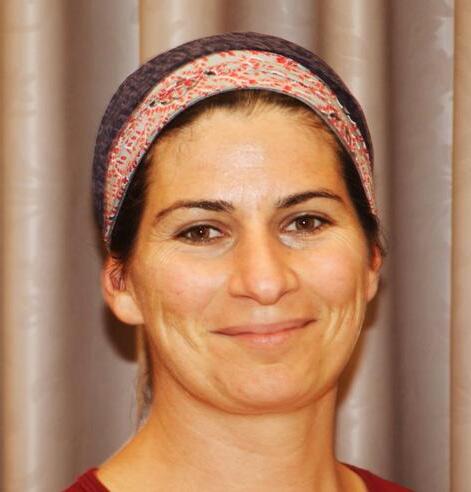
AS TOLD TO AND TRANSLATED BY TOBY KLEIN GREENWALD
Iwastwenty-five at the time of the expulsion, married with a twoyear-old son and near the end of another pregnancy.
I was a medical student at Hebrew University and my husband was studying in yeshivah. Although we lived during the week in a student apartment in Jerusalem, our home was in Ganei Tal in Gush Katif. We had gotten married in Gush Katif, on the seashore, at sunset. The brit milah of our son had been in Ganei Tal and that was where we spent every moment we weren’t in school. In the days leading up to and during the expulsion, we were in Ganei Tal, together with my family and the other members of the moshav.
The announcement about the impending destruction of Gush Katif and the abandoning of this magnificent region to Israel’s enemies
was impossible to fathom. It was simply impossible to believe that the government of Israel really intended to expel me from the only home I had ever known, a place that the State
Only late at night Do I sometimes cry Even though I have almost Everything I need Because nobody understands How hard it is to fall asleep Without the sound of the waves. by Yael (Cohen) Haramati
itself had created due to its strategic importance.
As a woman who believes in God, I know that “My thoughts are not your thoughts and your way is not My way” (Isaiah 55:8). When we heard about the expulsion, we knew we had
to carry out the struggle against the order in the public sphere, politically and, of course, through prayer. But the final decision is in the Hands of God. And we would accept the decree because of our understanding that whatever God does, He does for the best.
Like all the members of the moshav, my parents had an agricultural farm and, in addition, my mother was a lab technician who worked for Kupat Cholim. As an employee of the local municipality, she lost her job with the expulsion.
We were fortunate to be part of a family in which everyone shared in the decision to not facilitate the expulsion from our home in any way. We tried, through every legitimate legal way, to nullify the decree. When the soldiers came into our home, they found it fully furnished and filled with
[In our home in the Gush,] my room was painted orange My sister had painted hers red
My mother had painted the kitchen purple Now it is all mixed together upon the sand.
by Yael (Cohen) Haramati
overwhelming. Tragically, throughout our years of living in the Gush, we had lost friends in terror attacks, people who had died in order to enable us to continue to live here. But with the death of Rachela and Dov, the frustration was overwhelming, because we knew that they were murdered on this holy land, but in another month there might not even be Jews living here! Within the thirty-day mourning period, the day of the expulsion arrived. The idea that the terrorists who murdered our loved ones would soon receive this piece of Eretz Yisrael, drenched in the blood of Rachela and Dov, was unbearable, a feeling of total surrender to terror and evil.

life; two days earlier, my father had mowed the lawn. This attitude united the family and enabled us to get through the terrible devastation together, embracing each other.
The churban actually began for us three weeks earlier, when my aunt and her husband, Rachela and Dov Kol, may their deaths be avenged, spent a Shabbat with us.
On Motzaei Shabbat, while they were driving home to Jerusalem, terrorists shot at their car and killed them. It was the night of the Seventeenth of Tammuz, and the pain was
It was simply impossible to believe that the government of Israel really intended to expel me from the only home I had ever known, a place that the State itself had created due to its strategic importance.
Two months after the expulsion, I gave birth to my daughter and we called her “Tal” to commemorate the spirit of our home that was destroyed.
During the expulsion and afterward, I wrote poems and stories that described the situation from different perspectives. Some of them were published in newspapers, like the story “There Are No Orange Toilet Tanks” that deals with the difficulty of building a new home.
Two years after the expulsion, I wrote a book of poetry called Orange Boy that describes the period [of the disengagement] through short poems from the perspective of the children of Gush Katif. At the present time, a playwright is writing a play based on my writings that, please God, will be performed during the tenth anniversary of the expulsion. The play, A Time to Plant, deals with the rehabilitation after the expulsion and the terrible conflict most evacuees experience between the desire to settle in a new place and the dream and the desire to return home.
Today my family and I live in the rebuilt moshav Ganei Tal in the Nahal Sorek region. It is called by the same name as the original community so we will never forget where we came from. Every year on the day of the expulsion we drive to a lookout place in the direction of Gush Katif and we declare that we will return. If we will not be privileged to return, then, God willing, our children or our grandchildren will once again build their homes there. g
Home Game is a powerful film produced in the aftermath of the disengagement. The film tells the compelling story of the disengagement through the eyes of the Gush Katif youth of Netzer Hazani who were involved in the 2005 annual Gush Katif summer basketball tournament—a tournament that took place at the same time as the implementation of the disengagement plan. Home Game can be viewed at israelvideonetwork.com/must-see-home-game-the-movie-on-gush-katif/.

Courtesy of Rav Yosef Zvi Rimon
BY TOBY KLEIN GREENWALD
Rav Rimon founded JobKatif to help former residents of Gush Katif find jobs. Today JobKatif provides employment coaching and counseling, business mentoring, professional retraining courses, academic scholarships and other services.
Katif was an agricultural success story beyond anyone’s dreams.
Four hundred farmers were responsible for 95 percent of Israel’s bug-free lettuce and greens, and accounted for 70 percent of Israel’s organic vegetables and 15 percent of Israel’s agricultural exports.
But following the disengagement in 2005, hundreds of businesses were wiped out and unemployment among the evacuees was rampant.
The almost 10,000 people of Gush Katif and the Northern Shomron were suddenly left with nowhere to live and nowhere to go to work in the morning.
In the days and weeks immediately following the evacuation, Rabbi Yosef Zvi Rimon, community rav of Alon Shvut, and some of the members of his community went to visit the uprooted residents of Gush Katif. They went from hotel to hotel to see how the evacuees were faring. Looking at their shattered lives, Rav Rimon tried to pinpoint how they could be most helpful. “We asked ourselves, ‘What is most needed?’
“I saw immediately that things were not organized; there were no [provisions] for doing laundry or for dealing with other basic necessities, but the Minhelet Sela [government body created to take care of the evacuees] said the residents would only be in the hotels for twelve days. In the end, it was three to six months,” he says.
Problems abounded. Little children had nothing to do during the day; no arrangements had been made for day care programs. “They didn’t have enough toys or activities,” says Rav Rimon.
Of course, the biggest challenge proved to be finding employment. “The lack of employment was causing emotional difficulties. Eighty-five percent of the residents had been employed in Gush Katif and all of a sudden they were out of work; I saw that that was the largest problem but no one was taking care of it.”
Rav Rimon met with the officials of Minhelet Sela and of the Ministry of Industry, Trade and Labor. “They said, ‘How can we organize work if we don’t know where they’ll live?’ I replied, ‘But how many months can they be here without work?’ They asked, ‘What do you suggest?’ I responded, ‘Give them temporary jobs.’ They countered, ‘How will we find those?’”
Realizing that Sukkot was coming up, Rav Rimon called Sukkot Yerushalayim, a major sukkah manufacturer, and asked if they needed workers for the upcoming holiday. “Of course!” they said. In one day he found work for seventeen people.
“I saw how the light returned to their eyes. And then I realized there was no choice; I had to do [something about the situation] myself,” Rav Rimon says.
Rav Rimon gathered 150 volunteers from all over the country. They looked for jobs and learned how to write resumes. Then they set out to assist the evacuees from Gush Katif.
“At first we worked out of my house, until I saw it was too much,” says Rav Rimon.
Eventually, JobKatif, as it became known, moved into the offices of IDT, the giant telecommunications company run by Howard Jonas at the
time, who generously donated space to the program for four years.
Certain subgroups were harder to employ than others. “Some evacuees were over forty-five, or had no college degree,” says Rav Rimon.
He decided to help them set up their own small businesses.
“A few years ago, the government ombudsman did research and discovered something amazing. Statistically, 80 percent of new businesses fail in the first eighteen months, but 94 percent of the businesses we helped get off the ground succeeded. [This is because] we accompanied the owners throughout the process,” Rav Rimon explains. “It is not enough just to find work for people. Some of them needed to learn new [skills or professions]. In Gush Katif, many of them worked in agriculture or security; we had to determine [which fields they could retrain in and see] what was the most appropriate for them.”
Rav Rimon tells a story: A husband and wife worked in the moetza (local municipality of Gush Katif) and after the expulsion they were both unemployed for three years. Noting that the husband had a talent for cooking, JobKatif helped him start a catering company, offering both financial aid and professional advice. It also provided funds so that his wife could study in the nursing program at Shaare Zedek Medical Center.
“A number of months ago,” says Rav Rimon, “I was at an event and the food was especially delicious, so I went to see who the caterer was, to thank him. He said to me, ‘Rav

Rimon, don’t you recognize me? You were the one who helped me start this company. We didn’t have work; people even brought us food for Shabbat—that was how bad our situation was. It was so hard psychologically for me. And you helped me open this catering business and enabled my wife to go to school. I paid off all my debts and my wife is now a nurse. We work, we stand on our own two feet, we have no debts and it is in your zechut.’”
Today, JobKatif provides employment coaching and counseling, business mentoring, professional retraining courses, academic scholarships, vocational retraining courses and help with establishing or expanding existing businesses. To date, according to the organization’s web site, JobKatif has helped 2,600 people find employment; 580 have completed professional retraining courses (80 percent of whom have found employment in their new professions); 202 have received academic scholarships and more than 200 businesses were successfully launched. “These are not just numbers,” says Rav Rimon. “You realize you are saving families.”
In addition to serving as chairman of JobKatif, Rav Rimon is the founder and chairman of the Halacha Education Center, which develops innovative educational curricula for Jewish studies in Israel. Rav Rimon is also a faculty member of Yeshivat Har Etzion and Midreshet Migdal Oz. He also writes extensively on Talmudic and halachic issues.
In 2008, Rav Rimon was awarded the President’s Prize for Volunteerism by President Shimon Peres. Rav Rimon was
also awarded the Moskowitz Prize for Zionism in 2014, in recognition of his work on behalf of the Jews of Gush Katif.
Rav Rimon says that while there are 380 evacuees from Gush Katif who still need jobs, he doesn’t see JobKatif lasting too much longer in its current form. “One year from today, we’ll close JobKatif. Our prediction is that in one year, the level of unemployment among those expelled from Gush Katif will be at 6 percent, like it is all over Israel, and at that point we will become ‘JobIsrael’ and will work [to assist all Israelis].”
Looking to the future, Rav Rimon has begun a pilot program geared to help Ethiopian women become nurses. Noting that the key barrier to their acceptance into Israel’s nursing schools is the culturally biased psychometric exam, JobKatif began assisting Ethiopian women gain entry into nursing programs by offering one-on-one tutoring and enrichment courses. “We’re creating a real revolution,” says Rav Rimon. “We’ll try to help as many people as we can and create real change in the State of Israel.”
More than a year ago, Rav Rimon gave a talk at a religious all-girls’ school on Shabbat. At the end of the talk, a few girls came over to thank him.
“There was one girl in the tenth grade who waited until everyone left, and then she came up to me and said, ‘Rav Rimon, I want to say a huge thank you. You saved my family.’ ‘How did I save them?’ I asked. She said, ‘I am from Gush Katif, and after the expulsion, my father and mother lost their jobs and they were at home for a number of years, doing nothing. They began to fight with each other, and then one day they said they were going to get divorced. I was so sad. And then suddenly JobKatif came and helped my parents find work; they didn’t just find them jobs, they also encouraged them. A few weeks later, things began to get better. My father and mother began to be happy again and everything went back to normal. It’s been a number of years since then; they never spoke about divorce again, and I wonder, was it a nightmare or reality? Thank you for saving my family.’
“I heard that and I said to myself, ‘It was all worth it just for this family.’” g

By Peter Abelow


The Gush Katif Museum in Jerusalem is relatively small—just five rooms—but it tells a huge story. The events depicted in its exhibits take one back ten years to the trauma of the summer of 2005, when 10,000 Jews were expelled from their homes and their communities. Yet, despite the political overtones and ramifications of the eradication of Jewish communities in Gush Katif and the Shomron, I was amazed at how the museum, which is privately owned and run, manages to portray the story in a touching, personal and nonpoliticized way.
The museum is as informative as it is moving. I was fortunate to be guided by a young woman named Reut, who has worked at the Gush Katif Museum for the past five years. Despite the fact that she and her family were evicted from Neve Dekalim, she escorts visitors around the museum with warmth, offering her reflections on the events of 2005 without a trace of the bitterness that one might expect.
The museum tells a very human story. Passing from

room to room, visitors are brought into the lives and frustrations, and the hopes and dreams, of individuals who were asked to pay a heavy price for the strategic policy of Israel in 2005.
Upon entering the museum, one sees a large panel illustrating the 4,000-year history of Jews in the area that we know today as Gush Katif. The panel, which spans the long wall of the entrance gallery from end to end, depicts our Biblical connection to Gaza as well as the modern bond we have with the region.
As has happened so frequently in the Land of Israel, Arab culture has preserved ancient names. Reut informed me that the Arab village of Je’rara (Gerar) is near where the Gush Katif town of Netzer Hazani stood. Gerar is Gush Katif!
Drawing from Parashat Toldot, when Yitzchak travels to Abimelech, King of Philistines in Gerar, due to a famine, the panel clearly shows our Biblical link to the Gaza area. “And Hashem appeared to him [Yitzchak] and said, ‘Do not descend to Egypt; dwell in the land that I
Peter Abelow is a licensed tour guide and the associate director of Keshet: The Center for Educational Tourism in Israel. Keshet specializes in creating and running inspiring family and group tours that make Israel come alive “Jewishly.” He can be reached at 011.972.2.671.3518 or at peter@keshetisrael.co.il.

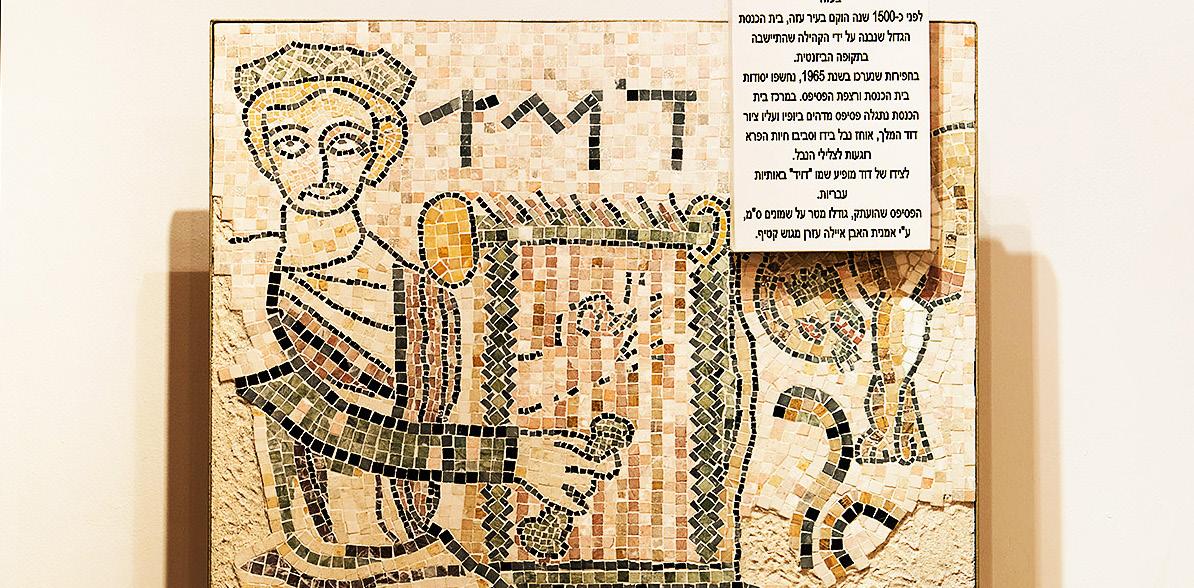
will indicate to you [Gaza]. Sojourn in this land and I will be with you and will bless you; for unto you and unto thy seed will I give all these lands” (26: 2-3) . . . . So Yitzchak settled in Gerar . . . and he sowed in that land, and found in the same year a hundred-fold; and Hashem blessed him. And the man waxed great, and grew more and more until he became very great” (12-13).
To me, the two last verses represent a clear vision of the future; a prediction of the material success that Yitzchak’s descendants would experience in Gush Katif over three-and-a-half millennia later.
The panel also includes a reproduction of a portion of a mosaic floor in the Gaza area from a fourth- or fifthcentury synagogue depicting King David playing his harp. To many, this is evidence of extensive Jewish life in the region during the Byzantine (Mishnaic/Talmudic) period. Much of the panel depicts images of more recent Jewish history in Gush Katif, with photographs of the flourishing towns and thriving industries that characterized Gush Katif from the 1970s until the summer of 2005.
Moving to the next room, one cannot help but be struck by a large and impressive menorah that once
A large panel artistically depicts the 4,000-year history of Jews in Gush Katif.
A reproduction of a portion of a mosaic floor in the Gaza area from a fourth- or fifth-century synagogue depicting King David playing his harp.
Passing from room to room, visitors are brought into the lives and frustrations, and the hopes and dreams, of individuals who were asked to pay a heavy price for the strategic policy of Israel in 2005.
graced the synagogue of Netzarim. The next set of exhibits depict the tragedy of the destruction of beautiful synagogues, schools and batei midrash that once reverberated with the sounds of prayer and Torah study, all of which were turned over to the Arabs whole and intact, only to be recklessly demolished.
But the loss was not only spiritual. One exhibit tells the story of the extraordinary agricultural infrastructure that once was responsible for exports totalling $2 million annually as well as the formidable obstacles and challenges confronted by the expellees to recreate
their businesses in other locations. The display reminds us that there were 3,500 dunams (865 acres) of greenhouses that were abandoned and eventually destroyed by the Arabs. Fifteen percent of Israel’s agricultural produce was grown in Gush Katif. What is most amazing is that this entire agricultural enterprise had been created in Gush Katif on what only thirty years earlier had been sand dunes. Unfortunately, since 2005, only a small portion of the destroyed agricultural businesses has been reestablished in other parts of the country.
In the “orange room”—orange was the color of the struggle against the expulsion—orange-colored bumper stickers, posters, flyers and photos are on display, a testament to the intense struggle that surrounded the expulsion and characterized the summer of 2005. The “black room,” a room painted entirely in black, focuses on the “gerush,” the expulsion, telling the story through maps, photos and videos.
Some of the videos include dramatic and heartbreaking scenes of the forced evacuation, including struggles between yeshivah students and soldiers. There are plenty of scenes of weeping evacuees and even of weeping soldiers. And yet,

there is a message of hope along with the sense of despair. The designers of the museum wanted visitors to feel what it is like to be expelled from one’s home, to experience the ruptures in Israeli society that the events of that summer created. But they also wanted visitors to leave with a sense of a people struggling together to repair the breaks as an “am echad,” a people united in hope for the future. I asked Reut what she thought is the overriding message of the museum. She said, “We must strive to repair that which has been torn apart in our society, and find a way for our people to remain a strong people, able to cope with failures of the past as we face the challenges that still lie ahead.”
The museum, located at Rechov Shevet Zedek, no. 5, is a short walk from both the Tachana Merkazit (Jerusalem’s Central Bus Station) and the Machane Yehuda Shuk. There is a large municipal parking lot on Agrippas Street, only a few yards from the entrance to the museum. There are plans in the works to expand the museum.
The story of Gush Katif is one that must be remembered as we face the challenges of 2015. The museum effectively jars our memory as it touches our core as Jews. g

Team Yachad participants commit to raise sponsorship monies to benefit Yachad programming. Lifetime Miami Marathon and Half Marathon - January 24, 2016 Jerusalem Marathon, Half Marathon and 10K - March 18, 2016




Magen David Adom, Israel’s emergency medical response agency, isn’t government funded, so every rescue is a group effort between Israeli paramedics on the ground, who often volunteer their time, and generous American donors who provide the funding. Whether it’s a family sponsoring an ambulance or a bar or bat mitzvah student sponsoring an emergency supply bag, every donation helps save lives.
Please give today at www.afmda.org/donate or start your own fundraising campaign at saving-lives.afmda.org.
352 Seventh Avenue, Suite 400
New York, NY 10001
Toll Free 866.632.2763 • info@afmda.org www.afmda.org

In December, twenty-seven Jews from North America toured the land of Israel for ten days, singing the entire way and joined by Lipa Schmeltzer, one of Jewish music’s biggest stars.
“Music on Tour” was one of the few Taglit-Birthright Israel trips solely devoted to the music of the Promised Land. Organized by Israel Free Spirit (www. israelfreespirit.com), the Orthodox Union’s Birthright division, the trip brought together participants who share a love of music.
“We realized that there was a need and interest in the musically oriented part of the Jewish population,” explains Scott Shulman, program director of Israel Free Spirit. “The land of Israel has so much to offer in this regard.”
The first step in running the trip was finding staff members who are involved in the music scene. Israel Free Spirit recruited Yitzy Glicksman, a knowledgeable freelance musician from Teaneck, New Jersey, and Liat Lemberger, marketing director at Universal Records, where she represents successful artists like Owl City. Participants came from all over North America and Canada, each of whom brought his or her own musical appreciation. Many brought their instruments: guitars, harmonicas and even a saxophone. Once the trip began, the connection between the participants was immediate.
“The music bridged a gap because everyone was singing and playing music,” says Lemberger, who taught the unaffiliated Birthright participants Jewish songs throughout the trip, including “Hinei Mah Tov” as they hiked down Masada.
Along with all the experiences expected of a Birthright trip, the trip explored the musical side of Israel with participants meeting with local musicians and popular
artists and visiting the Rimon School of Jazz and Contemporary Music in Ramat Hasharon.
“It transcended our differences and brought us closer together,” says Glicksman.
On Friday night, as the group prayed at the Kotel, they were joined by a special guest, Jewish music superstar Lipa Schmeltzer, who not only sang with them on Friday night but stayed with them the entire Shabbat, and even led a moving Havdalah service. Former Chair of OU Birthright Henry Orlinksy generously sponsored the superstar’s visit.
“It was everything I ever wanted,” says Eitan Prouser, twenty-six, a graduate of Molloy College. “I needed some inspiration and I needed to see something I hadn’t seen before. The trip gave me that.” g


In November, the Orthodox Union launched the OU Women’s Affinity Group, a forum for women within the OU to create an ongoing conversation with the goal of fostering an inclusive, enjoyable workplace. Each month, several dozen female employees gather together for a speaker, networking event or brainstorming session.
“We discuss areas that people are concerned about, like opening up leadership positions to women, mentor training and work-life balance,” explains Penny Pazornick, North American director of Israel Free Spirit, the Birthright Division of the OU, who, together with Orah Alon, human resources manager at the OU, are the co-chairs of the OU Women’s Affinity Group. OU

Executive Vice President Allen I. Fagin, who developed the idea for the group, explains: “The OU Women’s Affinity Group is designed to encourage the women members of our professional staff to share information and ideas across departmental lines; to network with one another and with others outside the organization; to discuss issues of common concern and to offer advice and guidance on enhancing the quality of the OU work environment,” he says. “We look forward to the Women’s Affinity Group playing a dynamic role in our ongoing efforts to recruit, retain and promote women within the ranks of the OU professional staff.” g
This past February, Ira Forman, US Special Envoy to Monitor and Combat Anti-Semitism, spoke to Orthodox Union leaders about the rise of global anti-Semitism.
The event was organized by the OU Advocacy Center, the nonpartisan public policy arm of the OU. Forman, the former director of the National Jewish Democratic Council, delivered his talk at the OU headquarters in downtown Manhattan.
“It was an honor to have Ira Forman join us at the OU to brief our leadership on the steps being taken by the Administration to combat the growing scourge of anti-Semitism in Europe,” says OU Executive Vice President Allen I. Fagin. “We are grateful that the United States government has seen fit to create the position of Special Envoy to Monitor and Combat AntiSemitism as a tangible step in recognizing and combating antiSemitism wherever it rears its ugly head. It is incumbent upon each of us to remain eternally vigilant and to do everything within our power to protect the safety and religious freedom of our brethren everywhere.”

When the popular Mount Sinai Jewish Center in the Washington Heights section of New York wanted to reach out to affiliated and non-affiliated Jews in the area, it turned to the Orthodox Union.
“We decided to get involved because there are thousands of Jewish young professionals in the Heights,” says Rabbi Dave Felsenthal, director of the OU’s NextGen Division. “But the majority aren’t connecting anywhere. At Mount Sinai’s request, we decided to partner with them and help the unaffiliated and uninvolved Jewish young professionals connect to a dynamic Jewish community.”
NextGen reached out to Hart Levine, the director of Heart to Heart, a grassroots organization dedicated to promoting religious Jewish life on college campuses that is funded by the OU. Levine, who, together with his wife, Yael, lives in the Heights, had already been running assorted programs for Jewish professionals in the area.
“My neighbors and I all belong to the main shul in the neighborhood, but a lot of people weren’t a part of it or tapped into it,” says Levine. Eventually Levine and his neighbors began organizing events and Shabbat meals together. “It began as a handful of people and then grew to twenty to forty people at each event. We were looking to see what the next step was going to be and then the OU approached us.”
With the OU’s support, Levine
launched Open Up Washington Heights, an informal group composed mainly of volunteers who work to build a sense of community among the varied Jewish residents of the Heights. The program director is currently Lily Lozovsky.
“There was really just a void,” explains Levine. “People graduate college where they have the OU-sponsored Heshe and Harriet Seif Jewish Learning Initiative on Campus (JLIC), but until they settle down and marry, there’s this gap. Who’s reaching out to them and making sure they’re doing okay? It’s a hard stage, and people get lost through the cracks.”
Levine and neighborhood volunteers began organizing more Shabbat meals, shiurim and Jewish events. They contacted an older synagogue in the area, Congregation Beth Hamedrosh Hagadol of Washington Heights. The shul had recently fallen on hard times and the year before didn’t manage to have a minyan for Rosh Hashanah. Open Up Washington Heights set up tables on the street where volunteers handed out flyers and apples and honey in honor of the Jewish New Year. More than 150 people visited the shul during the holiday, a third of whom were unaffiliated. Rosh Hashanah was just the beginning for the group, and they’ve broadened their programming to run monthly Shabbatons, events and even Pesach Sedarim. g


Top: Open Up Washington Heights partners with shuls such as Congregation Beth Hamedrosh Hagadol of Washington Heights, a shul which had recently fallen on hard times, to run events and Shabbatons.
It’s a weekday morning and Rabbi Chaim Loike, rabbinic coordinator for the Orthodox Union and chief bird expert, is packing up his van. Inside are boxes of live birds—ducks, quails, parrots and parakeets—that were delivered to him via mail the day before. After a quick stop at the pet store where Rabbi Loike picks up fish tanks for the birds and supplies, he brings them to the school he is scheduled to visit.
“We go to anyone who requests us,” explains Rabbi Loike, who typically visits a different school each month and has a long waiting list of schools that have requested him. “The kids are usually really interested. They ask, ‘Is that the quail they ate in the midbar?’ They’re interested in the birds that were given as korbanot—the doves and the pigeons; they’re shocked [when they see] what they learn about in school is coming to life!”
Not only is the OU the largest and most trusted kosher certification agency in the world, but the organization provides a dazzling array of educational courses, classes and lectures on the topic of kosher to the Jewish public, thanks to a grant from the Harry H. Beren Foundation of New Jersey and the encouragement and guidance of Rabbi Menachem Genack, CEO of OU Kosher and rabbinic administrator, and Rabbi Moshe Elefant, COO of OU Kosher and executive rabbinic coordinator.
“We believe that the more people know about kashrut, the more we strengthen kashrut worldwide,” explains Rabbi Yosef Grossman, OU’s senior educational rabbinic coordinator. “The OU is a service organization. Besides

providing kosher food, part of the mission of OU Kosher is to provide kosher education.”

ASK OU (Advanced Seminars in Kashrut) began in 1996 as a threeweek mashgiach training program for semichah and kollel students as well as a one-week learning program for community members and members of kosher vaads. As interest in the programs increased, the division, with the support of former OU President Dr. Simcha Katz, began looking to expand. Eventually, the OU launched the Harry H. Beren ASK OU Outreach program for kollels and communities.
“Instead of people only coming to us for internships and training, we go to them,” says Rabbi Grossman.
In 2006, the OU also began bringing kashrut courses to schools under the OU Kosher Coming program. OU rabbinic field coordinators began offering the OU’s kosher expertise to students around the world, including students at elementary schools, high schools and colleges. Each presentation was tailored to the specific interests of the group. OU Kosher Coming was recently folded into the activities of the ASK OU program.
“The OU has delivered presentations to schools and institutions across the entire spectrum of Orthodoxy, from Chassidic to Modern Orthodox,” says Rabbi Eli Eleff, consumer relations administrator for the OU and rabbinic coordinator, who now runs the ASK OU Outreach programs for high schools and elementary schools.
ASK OU also began offering classes via Skype to institutions as far away as kollels in Australia. It also produces DVDs, magazines and manuals about the kashrut process, including the popular Daf HaKashrus newsletter.
“The OU believes in transparency,” says Rabbi Grossman. “We believe that an educated consumer is our best customer. We try to strengthen kashrut through accurate knowledge.”
To find out more information about ASK OU and how to bring it to your school, yeshivah, kollel or community, e-mail koshereducation@ou.org. g


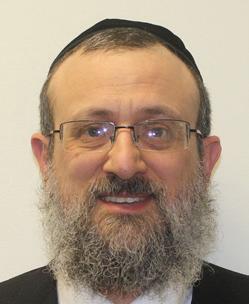








Introduc I ng the
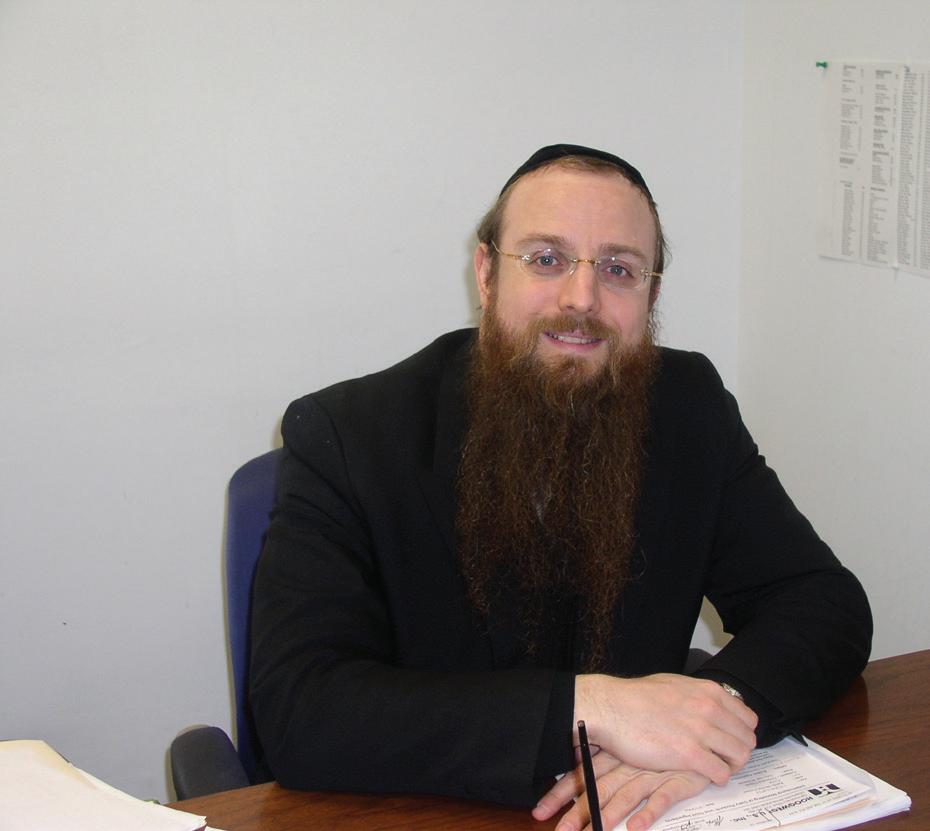
Whether in Melbourne Australia*, Norfolk, VA, or anywhere in between, your kollel, yeshiva, day school, high school or community can SKYPE with one of the OU’s world-class experts directly to your institution to share his expertise and enjoy a real time Q &A.
Po P ular To P ics include:
· The Mesorah of Kosher Birds, Eggs and Animals
· Current Kosher Fish Issues
· The Production of Kosher Wine and Liquor
· The New Shmata Bedikah for Checking Fruits and Vegetables
· Meet the OU’s Meat Team
…Or request a topic of specific interest to your community, group or organization.
For more information, contact Rabbi Yosef Grossman at Grossman@ou.org, 212.613.8212 or 914.391.9470.
Sponsored by the Harry H. Beren Foundation of New Jersey
*Kollel Beth HaTalmud in Melbourne has hosted ten Harry H. Beren ASK OU Global SKYPE Shiurim to date!
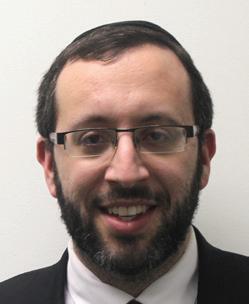





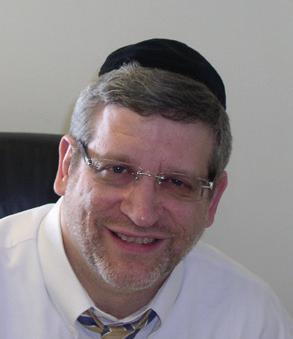
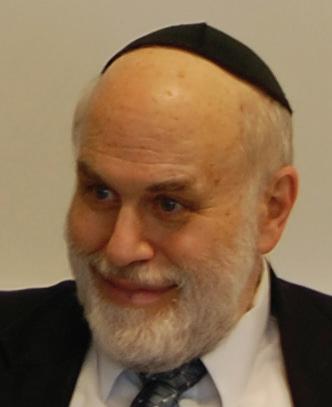




OU Executive Vice President Allen I. Fagin with other American Jewish leaders at a meeting with President Barack Obama. Mr. Fagin is seated on the right-hand side, second from the end. Courtesy of the White House/Pete Souza
Promoting the security and welfare of Israel is a priority for OU Advocacy. Recently, OU Executive Vice President Allen I. Fagin joined other American Jewish leaders—as the sole representative of the Orthodox segment of the community— in a meeting with President Barack Obama to discuss our concerns over the proposed deal between Iran and the US and other Western powers. Working on the domestic front as well, the OU advocates for key domestic policy issues. Mr. Fagin, together with OU Advocacy Executive Director Nathan Diament and OU Advocacy Congressional Affairs Director Miriam Harmer, met with Senator Amy Klobuchar (D-MN) to discuss the new legislation OU Advocacy is spearheading to create a federal grants program to assist synagogues, schools and other nonprofits with making their buildings energy efficient. g


Congratulations to Rabbi Yosi Eisen, rabbi and codirector of the OU’s Heshe and Harriet Seif Jewish Learning Initiative on Campus program at the University of Massachusetts, on being selected as a recipient of the 2015 Grinspoon Awards for Excellence in Jewish Education. The award is sponsored by the Harold Grinspoon Foundation in Western Massachusetts. g
By Roslyn Singer
On a Tuesday afternoon in mid-April, the Orthodox Union, together with parents and leaders of Jewish day schools and yeshivahs throughout New York City, appeared before the City Council to make the case that every student in New York City has the right to learn in a safe and secure environment.
“School violence has become all too commonplace in our society,” said Allen I. Fagin, executive vice president of the OU, in his testimony. He noted that, according to the Justice Department’s Bureau of Justice Statistics, more than 1 million nonfatal criminal acts took place on school grounds in 2012 alone, including 749,200 violent incidents.
“Most of us do not choose our child’s school based on its security infrastructure, nor should we need to—but given the attacks in France, and other highly publicized incidents at home, security is at the top of everyone’s mind,” Mr. Fagin says.
In New York City, the New York Police Department’s 5,000 school safety agents are stationed at the entrance to every public school in the city, working to ensure that every public school remains a violence-free zone where every student can thrive. Each agent is trained, is in direct communication with the local precinct and serves as a visible frontline defense for the school.
Unfortunately, no such provision exists for New York City’s nonpublic schools. And many nonpublic schools are simply unable to afford the costs associated with hiring private security guards, leaving them vulnerable and open to potential attacks.
For this reason, the OU is working together with its allies in the City Council to support Intro 65. Introduced by City Council Member David Greenfield, the bill would provide
the same uniformed NYPD school safety agents to every school throughout the city—public or private.
“When it comes to the safety of our children, it doesn’t matter what their religious beliefs are or whether they go to public or nonpublic schools,” says Greenfield.
If Intro 65 is passed, no school would be forced to compromise on security due to budget concerns, and school safety would no longer be contingent on higher tuition costs.
“Having the appropriate security infrastructure, such as good lighting, strong windows and a surveillance system, is important. But the most effective—and most visible—way for a school to ensure the safety of its students is by having a uniformed security officer whose sole responsibility is the safety and security of the students, the faculty and the staff,” explains Mr. Fagin.
Daniella Gotlib, a parent at Luria Academy in Brooklyn, noted in her testimony that all of Luria’s income goes directly to teachers’ salaries and classroom materials. While Luria does not have the funds to support a security guard, everyone “would feel much safer if the school had an NYPD school safety agent.”
And having this security in place would allow children to focus on their studies rather than on their environment.
“Children need to feel that they are in a safe and secure environment in order to thrive at school,” says Jake Adler, New York policy director for the OU.
Intro 65 has wide bipartisan support but must still be approved to become law. Together with our coalition of Jewish day schools and yeshivahs, OU Advocacy is working to advance Intro 65 through the legislative process at City Hall and will continue to work to ensure the safety of our students. g

Assembly Members
Todd Kaminsky (center left) and David Weprin (center right) were among the many state legislators who met with the joint OU Advocacy-Teach NYS/Yachad delegation to Albany in March. OU Advocacy-Teach NYS brought representatives of communities from throughout New York State to Albany to advocate for issues and legislation that would benefit New York’s Jewish day schools and yeshivahs. g
By Rabbi Jonathan Sacks OU Press and Maggid Books
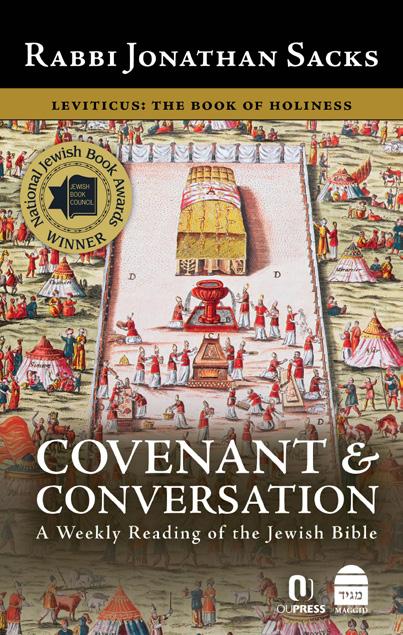
Rabbi Jonathan Sacks has become renowned as one of the foremost expositors of Judaism, and of religion as a whole, in society today. Covenant & Conversation: Leviticus reminds us why this is the case. This brief review will focus on Rabbi Sacks’ introductory essay, which explains the relevance of Vayikra to modern man and stands as a masterpiece on its own.
Rabbi Sacks opens by noting that Vayikra is, “of all the Mosaic books, the one most out of step with contemporary culture. Many find it difficult to relate to its concerns. It opens with an account of sacrifices, something we have not experienced for close to two millennia. Its preoccupation with ritual purity and defilement seems to come from another age.” But the key to understanding Vayikra, Rabbi Sacks argues, is to understand holiness.
What is holiness? “Holiness is a break in the self-sufficiency of the material world, where infinity enters space and eternity enters time.” If the existence of the universe is only possible through an act of Divine withdrawal, tzimtzum, holiness is only possible through human withdrawal, allowing the infinite God into our finite world. “The holy, in short, is where human beings renounce their independence and self-sufficiency, the very things that are the mark of their humanity, and for a moment acknowledge their utter dependence on He who spoke and brought the universe into being.” In other words, holiness means sacrificing ourselves—and this in turn is “the truth at the heart of Leviticus,” the common denominator between the Temple rituals and the command to love your neighbor. Vayikra teaches that “there is no love without the willingness to sacrifice.”
Modern readers find Vayikra’s focus on the rituals of sacrifice alien, but what they forget is that “the priestly ritual is the choreography of love.” The ritual aspects of Judaism, Rabbi Sacks explains, represent Judaism which “is not just poetry, but also prose, not just the fire of romantic love but the daily kindnesses of a successful marriage, not just an exalted faith in the transcendent God but the way it takes faith and translates it into everyday life.” This insight into the nature of Judaism remains true in a world without the Temple and its sacrifices. “Judaism continues to be a religion of rituals,”
Rabbi Sacks notes, “and it is this that sustains its continuity through time, etching its days with the charisma of grace, more like a marriage than a romance but no less moving for the quietness of its beauty.” This is the standing-on-one-foot version of Rabbi Sacks’ message. For the full version, which encompasses much more than could be included here, we must paraphrase Hillel’s words to the convert: “Go get a copy of Covenant & Conversation: Leviticus, and study!”
By Rabbi Natan Slifkin OU Press, The Biblical Museum of Natural History and Maggid Books

Rabbi Natan Slifkin demonstrates why he has become acclaimed as the “Zoo Rabbi” with his newest book, The Torah Encyclopedia of the Animal Kingdom—Volume 1: Chayot/Wild Animals. This book contains an encyclopedic array of information relating to everything from the fearsome to the fluffy: lions and leopards and bears, but also hyraxes and hares.
Rabbi Slifkin gathers together all scriptural references to the animals he discusses, as well as sources from the Talmud, Midrash and later rabbinic literature about the identity, laws, symbolism and significance of the animals in the Torah. In addition, Rabbi Slifkin combines his Torah erudition with wide-ranging knowledge of zoology and natural history, drawing on the latest academic findings to understand Torah sources. Despite his painstaking research, this work is written in an accessible style aimed at all Jewish animal lovers. The beautiful color photographs that accompany the text evoke the words of King David: “You make darkness, and it is night; wherein all the beasts of the forest do creep forth. The young lions roar after their prey, and seek their meat from God. The sun arises, they gather themselves together, and lay them down in their dens . . . O Lord, how manifold are Your works! In wisdom You have made them all; the earth is full of Your riches.” For anyone seeking to explore those riches from within the Jewish tradition, The Torah Encyclopedia of the Animal Kingdom is the definitive resource. g
Q:I toss and turn for hours every night, just staring at the clock. Is there anything I can change in my diet to help me get some rest?
A: You’re not alone; insomnia affects almost half (48 percent) of Americans, according to the National Sleep Foundation. This inability to get a good night’s sleep, either because you can’t fall asleep or stay asleep or both, can be very frustrating and anxietyprovoking. In fact, feeling worried about not sleeping could be one reason you’re having a hard time drifting off.
“Insomnia has a strong anxiety component,” explains Clinical Psychologist Dr. Miriam Adler, executive director
of Park Avenue Psychotherapy & Neurofeedback Associates in Clifton, New Jersey. “For many people, part of the insomnia loop is that they get anxious about whether they are going to have insomnia. It starts with a night or two of difficulty falling asleep, and the next morning perhaps they can’t focus or they miss something important. From that point onward, they become anxious in the evening, worrying, ‘Am I going to get up tomorrow?’ They are so busy thinking about whether they will get a good night’s sleep that their brains can’t relax enough to make that happen.”
“There is more shame when it’s a frum male who has difficulty waking up in the mornings,” asserts Dr. Adler. “Religious observance becomes part of a person’s self-concept. Now, instead of
‘I have a hard time getting out of bed,’ it’s ‘I don’t make minyan’—it becomes a bigger issue.”
Furthermore, because the Jewish calendar varies, it’s challenging to stick to a consistent sleeping schedule, generally a key component in treating insomnia.
“Obviously many people are able to have variances in their schedule without an insomnia problem,” Dr. Adler adds. “But for those who have more sensitive sleep-wake cycles or who have a history of sleep anxiety, a change in an evening routine is a monkey wrench. Many people need a certain amount of time to unwind before they can transition into a sleepier state. In the summer, if you have a late Friday night dinner, you may have a harder time falling asleep on those evenings and possibly a harder time waking up for shul the next day as well. This can also be a problem for boys who go to mishmar [late night learning sessions], as is typical in many yeshivah programs.”
“One of the first steps in treating insomnia is ruling out other causes,” says Kelly Brown, M.D., assistant professor of neurology at the Sleep Center at Vanderbilt University in Nashville, Tennessee, who is a sleep specialist. “Most of the time, when we treat the underlying cause, the sleep difficulty resolves itself.”
For example, undiagnosed sleep apnea (sleep interrupted by breathing difficulties) can lead to non-restful sleep. Another fairly common condition, periodic limb movement disorder, leads people to “kick themselves awake all night,” describes Dr. Brown. “It goes along with restless leg syndrome—when an individual is trying to fall asleep but feels like his legs need to move.”
Shira Isenberg is a registered dietitian and writer with a private nutrition practice in Memphis, Tennessee. She has a master’s degree in public health nutrition from Hunter College in New York.
Undiagnosed anxiety or depression may also interfere with healthy sleeping. Dr. Brown has patients keep a sleep diary, tracking sleep habits like time spent in bed and amount of sleep to determine what is going on.
Once alternate causes have been addressed, sleep specialists use cognitive behavioral therapy (CBT) to help patients resolve sleep issues. “CBT works as well as sleeping pills in helping people fall asleep,” Dr. Brown asserts. “It also offers long-standing benefits, whereas pills only work when the patient is taking them.” Sleeping pills have been associated with negative side effects, like excessive drowsiness and increased morbidity and mortality, adds Dr. Brown.
Creating a consistent healthy sleep routine, what’s known as sleep hygiene, is one component of CBT for insomnia. (See sidebar for specific sleep hygiene strategies.) “Just like for a young child we schedule dinner at X time, then bath, then bed,” describes Dr. Adler, “sticking to a schedule [for adults] sets up both body and mind to transition into sleep.”
Another strategy is sleep restriction—limiting the time spent awake in bed—which helps associate the bed with sleep. If you’re lying in bed unable to fall asleep, Dr. Brown recommends getting out of bed and doing a quiet activity like reading until you feel drowsy again.
Because of the anxiety component, it’s helpful to learn to shut off worrisome thoughts that are keeping you awake. Dr. Adler suggests focusing on relaxing and being comfortable, rather than thinking about falling asleep.
Relaxing does not come naturally to everyone, but training with a therapist can help. “People with insomnia often benefit from learning calming activities like deep breathing and guided imagery, which help transition the brain into a less active, more tranquil state,” Dr. Adler says.
“In more extreme cases, I recommend neurofeedback, a system which helps people monitor their brainwaves and train their brains to shift more easily into the deeply relaxing delta brainwaves needed for satisfying sleep quality. Some people naturally have a deficit of delta brain waves,” Dr. Adler adds.
A key nutrient of concern in sleeping difficulties is iron. “Iron deficiency is associated with restless leg syndrome; it can go away once iron is replaced,” explains Dr. Brown.
A recent study from the Journal of Sleep Research used information from national surveys to pinpoint several other food and lifestyle habits related to sleep challenges. For instance, dieting and eating few foods and calories make people more likely to be sleepy during the day and have a hard time falling asleep at night. This might be due to simple hunger; it’s hard to nod off when your growling stomach is telling you to head to the kitchen.
Researchers also identified a handful of nutrients that may have a relationship to sleep. A lower intake of selenium (found in meat, dairy, grains and nuts) is linked to having a hard time falling asleep and an increased intake of calcium (found in dairy products, fortified foods and certain vegetables, nuts and beans) is associated with enabling one to fall asleep more easily.
However, iron aside, it’s not so helpful to focus on individual nutrients since foods contain a combination of nutrients. An overall healthy diet rich in fruits and vegetables and other wholesome foods should help you get a good night’s sleep.
There’s a connection between large quantities of caffeine and insomnia: caffeine is thought to disrupt normal sleep cycles. Many people need to avoid consuming caffeine from the afternoon on. Alcohol may similarly
SKIP daytime naps, even if you’re tired; they’ll interfere with your sleeping at night.
DON’T consume caffeine or alcohol in the few hours before bed.
DON’T eat right before bed.
GET EXPOSURE to sunshine during the daytime. It’s important for developing a healthy sleepwake cycle.
Use your bed for sleeping— NOT reading or working on the computer
SET UP a calming bedtime routine and try your best to stick to it every night.
GET regular exercise, but don’t do vigorous physical activity right before bed.
Recommendations from the National Sleep Foundation
break up sleep during the night so it’s less restful, according to research. Alcohol also suppresses REM (rapid eye movement) sleep, the stage in which you dream.
The same types of strategies can be used for a child struggling with insomnia (sleep troubles tend to run in families): a consistent bedtime routine, a period of winding down before bed and a strict no electronics rule in the bedroom. Children can be taught to release anxious thoughts, use guided imagery and focus on feeling comfortable in bed.
Regardless of age, if sleep difficulties interfere with daily activities, consider seeing a sleep specialist who will take a thorough history of your sleep habits to help determine the cause and best course of treatment. g
Melatonin, produced by the pineal gland in the brain, is normally found in our bodies. It regulates circadian rhythms and helps you both fall asleep and stay asleep. As people get older, levels of melatonin drop off, which may partly explain why some older individuals have a harder time falling asleep. Despite the fact that melatonin is a hormone, in the United States, melatonin is considered a dietary supplement by the Food and Drug Administration Though it is generally considered safe, it’s not subject to the same types of regulation as a drug, and can be bought without a prescription in any dosage.
Taking too much melatonin at a time can cause side effects, such as feeling hungover. Supplemental melatonin may make you more tired; be wary if you’ll be driving or operating machinery after taking it. It also can lower blood pressure at night. As with any supplement, consult your healthcare provider before taking melatonin.
Melatonin is not specifically recommended for children because of a lack of study on its safety and efficacy in this age group. Some small short-term studies have focused on certain subgroups, like children with attention deficit hyperactivity disorder (ADHD) or autism, and have found melatonin to be beneficial with little risk of side effects. Talk with your pediatrician before giving melatonin or any supplement to your child.


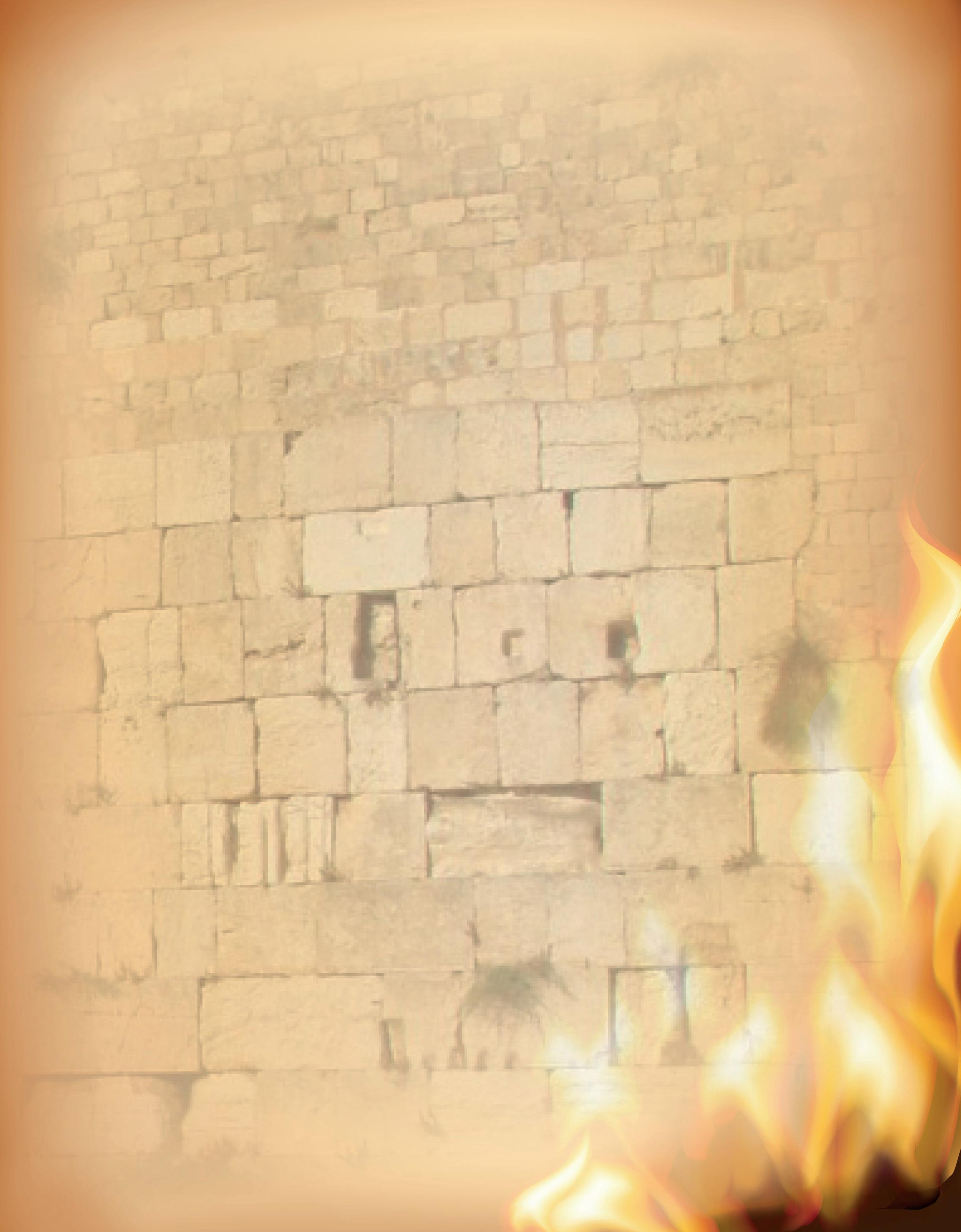



Mesorat HaRav Kinot
The Mesorat HaRav Kinot, containing the magisterial commentary of Rabbi Joseph B. Soloveitchik, will transform your Tisha B’Av experience.
In this inspiring companion for the three weeks, Dr. Erica Brown demonstrates how this somber period can be an opportunity for introspection and renewal.
Rabbi Lau’s moving story stands as a testament to the power of the human spirit to triumph over the darkest forces of destruction.
The authoritative work, by Rabbi Avraham Steinberg, on the prayer for the welfare of the State of Israel, “the first flowering of our redemption.”


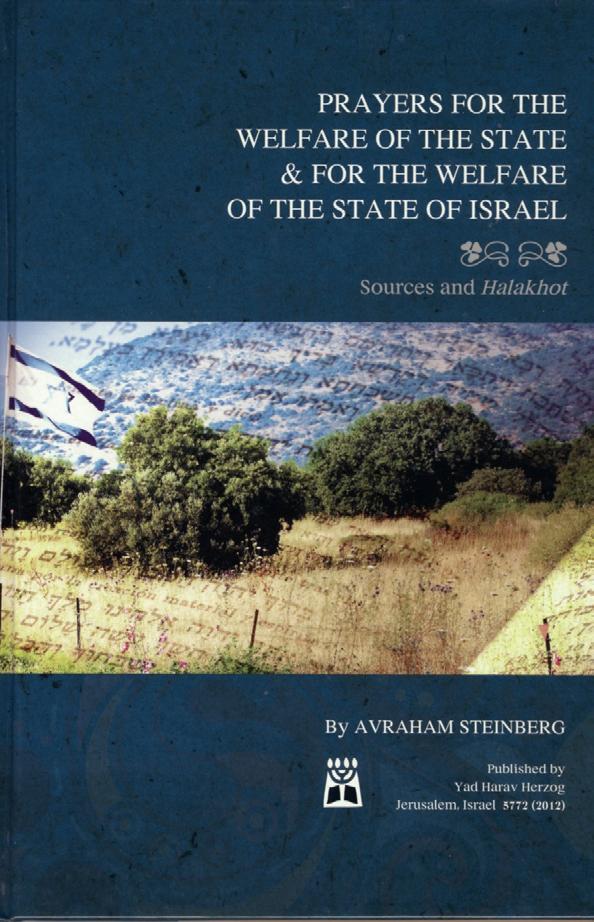

By Norene Gilletz
Preparing meatless meals during the Nine Days means no brisket, chicken or meatballs, except on Shabbat. However, you don’t need meat or poultry for a really great meal. Here are some scrumptious meatless dishes that are nourishing and satisfying, not to mention just plain delicious! Most of these recipes are plant-based to help hydrate your body before the fast of Tishah B’Av.
Yields 8 to 10 servings
Cookbook author Eileen Goltz is an expert in creating all sorts of pareve dishes, including this scrumptious, satisfying soup. You can make it pareve by using vegetable broth and cream or a non-dairy substitute. Soup is a wonderful way to stay hydrated in the days leading up to a fast.
2 to 3 leeks, washed and chopped (between 2 and 3 cups)
2 carrots, diced
1/4 cup olive oil
10 cups vegetable broth
2 potatoes, diced small
1 1/2 teaspoon salt
Norene Gilletz is the leading author of kosher cookbooks in Canada. She is the author of ten cookbooks and divides her time between work as a food writer, culinary consultant, spokesperson, cooking instructor, lecturer and editor. Norene lives in Toronto, Canada. For more information, visit her web site at www.gourmania.com.
Pepper to taste
1/4 teaspoon ground cloves
Dash of hot sauce
1 pound cooked butternut squash (you can also use pumpkin)
1/2 cup whipping cream or non-dairy substitute
2 cups fresh or frozen corn
In a large soup pot, sauté the leeks and carrots in the olive oil on medium heat. Cook for about 10 minutes.
Add the broth and bring the mixture to a boil. Add the potatoes, salt, pepper, cloves and hot sauce. Reduce heat and simmer for 30 minutes. In the bowl of a food processor, purée the squash for about 15 seconds. Add 1 cup of the hot broth and process until blended.
Pour the squash mixture into the soup and mix to combine. Whisk in the cream. When combined, add the corn to the chowder and mix to combine. Cook 4 to 5 more minutes until the corn is hot. Adjust seasonings to taste. Serve immediately.
Chef’s Secret
Corn is often sold by the half dozen. Use two ears of corn for this
recipe (each ear of corn yields 1 cup corn kernels) and use the remaining ears of corn for the Grilled Corn, Red Pepper & Snap Pea Salad (below).

Adapted from Norene’s Healthy Kitchen (2007)
Yields 4 to 6 servings

Grilling on a cedar plank imparts a deliciously smoky flavor to the salmon and keeps it juicy. Marinating salmon in a lemon-garlic-dill mixture before planking enhances the flavor even more.
1 (8 x 12-inch, or larger) untreated cedar plank (about 1-inch thick)
1 salmon fillet, with skin (about 2 pounds/1 kilogram)
2 tablespoons lemon or lime juice (preferably fresh)
1 tablespoon extra-virgin olive oil
2 cloves garlic (about 2 teaspoons minced)
2 tablespoons minced fresh dill or basil
Salt and freshly ground black pepper
1 sliced lemon or lime, for garnish
Soak the cedar plank in cold water for 1 to 2 hours before grilling; use a couple of unopened cans or other heavy objects on top of the plank to keep it submerged. While the cedar plank soaks, season salmon with lemon juice, olive oil, garlic, dill, salt and pepper.
When fully soaked, remove the plank from the water and shake well to remove any excess liquid. Heat the plank on the grill’s grate over indirect medium heat until hot, about 6 to 8 minutes.
Carefully transfer the salmon to the preheated plank (it will be very hot!), placing the salmon skin-side down. Grill for 12 to 15 minutes, until the salmon is cooked through. Rotating isn’t necessary. Keeping the grill lid closed will keep the salmon grilling at an even heat.
Spray the lemon slices lightly with cooking spray (or brush lightly with oil) and grill for about 2 minutes on each side. When the salmon is done, carefully remove the hot plank from the grill and place on a heatproof surface. Slide a wide spatula between the skin and flesh of the salmon, then transfer to a serving platter. Garnish with grilled lemon slices and serve hot or cold.
Note: Keeps for up to 2 to 3 days in the refrigerator; reheats well. Leftover salmon freezes well for up to 2 months.
No-Plank Grilled Salmon: Preheat your gas or charcoal grill. Season salmon fillet as desired, oiling it lightly to prevent sticking. Place the fillet, flesh-side down, on the well-oiled grill. At the beginning, the fish will cling to the grate until it has cooked about 7 to 8 minutes. Turn the fish over carefully using a wide spatula and cook the second side 2 to 3 minutes longer or until the fish flakes. This is known as the 70/30 timing rule, which results in a beautiful presentation with great grill marks. Is it Done Yet? Fish is done if it’s opaque yet still moist in the center. It should just flake when gently pressed with a fork. On an instant-read thermometer, the interior temperature should reach 145°F. If overcooked, fish will become dry.
A Grate Tip: If you cooked the fish with the skin on, just slide a flexible metal spatula between the flesh and skin, leaving the skin behind on the cooking grate or pan.
Yields 6 to 8 servings
Easy-peasy! Daniella Silver, my coauthor for The Silver Platter: Simple to Spectacular (2015), introduced me to this spectacular presentation for sugar snap peas. They add a simple, yet elegant look to this gorgeous, protein-packed summer salad.

4 ears corn on the cob, peeled
2 red bell peppers, halved and seeded
Oil for brushing
8-ounce package sugar snap peas (1 1/2 cups)
1 can (19 ounces/540 milliters) red kidney beans, rinsed, drained and patted dry
1/4 cup extra-virgin olive oil
2 tablespoons rice vinegar
1 tablespoon maple syrup or honey
Salt and pepper to taste
1/4 cup minced fresh basil
Preheat the barbecue. Brush the corn and red peppers with oil. Grill on all sides, 10-15 minutes. Let cool.
Cut the corn kernels off the cobs with a sharp knife. Cut bell peppers into long, narrow strips. Cut the snap peas in half lengthwise along the straight edge of the seam so the peas are exposed. Combine the corn, peppers, kidney beans and snap peas in a large salad bowl. Add the oil, vinegar, maple syrup, salt, pepper and basil. Toss together. Chill before serving.
Note: Leftovers keep up to 2 days in the refrigerator.
Variations
Israeli-Style Corn Salad: Instead of kidney beans, add halved cherry or grape tomatoes. If desired, add 1/2-cup thinly sliced
use dill instead of basil. Top the salad with 1 cup crumbled feta cheese for an extra protein punch.
Adapted from The Silver Platter: Simple to Spectacular (2015) Yields 4 to 6 servings
This cheesy-good dish was considered a staple in Daniella Silver’s home when she was growing up. Since her little ones love it so much, she has maintained that tradition. The cauliflower is tender-crisp and slightly crunchy, thanks to panko crumbs and melted cheese.
1 large cauliflower, trimmed, cut into florets
Kosher salt
Freshly ground black pepper
1 cup panko crumbs (gluten-free or regular)
2 cups shredded cheddar or mozzarella cheese (8 ounces/250 grams) 1/2 cup grated Parmesan cheese
Preheat oven to 375°F. Coat a 10-inch round ceramic or glass quiche dish with nonstick cooking spray. Place cauliflower into a vegetable steamer. Steam for 12-15 minutes, or until tender-crisp. Alternatively, place cauliflower in a large saucepan with enough water to cover. Bring to a boil, reduce heat and simmer,

Daniella’s Cauliflower Au Gratin
Photo: EyeCandyTO
for 25-30 minutes, until golden-brown and bubbling.
Chef’s Secrets
• For a pretty presentation, use a combination of cauliflower and broccoli florets.
• A whole cauliflower takes 10-12 minutes, covered, to microwave on high power.
• You can substitute a 20-ounce bag of frozen cauliflower florets for the whole cauliflower. No need to defrost before using.


Yields 6 servings
Cookbook author and food writer Eileen Goltz kindly shared this scrumptious salad from her recipe files. It’s a terrific light main course that is perfect with fresh fruit and hot cornbread or rolls. Quinoa is a great source of protein and is gluten-free.
2 tablespoons olive oil
1 1/2 pounds sweet potatoes or butternut squash, peeled and cut into small pieces
Salt and pepper to taste
1 1/2 cups quinoa, cooked according to package directions
1/4 cup additional olive oil
1/4 cup rice wine vinegar
2 large apples cut into bite-sized pieces (peel if desired)
1/2 cup chopped fresh parsley
1/2 red onion, thinly sliced 8 ounces salad greens
Preheat oven to 400°F.
On a rimmed baking sheet, toss the sweet potatoes or butternut squash with 2 tablespoons olive oil and season with salt and pepper. Roast for about 25 minutes, stirring once until softened but not mushy. Let cool.
Meanwhile, cook the quinoa according to package directions. Let cool. In a large bowl, combine the remaining olive oil with the vinegar; season with salt and pepper. Add the cooked quinoa, sweet potatoes, apples, parsley, onion and salad greens. Mix to combine and serve.
Yields 4 servings
Delicious over ice cream or frozen sorbet—or even on its own!
3 tablespoons maple syrup
3 cups sliced fresh peaches, nectarines and/or pears
Drizzle maple syrup over fruit. Wrap in heavy-duty foil, sealing well to make a package. Heat for 20 minutes on the dying embers of your BBQ.
All of your summer Kosher needs are available at the Colonie Price Chopper Market Center!
Expanded Kosher Grocer y, Frozen and Dair y Fine Foods From Israel Section Full Ser vice Kosher Meat Dept Fresh Kosher Fish Kosher Sushi (ever y Thursday & Friday) Kosher Baker y Dept Kosher Deli Dept



Bemidbar
Edited by Rav Ezra Bick and Rav Yaakov Beasley
Yeshivat Har Etzion/Maggid Books
Gush Etzion/Jerusalem, 2014
491 pages
Reviewed by Francis Nataf

Yeshivat Har Etzion has earned a well-deserved reputation for breaking new ground in Torah commentary. Its new Torah MiEtzion series, recently completed with the publication of a volume on Bamidbar, firmly establishes this reputation but also lays bare a not-insignificant shortcoming. This selection of essays—from the “Parasha Series” that appeared on the popular Israel Koschitzky Virtual Beit Midrash web site, a “yeshivah” that spreads Torah over the Internet— is an additional accomplishment for Yeshivat Har Etzion and an impressive dissemination of Tanach study to larger segments of the Jewish population. But a question must also be asked, and that is: how have these studies changed their readers?
In the most recent volume, examples of fascinating readings abound. The various contributors often draw upon subtle literary techniques to examine plots and characters in Tanach, finding new interpretations hidden in familiar narratives. Among my favorites are Rabbi Mosheh Lichtenstein’s two essays on the breakdown of Moshe’s leadership in the Book of Bamidbar. In these essays, he highlights the inability of Moshe to grapple with the realities and mentality of the second “desert generation” and illustrates how this ultimately prevents Moshe from crossing the Jordan with them. This theme is taken up by several other writers in the volume and is ultimately anchored in the commentary of Netziv. Also compelling are Rabbi Nathaniel Helfgot’s contrasting of the sin of Ba’al Pe’or with the incident of the golden calf and Rabbi Elchanan Samet’s comparison of the language used in Bilam’s curse with that used to describe Pinchas’ zealotry. Nor should one overlook Rabbi Menachem Liebtag’s discussion of the two types of Biblical borders of the land of Israel. References to the larger borders that run “from the Nile to the Euphrates,” Rabbi Liebtag states, is used figuratively to convey the (hoped-for) Israelite influence over the most important cultures of the ancient world, and hence, of civilization.
Series editor Rabbi Ezra Bick refers to opponents of what has become known as the “Gush school” and their claim that its use of contemporary literary tools represents too big a break from tradition. Rabbi Bick counters this by explaining that many strands of the new approach date back to the commentary of Netziv (as noted above) and even earlier. More interestingly, he writes that the school is actually modeling itself on the methodology and function of classical Midrash. “If one would accuse the authors of this work of engaging in drush, the accusation would be accepted, I think, with pride. The methodology used here is a return to drush, not as homiletics . . . but as the reading of the text itself, closely, imaginatively and sensitively.” And it
is indeed the combination of rigor and creativity cited by Rabbi Bick here that has always been the backbone of the best in parshanut.
Giving us a sense of what distinguishes this series, the introduction to the volume on Bereishit explains why the Gush school has been called a “revolution in the study of Tanach.” There, four aspects are cited as the center of this school’s approach: understanding Tanach through (comparing and contrasting other passages in) Tanach; the use of literary tools; the perusal of the larger context and the search for significance. The first three features distinguish the Gush school’s approach from traditional parshanut and the last element (among others) distinguishes it from academic study of the Bible. But while the first three elements are obvious in this series, the last one is not so readily apparent. The editors write that the search for meaning and significance is implicit in these writings. However, to me, they are so implicit as to easily get lost, such that one is often left with a superb textual analysis without anything truly novel or profound in terms of a message.
The above problem is likely due to scholarly modesty or to a reaction to the great structures of meaning built on rickety foundations that one finds in other quarters. But there is perhaps another reason for the hermeneutical minimalism here. As mentioned by the editors, the efforts of the Gush school are seen as part of a continuum with Talmudic studies that form the center of this and other yeshivot’s program of studies. True, the rigorous analysis brought from Talmud study is certainly most welcome and its fruits are readily seen in these volumes. The problem starts when the highly technical and largely unphilosophical nature of contemporary Talmud study makes its way into parshanut, a subject with a traditionally much wider sweep and purview. It is via this broader vision that the messages of Tanach resonate throughout the ages, informing each generation about its own challenges. Unfortunately, this broader vision is
not as evident in this series. The limitation described above is in no way meant to detract from the many strengths of this series or from the overall approach. True, while we may not learn much about life from these studies, we do learn a tremendous amount about our most central text, the Torah, and how we can better approach it. Over and over again, the various authors show us new understandings of the text that come from looking more carefully and systematically at Biblical texts. The happy result is that we will all read the text with greater sophistication and independence, something that Rabbi Bick correctly points out was typical of the great commentators throughout the generations, but largely abandoned in more recent years. After all, as I was once piquantly reminded, Rashi read the Chumash without Rashi!
And yet in spite of this, I remain haunted by a comment I recall from my yeshivah days. At the time, I was privileged to be in a small study circle led by
Rabbi Dr. Cooperman, dean and founder of the Michlalah Jerusalem College for Women. Given his scholarly credentials as a master of Biblical commentaries, I remember being rather surprised when he told us that the ArtScroll Tanach series was making a much bigger contribution to the Jewish world than the Da’at Mikra of Mossad HaRav Kook. But I quickly realized that when properly understood, the statement was not only not outrageous, it was most likely true. Rabbi Cooperman’s point was that parshanut is not primarily meant to be studied for its own sake, no matter how perceptive and insightful the study may be. It is meant to have an impact on the lives of its readers in two major ways: to provide greater interest in, as well as understanding of, the text and some of its possible messages, and to induce greater commitment to the Torah and its core values. In either of these areas, accessibility is a key factor. And in striving for accessibility, a writer must not only make his writings clear and comprehensible to a typical yeshi-
vah high school graduate, he also has to say something that interests the general reader. No doubt, the Torah MiEtzion series does accomplish both of these goals for many well-educated readers. Yet precisely because of its sophistication, it is not for everyone. And while this is not the problem of the series, it is a problem for the Jewish community and its religious leaders.
In seeking to deal with the need to reach out to the broader community, the commentaries of Rabbi Samson Raphael Hirsch, for example, stand out as a work that was able to retain its sophistication while captivating the interest of the average lay reader as well. In that regard, it should serve as a model of the work that still needs to be done. Commentaries like the new Torah MiEtzion series bring us at least half of the way. It now remains for the authors, or others like them, to provide something that will be able to have the more mass appeal of the works of Rav Hirsch without compromising rigor and depth. g
Members of the NCSY Alumni Chai Society are committed to sustaining the incredible Jewish experiences and learning that originate in and result from NCSY programs.
More than 300,000 teens have been impacted by NCSY since 1954. Their NCSY involvement has been life altering — helping de ne how they’ve married, raised children and grown as individuals, and in their relationships with Judaism.
NCSY is not a dream. It’s a reality for those who have come before — and you can create the reality for thousands more, and help them remain active members of klal Yisrael.
Join the NCSY Alumni Chai Society — your pledge and monthly donation will help support one of the most important initiatives in the history of the American Jewish community.

Visit alumni.ncsy.org/havdalah to donate or learn more.
Women Explore Their Midlife Challenges and Triumphs
Edited by Miriam Liebermann Menucha Publishers
New York, 2014
490 pages
Reviewed by Yael Zoldan

“
Then comes a new stage in life . . .”
Miriam Liebermann writes poignantly in her new anthology, To Fill the Sky with Stars. The book, a sequel to The Best Is Yet to Be, is rife with essays, by familiar voices in the Jewish world as well as some newcomers, reflecting on the unique experiences of Jewish women in midlife. “Welcome to the empty nest,” Liebermann beckons, “where we face new circumstances, new pleasures and yes, new struggles.” In these pages, a diverse group of women discuss their changing roles and how they manifest in issues from the mundane to the sublime. One woman reflects on whether she is ready to pass the torch of hosting her family’s
Purim seudah; another deals with reluctantly making aliyah to please her husband; yet another discusses the fear that comes along with experiencing a “senior moment.” In her essay, “True Beauty,” Denise Karasick speaks about women’s “deep-set ambivalence about aging” and concludes that a face that shows its age is “a masterpiece of art: the reflection of a life fully lived.” There are quite a few emotional pieces about moving on after the death of parents and sometimes spouses. One woman discusses her very unconventional midlife decision to initiate a “late in life adoption”; still others talk about career changes. Many of the contributors write movingly about the emptiness they feel as their children move on to have lives of their own.
As I read through these essays, I am struck with the notion that though the specific challenges may differ in each stage of life, so much of what we struggle with remains the same. At every stage, we wonder: Who are we? What is our purpose? How do we sustain and improve our relationships? Are we primarily mothers? Wives? Daughters? What is our core self? How do we best use our talents to serve our Creator?
From a practical perspective, there are a number of tips on navigating these changing roles. Liebermann repeatedly stresses the importance of seeking out mentors, of surrounding oneself with friends, of exercising and maintaining good health. Libby Astaire offers a concise essay on the value of writing an ethical will. Miriam Hendeles describes penning her own “happiness mission statement.” In her essay entitled “Reinvention Conventions,” Rebbetzin Faigie Horowitz, a noted columnist and career counselor, addresses “women who are questing for purpose in midlife.” She says, “Midlife reinvention is much more like a road trip. . . and G-d may send you on some interesting detours as you are forced to plot your course.”
There are essays on what it means to be done with the job of mothering and still others about how mothering never ends. There are thoughts on the value of maintaining relationships with other
women, older and younger, as well as using newfound time to reinvest in one’s marriage. In response to criticism of Liebermann’s first book, there are also a number of writings that deal with the woman who does not have children or is not married. Prolific author and psychologist Dr. Miriam Adahan offers new perspectives on how these women can navigate their emotions and fill their midlife years with potential, engagement and fulfillment.
At every stage, we wonder: Who are we? What is our purpose? How do we sustain and improve our relationships? "
Some of the writers focus on maximizing their relationships with their grandchildren and still others on picking up new interests or resuming old ones that fell by the wayside, including creative outlets such as needlepointing, painting, dancing and writing.
Ultimately, this book speaks, practically and poignantly, to a large segment of the Jewish population and in that way fills an important niche. Flipping through its pages provides ample opportunity for laughter, tears, reflection and inspiration. The message of this book is most aptly described by a quote from Miriam Adler: “There can be so much joy in looking back and, with the help of HaKadosh Baruch Hu, in looking forward. The wisdom of women is boundless.” g





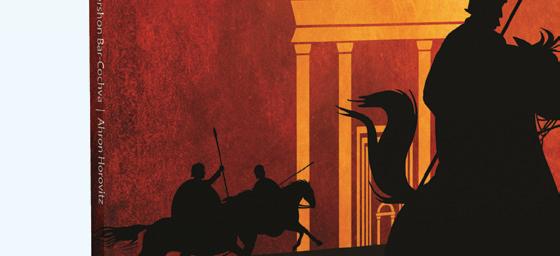







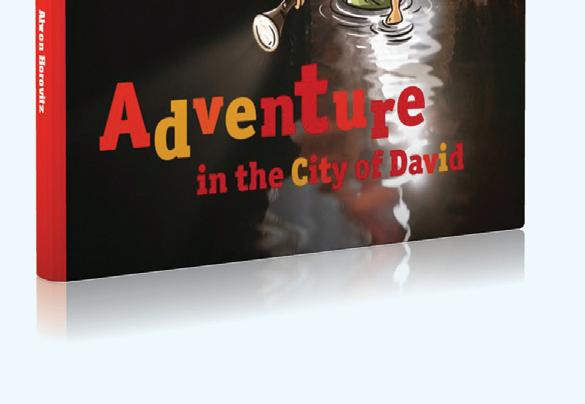




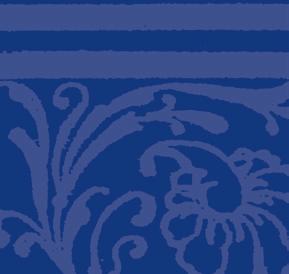




















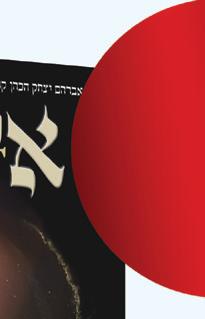
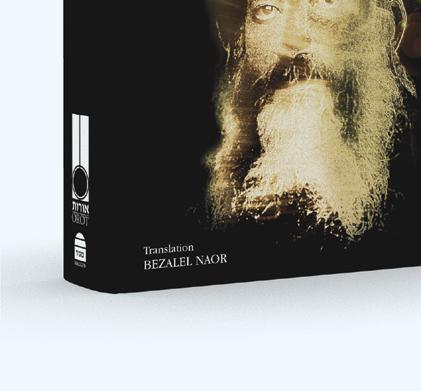




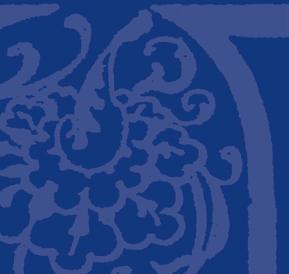

By Ari Z. Zivotofsky
Misconception: After childbirth, a woman’s husband should bentch Gomel on her behalf.
Fact: According to most authorities, a woman after childbirth should personally recite Birkat HaGomel.
Background: Birkat HaGomel is a blessing recited to thank God for His salvation after one safely emerges from a dangerous situation, of which one of the four prototypical examples is illness (Berachot 54b, as derived from Psalm 107). The text (SA, OC 219:2) of Birkat HaGomel is: “Baruch atah Hashem Elokeinu Melech Haolam hagomel1 lechayavim tovot shegamalani kol tov, Blessed . . . Who bestows good things upon the undeserving (or guilty)2 and Who has rewarded me with all3 manner of good.” The congregation then responds4 “Amen. May He Who bestowed goodness upon you continue to bestow every goodness upon you forever” (AH, OC 219:5). It is often viewed as a replacement for the korban todah (thanksgiving sacrifice), which at present cannot be offered.5
After recovering from illness, one is obligated to recite the HaGomel blessing (SA, OC 219:8), and although childbirth is a natural phenomenon and nowadays usually occurs safely, it is nevertheless an inherently dangerous event. Halachically, a woman in labor and three days postpartum is treated as a person in danger (SA, OC 330:1, 4).
Rabbi Dr. Ari Z. Zivotofsky is on the faculty of the Brain Science Program at Bar-Ilan University in Israel.
It would thus seem that a postpartum woman should recite the HaGomel blessing, and indeed many authorities maintain that this is so.
Yet other halachic authorities debate whether a woman is obligated to recite the HaGomel blessing. The debate largely stems from the traditions regarding how, when and where this blessing is recited. The custom is that men recite HaGomel in shul after getting an aliyah or at some point during the Reading of the Torah, because some maintain it should be said in the presence of a minyan (SA, OC 219:3). The Moroccan-Italian seventeenth-century Rabbi Yaakov Chagiz, in Shu”t Halachot Ketanot (2:16), suggests that if the presence of a minyan is indeed essential, maybe women should be exempt because “kol kevudah bat melech penimah” (Tehillim 45:14) and possibly they should recite Shehechiyanu instead. The contemporaneous seventeenth-century Turkish Knesset Hagedolah (Hagahot Beit Yosef 219) reports that indeed some women do not recite HaGomel, but he opines that this is an erroneous practice. He says that women are obligated in Birkat HaGomel, and the claim that they are too modest to recite it in front of ten men does not absolve them of their obligation. He suggests that they recite it from the women’s section of the synagogue when a minyan is present, and this would not infringe upon their modesty. The seventeenth-century Polish Magen Avraham (OC 219: intro-
duction) defends the custom of women not saying HaGomel by suggesting that the berachah is optional. The Peri Megadim (219:1) expresses surprise at that suggestion and insists that there is an obligation to acknowledge God’s benevolence.
This practice of women not reciting HaGomel is cited as “common” in nineteenth-century Eastern Europe by the Mishnah Berurah (219:3), although he, like others, was giving a descriptive rather than prescriptive statement. The Mishnah Berurah quotes other opinions that a woman should say it in front of ten people—nine women and one man.6 While the Mishnah Berurah did not explicitly offer his opinion,7 another nineteenth-century Eastern European giant did. The Aruch Hashulchan (OC 219:6) mentions that some have the custom of women not bentching Gomel and he insists that since there is no good reason for this, it is proper for women to recite it. The contemporaneous Lithuanian Chayei Adam (65:6) says that women should bentch Gomel in front of ten (presumably he means men, though he doesn’t state that).
Those authorities of the opinion that women should recite HaGomel were fully aware of the concerns about modesty and offered varied practical suggestions. The early twentieth-century Rabbi Yaakov Chaim Sofer (Kaf HaChaim 219:3, 7, 27), Rabbi Hillel Poisic (twentieth century; Hillel Omer 136, p. 86), Rabbi Raphael Baruch Toledano (Kitzur Shulchan Aruch Toledano 107:3, p. 255) and the late
twentieth-century Rabbi Shlomo Aviner (She’eilat Shlomo 2:87) all ruled that women should recite HaGomel, but may do so in front of ten relatives or friends. The Shulchan Aruch HaRav (Seder Birkat Hanehenin 13:3) states, like the Knesset Hagedolah, that women are obligated to say HaGomel, and therefore when a woman recovers from childbirth, she should recite the berachah in the women’s section such that ten men hear it. The Ben Ish Chai (Shanah Rishonah, Eikev: 5) goes further and states that women are obligated in Birkat HaGomel and if a woman does not know the berachah, her husband or someone else should teach it to her (since she is obligated).
Some authorities were adamant about a woman being obligated to recite Birkat HaGomel. Rabbi Yaakov Emden writes (Siddur Beit Yaakov, 112; Dinei Birkat HaGomel: 2) that women should not belittle this berachah, but should recite it while in the women’s section. If this is not feasible, they should recite it at home. He concludes that postpartum women are obligated and adds: “I do not know why and on what basis they are lenient about it.”
Rav Ovadia Yosef (Yechave Da’at 4:1415) rules like the Knesset Hagedolah and the Chida, that women are obligated and that the proper procedure is for them to recite the berachah from the ezrat nashim or at a home celebration for the newborn. He notes that nowadays, when women are accustomed to go out in the marketplace among men, there is less of a concern about tzeniut when a woman recites HaGomel in the presence of men. On the other hand, some authorities exempted women for a variety of reasons. Rabbi Mordechai Tzvi Halevi Horowitz in early twentieth-century Frankfurt says that in his city they stick to their traditions which, as the elderly righteous women told him, includes women not bentching Gomel and their husbands not reciting it on their behalf. He suggests that for a woman who was performing the mitzvah of bringing forth life, the language of “chayavim,” (guilty) is inappropriate (Mateh Levi 2:8) and that this would be true of anyone doing a mitzvah that involves danger.8 Shu”t Siach Yitzchak (OC 101)
quotes several sources who discourage women from reciting HaGomel due to postpartum bleeding which, according to some, restricts the recitation of berachot. Another potential explanation for an exemption is that since HaGomel is in lieu of the korban todah, it has to be recited in the daytime, transforming it into a time-bound mitzvah, from which women are generally exempt.9 In Aden (south Yemen) women did not bentch Gomel, and there was also no custom of the husband saying it on behalf of his wife (Otzar Minhagei Aden, 202).
In lieu of bentching Gomel, some suggest that a woman answer “Baruch Hashem haMevorach le’olam va’ed” and “Amen” to her husband’s aliyah to the Torah with the specific intent of fulfilling her obligation to thank Hashem (Minchat Yitzchak 4:11). This may be the source for the custom of a new mother coming to shul when she feels well enough, with her husband getting an aliyah (with regard to getting an aliyah, a new father is subordinate only to a chatan before his wedding and a bar mitzvah boy) (Biur Halachah 136:1, s.v. b’Shabbat).10
Because there were locales where the custom developed for women to not recite HaGomel, the question arose as to whether another person, such as a father (for an adult daughter) or a husband (for his wife) may recite this berachah. There are actually two issues that need to be examined with regard to this question: 1. May another person, e.g. a student, recite HaGomel because he is joyous about his teacher’s salvation, even when not in the beneficiary’s presence? 2. Can the recitation of the blessing by another person, e.g. a husband, fulfill one’s obligation? The gemara relates (Berachot 54b) that Rav Yehudah’s students recited a berachah of gratitude upon his recovery from an illness, to which he responded “Amen.” He then declared that he was now exempt from saying HaGomel. The Rosh (cited in Tur, OC 219) seems to rule, based on the story, that an individual can indeed say the berachah on another’s behalf, and if the obligated person responds “Amen,” he has thereby discharged his duty.
Commenting on this, the Beit Yosef (OC 219) cites the Rashba that this only applies to a rebbe and his student. He notes that a small number of husbands recite HaGomel on behalf of their postpartum wives and he rules that they should not do so. He goes on to say that husbands who do so should be rebuked. In an apparent contradiction, in the Shulchan Aruch, he rules (OC 219:4) that if another person said the berachah and the obligated party responded “Amen,” he has indeed fulfilled his obligation. The Rema adds a note that it is not a blessing in vain.11 The Kaf HaChaim (219:33) insists (Biur Halachah disagrees) that the Mechaber did not change his mind. He felt, as he wrote in the Beit Yosef, that one should not recite Birkat HaGomel on behalf of someone else but nevertheless, if one does so, the obligation is fulfilled.
The Mishnah Berurah (219:17), based on the Magen Avraham (219:4), elaborates on the Rema, and says that a joyous friend may recite the berachah, even if the person who was saved is not present, and certainly a husband can do so for a wife because “ishto k’gufo, ” “a man’s wife is like his body.” Obviously, this custom does not resolve the issue for unmarried women who may have an obligation to recite HaGomel. The Mishnah Berurah (in Biur Halachah 219, s.v. “v’ain”) says that the majority opinion is that only a student can fulfill the obligation for a rebbe or a son for a father. He does not seem to accept a husband saying it on behalf of his wife, despite the principle of ishto k’gufo.
The Aruch Hashulchan (219:9) accepts that a husband can recite the berachah for his postpartum wife because “there is no greater love than a husband for a wife”; nonetheless, he attests that it is not the accepted practice, and as noted above, he opines that a woman is obligated to recite HaGomel. Rabbi Chaim Kanievsky (Shoneh Halachot 219:1, 4) rules that a husband should not recite HaGomel for his wife, even though he observes that the custom today is for women not to say it. He does mention that there are those who recommend that a woman say it in front of ten people.
Rav Moshe Sternbuch (Teshuvot V’Hanhagot 1:195) relates that the
Chazon Ish did not agree that women should bentch Gomel (see Orchot Rabbeinu 2:103, p. 91). However, Rav Sternbuch says that it is appropriate that women thank God for His mercies and the custom in Yerushalayim, including among the congregants in his shul (despite what the Chazon Ish said), is that they do say it, either in the ezrat nashim or at home. A hundred years earlier, Rav Yosef Chaim Sonnenfeld (Salmat Chaim 136 or Shu”t Salmat Chaim 198) discusses whether a postpartum woman should bentch Gomel after seven days or wait until after thirty, with no mention of the idea that a woman not bentch. Rabbi Shlomo Zalman Auerbach (Halichot Shlomo 23:4 and note 10) states that the Jerusalem custom was for a postpartum woman to bentch Gomel; he also emphatically states that the husband should not recite it on her behalf. Rabbi Eliezer Waldenberg (Tzitz Eliezer 13:17) notes that in Jerusalem, a postpartum woman recites HaGomel when a minyan is assembled in her house for Maariv.
The author of Bishvilei Birkat Hagomel (Rabbi Simcha Bunim Lieberman, 5758), an entire book on Birkat HaGomel, summarizes this topic as follows: “I have examined the Acharonim and the overwhelming majority hold that a woman should bentch Gomel.”12
The Aruch Hashulchan (OC 219:2-4) explains that both individually and as a nation, our existence is dependent upon God’s miraculous sustenance of the world. These “miracles” are generally divided into two categories: those that openly defy nature, like the Exodus from Egypt and upon which the berachah “She’asah nissim” should be recited (see OC 218), and those that appear to be natural, like earning a livelihood, for which no special berachah is recited but thanks is given in the daily prayers. There is also a middle ground whereby an event appears to unfold naturally but includes a subtle miraculous element (for example, childbirth). A berachah over a miracle cannot be recited, but a special berachah, HaGomel, is warranted to thank God for His granting the undeserved salvation.
A basic principle of Judaism is hakarat hatov, recognizing the good that one receives. Thus, if a woman is the beneficiary of God’s goodness, most authorities rule that she should personally thank Him. Rav Moshe Feinstein, in the last response he wrote in his own handwriting (Iggerot Moshe, OC 5:14), states: “There is no place and no reason to distinguish between a man and a woman regarding the obligation of a berachah of thanksgiving.” This seems to be the most popular approach among the posekim, who suggest that women say it either in shul or at home. For the most part, those who disagree exempt women altogether. Many authorities view a husband’s recitation of HaGomel on behalf of his wife as problematic, although there is a minority opinion that does not object to it.
Notes
1. The Gra prefers the Rif’s text of “gomel,” rather than Rambam’s “haGomel.”
2. Although not found in the Talmudic text, the phrase “undeserving” is found in the main Rishonim. Its meaning is explained in the Beit Yosef (OC 219, s.v. “mai”), Shu”t Maharam Mintz 14 and Avnei Nezer, OC 39 and might have ramifications for this topic (see Har Tzvi, OC 1:113). On the text and other aspects of the berachah, see Encyclopedia Talmudit, vol. 4, entry on Birkat HaGomel (pp. 316-321).
3. Rabbi Shlomo Zalman Auerbach felt that the word “kol” should be removed from the berachah but not from the end of the response (Halichot Shlomo 23:7).
4. Even if they do not respond, one fulfills the mitzvah (MB 219:5).
5. Vayikra 7:12; Rosh, Berachot, chap. 9, sec. 3; Tur, OC 219. Based on this connection, Birkat HaGomel is preferably recited during the day (Kaf HaChaim, OC 219:14; Shu”t Chatam Sofer, OC 51; Tzitz Eliezer 13:17). For a discussion regarding why it can be recited on Shabbat while a voluntary tefillah may not, see Shu”t Maharam Schick, OC 88. See Chanoch Goldberg, “Chovat nashim l’vareich Birkat HaGomel,” Shana B’shana (5750), 231239, for an elaboration on this topic.
6. The rationale for this position is that the purpose of the blessing, as a substitute for the korban todah, is to publicly thank God; thus there is no need for a technical minyan as needed for a davar sheb’kedushah, merely an
assembly of people for which women count as well. The reason for the requirement of one man is not clear. See Rabbi Aryeh Frimer, “Women and Minyan,” Tradition 23:4 (Summer 1988): 54-77, especially 63-64. See Rabbi Yehuda Herzl Henkin, Bnei Banim 5, on why others say that specifically a minyan is needed and why he thinks there may be a difference in the make-up of the quorum for a postpartum woman as opposed to individuals in other circumstances.
Not all posekim accept the Mishnah Berurah’s suggestion. Rav Shlomo Zalman Auerbach (Halichot Shlomo 23:4, note gimmel) says that even though in Yerushalayim on Purim Meshulush the megillah is read for ten women with a berachah, for Birkat HaGomel that is not the practice. So too, Rav Moshe Feinstein (Iggerot Moshe, OC 5:14) says there is no point in reciting HaGomel in the presence of ten women and it is fine if said in front of even one individual, male or female; if the woman is married, it should be recited in front of her husband.
7. Some understand the Mishnah Berurah to prefer the position that a woman recite it in the presence of ten men (Torah Lodaas 15:25 [Tzav, 1991]).
8. This does not explain why women in other circumstances did not bentch Gomel. And it would mean that Israeli soldiers returning from miluim or the front would not bentch Gomel, which they indeed do (see Rav Nachum Eliezer Rabinovitch, Shu”t Siach Nachum: 13).
9. This explanation is rejected by most authorities. See Chatam Sofer, OC 51; Shu”t Maharam Schick, OC 88.
10. Note this is distinct from the custom, not as widespread today as it once was, of a man receiving an aliyah on day forty or eighty following the birth of a son or daughter, respectively.
11. On the text to use when making the berachah for someone else, see Taz 219:3, MB 219:17 and Sha’ar Hatziyun 219:13.
12. In a bizarre twist, he then spends several pages trying to find a reason why women should not say it and concludes that while it is dependent on local custom, “our” people, i.e., Polish and Lithuanian Jews, do not have the custom of postpartum women bentching Gomel.


ike many contemporary Jews, I approach Tishah B’Av with difficulty.
Not because of the myriad restrictions in the Three Weeks, the mourning period that precedes the saddest day on the Jewish calendar, but because of the holiday’s spiritual significance, which can seem far removed from our contemporary lives.
I do Tishah B’Av every year. I fast then and on the Seventeenth of Tammuz; I don’t take a shaver to my face for three weeks; I eschew meat for the Nine Days starting with Rosh Chodesh Av; I don’t do laundry, et cetera.
But for a long time, I didn’t get Tishah B’Av. I found the concept of mourning for an ancient destroyed building, of yearning for the restoration of the Torah’s system of korbanot (sacrifices), of sitting on the floor chanting Eichah (Lamentations), hard to understand. These practices seemed forced or foreign at best, irrelevant at worst.
How did this make me a better Jew?
A rabbi I know offered a suggestion. “Think of the most spiritual experience you ever had in your life. Multiply that by a thousand. That was what happened in the Temple. That is what we’re missing.”
My most spiritual experience: In Jerusalem in 1991, a friend and I walked the streets after dinner one Friday night. We met a man outfitted in a white-and-gray-striped silk caftan, with a shtreimel atop his head and a black gartel around his waist. Aharon Wallis—Reb Aharon—of the anti-Zionist Toldos Aharon Chassidic group, in his thirties, father of six children, joined my friend and me for two hours, giving us a personal tour of Mea Shearim, greeting his friends, telling us about his life as a fifth-generation Jerusalem-born Chareidi Jew, asking about our lives in the US.
He invited us to a Shabbat meal at his home in Mea Shearim. One Friday night I went alone. I shared a delightful meal with Reb Aharon and his wife and their growing brood of small children, most of them sons. I stumbled over my German-cum-Yiddish and fledgling Hebrew, inquiring about the lifestyle of their corner of the Chareidi velt, engaging in the divrei Torah and related subjects that are standard fare at any Shabbat meal.
After the meal, warmed by the servings of chicken soup and kugel, I wandered by myself onto the family’s small, unlit balcony for some fresh air. As is my habit on Shabbat, I started humming a niggun, “Ko Amar, ” to myself. Within
Steve Lipman is a frequent contributor
seconds, a few of Reb Aharon’s sons, and maybe some young cousins—all pre-bar mitzvah age—came onto the mirpeset. They instinctively took my hands and started humming along, dancing for several minutes in a tight circle. They, kids with shoulder-length peyot and pointed white-knit yarmulkes on their heads; I, clean-shaven, with a brown suede kippa.
That’s what I think about every year on Tishah B’Av. That was the most spiritual experience of my life, an example of unbridled, borderless, open-hearted ahavat Yisrael. If the Temple experience was 1,000 times stronger than that, I can join in the mourning.
Last year, I added another Tishah B’Av memory.
The day before the fast, in the waning days of the monthlong war between Israel and Hamas terrorists in Gaza, a Palestinian Arab from East Jerusalem commandeered a tractor, steering it into a crowd of Jews and overturning a bus on Shmuel HaNavi Street.
Six persons were injured, one was killed: Rabbi Avrohom Wallis, from Toldos Aharon, a twenty-nine-year-old father of five who worked in a cousin’s tzitzit shop and had agreed to replace a friend as a volunteer for the Asra Kadisha organization that prevents desecration of gravesites. He was at a construction site, killed while making sure no graves at the site were damaged during the work.
Was he one of the young guests at the Wallis table that night in 1991—one of the boys on the mirpeset? His father’s name was Shimon, so he clearly was not a son of my Reb Aharon.
But I felt that I knew Avrohom Wallis. He was kin to the boys who had grabbed my hands. All the Toldos Aharon Wallises are related to each other, friends in the know in Israel tell me.
The Wallis loss was mine.
On Tishah B’Av, we mourn the tragedy of the two Temples that fell on the Ninth Day of Av, and other calamitous events that have taken place in Jewish history over the centuries during the Three Weeks.
In future years, on future Tishah B’Avs, I will think about the spiritual high I experienced on a Mea Shearim balcony. And about the loss to Klal Israel of an innocent Jew who died too young at the hands of modern-day hatred on erev Tishah B’Av.
Now, in an awful way, Tishah B’Av is even more personal. Now, tragically, it is easy for me to “get” Tishah B’Av. g


